Brilliant
rilliant














kl summer displays
sparkling
EXPERT’S CHOICE
hollyhocks

All the buzz giving wild bees a home
how best to give an old garden fresh purpose

magical
DESIGN DETAIL
f
B
ll t
9BEST OUTDOOR KITCHENS PLANTING IDEAS • BEAUTIFUL GARDENS • EXPERT ADVICE




Much of gardening is about listening. In doing so we can tune in to our surroundings and better understand what’s needed – be that whether we can hear the buzz of insects or the chirrup of birds, or listening to our own sensibilities and understanding what we might need to do to improve our wellbeing.

It’s also about garden designers listening to their clients and envisioning how a garden space might best be used. Designers Gavin McWilliam and Andrew Wilson were tasked with enlivening a tired 1960s garden for new owners. They wanted family space but also a greenhouse, kitchen garden and more manageable planting. On page 104, we drill down into the design decisions and considerations that were put in place to bring this garden back to life.
We also share an extract (see page 92) from the recently published book Meadow in which Iain Parkinson gathers together different voices from the world of meadow expertise and conservation. It is a timely reminder of how we should listen to those who have dedicated so much time to their cause, and for us to understand more about such precious resources and how to care for and indeed save them.
And bringing us back to the buzz of insect life in our gardens, we visit craftsman Matt Somerville who is a passionate advocate for our wild bee populations and is making suitably natural hives for swarms to find and use as their own homes. Find out more on page 78.

Here’s your invitation to tune in and enjoy the issue.
Website gardensillustrated.com
Instagram @gardens_illustrated
Twitter @GdnsIllustrated
Facebook @gardensillustrated


Welcome
ANDREW MONTGOMERY
Matt Somerville’s characterful beehives look wonderful and offer bees a more natural home, page 78.
STEPHANIE MAHON, EDITOR
JOHN CAMPBELL
JULY 2022 GARDENSILLUSTRATED.COM 3
�ontents
Places
32 Close and personal James Alexander-Sinclair has provided the owners of an old rectory garden with fabulous views, alongside plenty to keep their focus closer to home
46 Levelling up Modernist hard landscaping and soft grasses combine to create an immersive feel and disguise the changes in level of a small, city garden
62 Jungle giants Plant adventurer Jack Salway has created his own tropical paradise in his enclosed Surrey garden
66 The secret garden Using reclaimed materials and clever planting, Tom and Jenny Williams have revived the historic walled garden of their home in Wales

72 Growing together The garden of Abi and Tom Attwood provides an artful backdrop to their beautiful Cumbrian nursery
84 Middle ground In hot and dry central Spain, designer Fernando Martos has created a lush garden that requires minimal irrigation
Plants
20 Plantsperson’s favourites Gravetye Manor’s head gardener Tom Coward chooses his top ten plants for July
40 The heat is on Jenny Barnes suggests three very different container ideas for bringing colour to high-summer pots
52 Plant profile: Alcea Garden maker and flower grower Becky Crowley chooses the best of her favourite hollyhocks
92 Nature reserve In this edited extract from his new book, Meadow, writer Iain Parkinson shares the reflections of some of those who are helping to preserve the nation’s meadows
People
31 Gardening talent Meet self-employed topiarist James Todman
60 Who’s who Vanessa Easlea, chair of the WFGA, on the delights and dilemmas of starting over in gardening
78 Living the hive life Matt Somerville’s freedom log hives are designed to let bees be free
130 A new beginning In her new monthly column, gardener Alice Vincent shares the journey of creating a garden
Design
99 Design update Including news of a proposed floating garden pier in Seoul
104 New ideas The design solutions that have transformed the tired garden of a 1960s house
113 Sourcebook Nine of the best outdoor kitchens
Regulars
3 Welcome
6 Contributors
11 Dig in This month: news of an art exhibition at Wakehurst and a new scheme to transform some of London’s parks 17 Kitted out for creating the ultimate edible garden
JULY 2022
BRITT WILLOUGHBY DYER
of
The
Benjamin
sets out the
jobs to
looks great all year
Books
books on
of
and back issues
4 GARDENSILLUSTRATED.COM JULY 2022
26 Subscription offer Save when you subscribe to the digital edition
Gardens Illustrated 28
constant gardener
Pope
essential July
ensure your garden
117
New
unearthing a passion for growing and the flowers
Chile 123 Crossword
129 Next issue What’s coming up in our August issue
“Unbridled abundance” is how designer James Alexander-Sinclair describes the exuberant planting he created for this Northamptonshire old rectory, page 32.
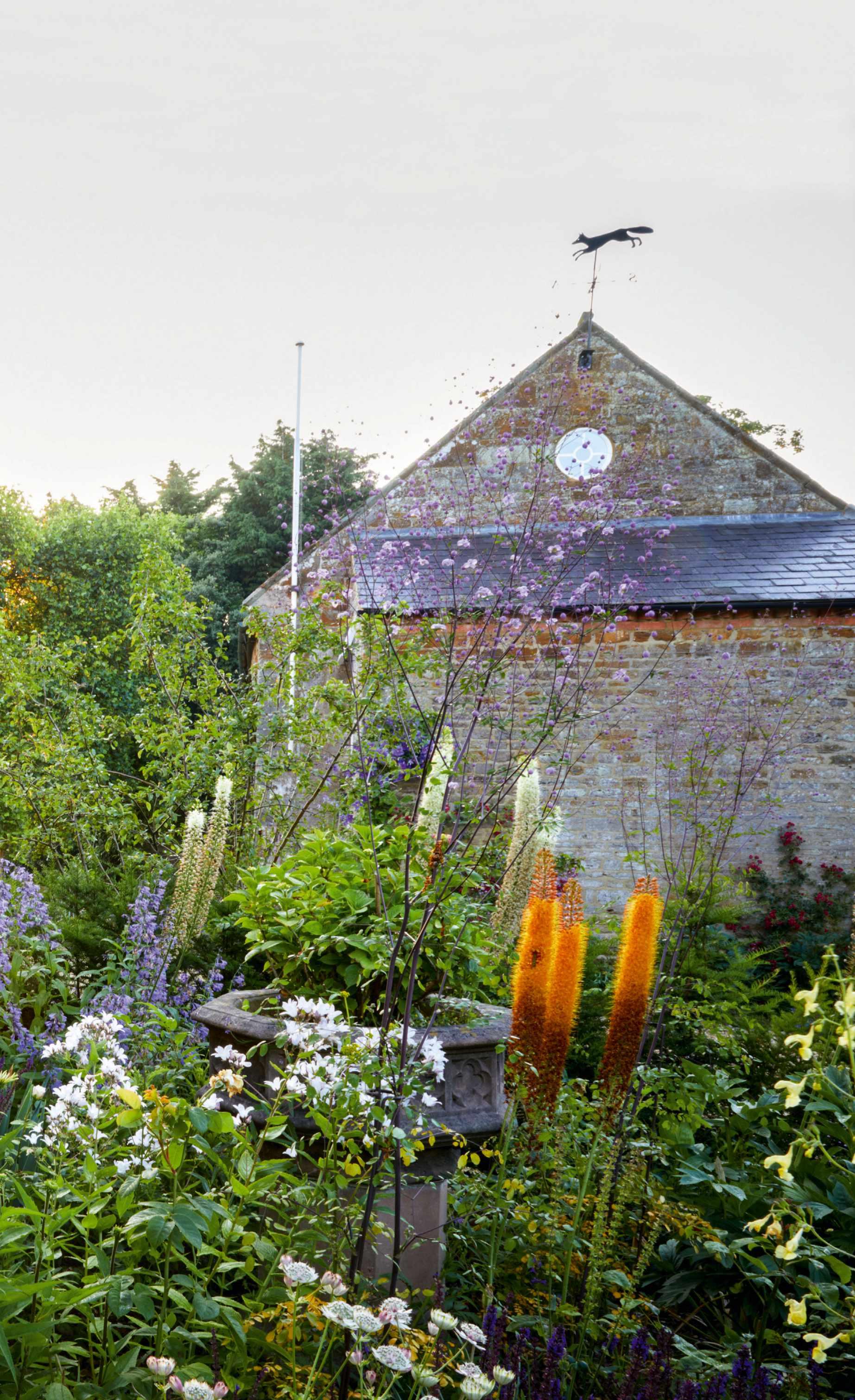
Subscribe & save
out a digital subscription to Gardens Illustrated
SEE PAGE 26
COV E R I M AGE COVER IMAGE
Alcea rosea ‘Halo Candy’
by Annaïck Guitteny
ON T H E COV E R ON THE COVER
Brilliant planting, pages 32, 40, 46, 62, 66, 72, 84
Magical hollyhocks, page 52
All the buzz, page 78
Design detail, page 104
Outdoor kitchens, page 113
EV E EVE N T S A N D NTS AND OFFE R S OFFERS
• Join us on our four-day tour of the most beautiful gardens in the Lake District – page 8
• Save money when you subscribe to the digital edition of Gardens Illustrated – page 26
• Win a VIP trip to Orticolario, one of Italy’s premier gardening events on the shores of Lake Como† – page 124
†Competition open to UK readers only
Our packaging
Subscriber copies of Gardens Illustrated are now delivered in paper wrapping instead of recyclable plastic polywrap. This paper wrap is 100% recyclable and made from sustainably sourced paper. Please recycle in your kerbside recycling bin. We would love to hear your feedback, please contact us at paperwrap@immediate.co.uk
take
Design:LouisaSavage
GARDENDESIGN TRAININGFOR PROFESSIONALS

Findoutmoreaboutour inspirationaltrainingatRoyal BotanicGardensKew,RHSGarden Wisleyandonline.
Contributors
Flower grower Becky explores the many variations of a cottage garden favourite, page 52. “It has been fascinating to study more closely one of my very favourite flowers: the hollyhock.”
Joe photographs a beautiful walled garden in Wales, page 66. “It’s always a joy to photograph Tom and Jenny’s peaceful garden, with its rich and beautifully romantic planting.”
Alice begins a new monthly column on creating a garden from scratch, page 130. “This column feels like a new garden: I can’t wait to dig in, sow seeds and watch it grow.”
CONTRIBUTING EDITORS
OurDiplomaandProfessional Developmentprogrammesare availableonlineinreal-timeclassesas wellasatourhomeinRoyalBotanic GardensKew.In2022wealsohave shortcoursesforprofessionalsand gardenenthusiastsatRHSWisley Garden,DenmansGardenandonline.
Visitourwebsite lcgd.org.uk tohear howourstudentsarecreating successfulgardendesigncareersand discoveranever-changingrangeof coursesforthegardenenthusiast.
James Basson
James lives in the South of France where he runs Scape Design, a practice specialising in low-maintenance and dry gardens. He is a fervent advocate for creating sustainable landscapes. The winner of four Chelsea Gold medals, he was awarded Best in Show in 2017.



Fergus Garrett
Fergus was appointed head gardener at Great Dixter by Christopher Lloyd in 1993. He is passionate about passing on his knowledge through student programmes at Dixter and worldwide lectures. He was awarded an RHS Associate of Honour in 2008 and an RHS Victoria Medal of Honour in 2019.
Anna Pavord
Anna’s books include her bestseller The Tulip and most recently Landskipping. For 30 years she was The Independent ’s gardening correspondent. In 2000 the RHS awarded her the Veitch Memorial Medal. She lives and gardens in Dorset.

Dan Pearson
Dan is one of the UK’s best-known garden designers, familiar to many through his gardening columns in the Observer magazine. Eight of his gardens, including the Tokachi Millennium Forest in Japan, have won awards and he was awarded Best in Show for his garden at Chelsea in 2015.
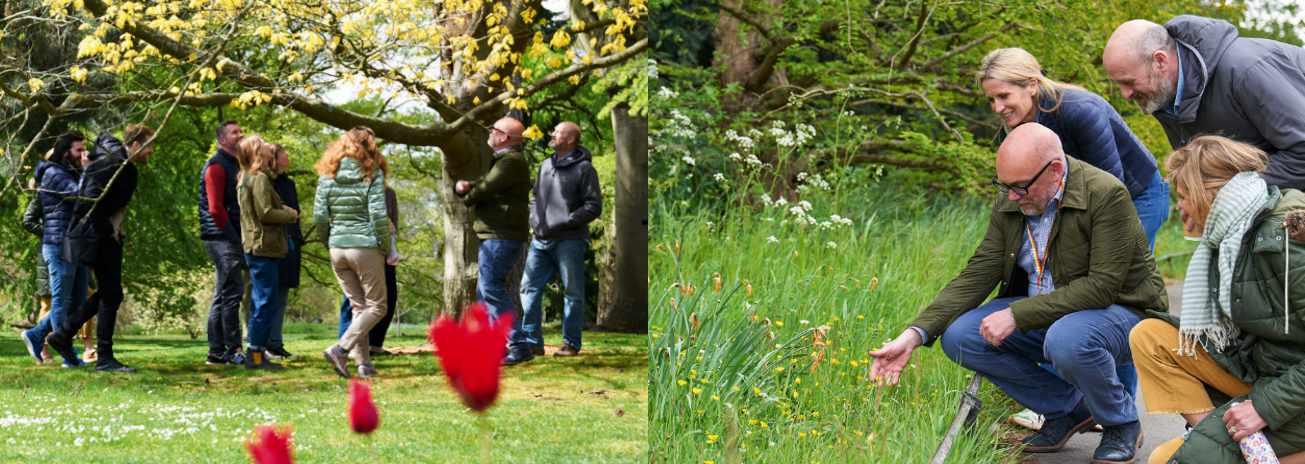

Sarah Price
Sarah is one of the UK’s most sought-after garden designers who gained worldwide recognition for her designs for the 2012 London Olympic Park. She won Gold at Chelsea in 2012 and 2018, and was GMG Garden Columnist of the Year in 2016 for her design series in Gardens Illustrated



ANDREW MONTGOMERY ANDREW
MONTGOMERY
+44(0)1483762955info@lcgd.org.uk
Becky Crowley
Alice Vincent
LYDIA GOLDBLATT
Joe Wainwright
ANDREW MONTGOMERY
GA R DENS

HOW TO GET IN TOUCH WITH US TOUCH
Subscription enquiries and back issues
UK 03330 162114
USA/CANADA 1 866 464 8103 (TOLL-FREE)
REST OF THE WORLD +44 1604 973722
UK buysubscriptions.com/contact buysubscriptions.com/gardensillustrated
USA/CANADA GILcustserv@cdsfulfillment.com, britsubs.com/garden

UK/REST OF THE WORLD Gardens Illustrated, PO Box 3320, 3 Queensbridge, Northampton NN4 7BF.
USA/CANADA Gardens Illustrated, PO BOX 37495, Boone, IA 50037-0495 USA.
Advertising enquiries
+44 (0)117 300 8805 heather.golden@ourmedia.co.uk
Editorial enquiries
+44 (0)117 300 8622 gardens@gardensillustrated.com
Gardens Illustrated, Our Media Ltd (an Immediate Group Company), Eagle House, Bristol BS1 4ST.
Syndication & Licensing
Gardens Illustrated is available for licensing and syndication. +44 (0)117 300 8787 emma.brunt@ourmedia.co.uk
App support
For App support please visit apps.immediate.co.uk/support
We abide by IPSO’s rules and regulations. To give feedback about our magazines, please visit ourmedia.co.uk, email editorialcomplaints@immediate.co.uk or write to Katherine Conlon, Our Media Ltd (an Immediate Group Company), Eagle House, Bristol BS1 4ST.

MAGAZINE CONTACTS
EDITORIAL
Editor Stephanie Mahon
Deputy editor Sorrel Everton
Art director David Grenham
Deputy art editor Niki Goss
Production editor Juliet Giles
Digital editor Daisy Bowie-Sell
Commissioning content editor Veronica Peerless
Editorial and digital assistant Molly Blair
Botanical adviser Dr James Compton
Thanks this issue Katriel Costello, Jodie Jones, Rosemary Smith, Rosanna Morris, Abigail Whyte
ADVERTISING
Group advertising manager Laura Jones 0117 300 8509 laura.jones@ourmedia.co.uk


Advertising manager Heather Golden 0117 300 8805 heather.golden@ourmedia.co.uk
Business development manager Sophie Keenan 0117 300 8804 sophie.keenan@ourmedia.co.uk
Brand sales executive Olivia King 0117 300 8809 olivia.king@ourmedia.co.uk
Brand sales executive Mica Enwright 0117 300 8756 mica.enwright@ourmedia.co.uk
Advertising designer Parvin Sepehr
INSERTS
Laurence Robertson +353 (0)876 902208
CIRCULATION, MARKETING, PROMOTIONS, PRESS & PR
Newstrade manager John Lawton
Subscriptions director Jacky Perales-Morris
Direct marketing manager Aimee Rhymer
Buyer Karen Flannigan
PR & Outreach Manager for Comms Emma Cooney emma.cooney@ourmedia.co.uk
MANAGEMENT
Chief executive officer Tom Bureau
Group managing director Our Media Andy Marshall
Managing director Our Media Marie Davies
Head of brand marketing Rosa Sherwood
Publishing assistant Lara Von Weber
SYNDICATION & LICENSING
Director of licensing & syndication Tim Hudson
PRODUCTION
Production director Sarah Powell
Group production manager Louisa Molter
Production co-ordinator Georgia Tolley
Jan-Dec 2021 49,146* *Combined print and digital sales Time to change trousers? Genus trousers are here for long days of graft in the garden. Your secateurs will be at hand in stab-proof pockets, whilst waterproof kneepads and technical fabrics will keep you comfortable for longer. www.genus.gs • 0203 617 1166 ® The Royal Horticultural Society. The Royal Horticultural Society, and its logo, are trade marks of The Royal Horticultural Society (Registered Charity No 222879/SC038262) and used under licence from RHS Enterprises Limited. www.andrewkaysculpture.co.uk 07740 306412 Free UK delivery LIFE SIZE ANIMAL SCULPTURE
Standard subscription rates: UK £64.87 per annum; Eire and Europe �79 for 13 issues; rest of the world US$112 for 13 issues. Distribution Frontline, Peterborough. US distribution Source IPD/Speedimpex. Email intlquery@seymour.co.uk Printed in the UK by William Gibbons Ltd. Gardens Illustrated (ISSN 0968-8920) (USPS 015-608) is published 13 times a year (monthly with a Summer issue in June) by Our Media Ltd (an Immediate Group Company), Eagle House, Bristol BS1 4ST, UK. Distributed in the USA by NPS Media Group, 2 Corporate Drive, Ste. 945, Shelton, CT 06484. Periodical postage paid at Shelton, CT and additional mailing offices. POSTMASTER: Send address changes to Gardens Illustrated PO Box 37495, Boone, IA 50037-0495. Unsolicited manuscripts, artwork or transparencies are accepted on the understanding that the publishers incur no liability for their storage or return. The contents of this magazine are fully protected by copyright and may not be reproduced without permission. The Gardens Illustrated cover is printed on 250gsm FSC Amadeus produced in Belgium by Burgo. The Immediate Media Company Limited is working to ensure that all of its paper is sourced from well-managed forests. This magazine can be recycled for use in newspapers and packaging. Please remove any gifts, samples or wrapping and dispose of it at your local collection point. All prices are correct at time of going to press. © Our Media Ltd (an Immediate Group Company) 2022. Member of the Audit Bureau of Circulation. ISSN 0968-8920.
THIS MAGAZ NE IS OWNED MAGAZINE AND PUBLISHED BY
Chapelside.
TOUR GI Reader
The Lakeland Collection
This tour in the Lake District takes in a contrasting range of gardens in dramatic landscapes, including a small plot among the fells, and the home of garden designer Arabella Lennox-Boyd

The tour starts with a visit to Holker Hall and its 24-acre garden, comprising yew hedging, rose garden and woodland with conifers from around the world. We travel on to The Lakeside Hotel on the southern shore of lake Windermere, our base for three nights. We’ll also visit Levens Hall, which has the most famous topiary garden in England, installed between 1689 and 1712 by the Frenchman Guillaume Beaumont, gardener to King James II. There will be lots to see in the garden at Yewbarrow House overlooking Morecambe Bay, which has a walled kitchen garden, an Italian garden, gravel garden and sculpture garden, and we will also take a look at Dan Pearson’s recent project at Lowther Castle, where his design has reinterpreted the historic gardens. We visit the fell-side garden at Chapelside, on the lower slopes of Raven Crag, as well as Abi & Tom’s Garden Plants on a stunning site adjacent to Halecat House on the Witherslack Estate. The tour concludes with Gresgarth Hall Gardens where designer Arabella Lennox-Boyd has created an exciting garden, beautifully marrying the best of her native Italian style with British plantsmanship.
27 30 SEPTEMBER 2022
EVENT DETAILS
Price per person based on two people sharing is £2,650 (a single supplement of £250 is levied by the hotel).
Price includes: bed and breakfast at The Lakeside Hotel on the shores of Windermere for the duration of the tour; three evening meals with wine at the hotel and four lunches; all transportation from Lancaster railway station. It does not include hotel extras or travel insurance. For more details and for an in-depth itinerary with details of day-to-day visits, meals etc, please contact Boxwood Tours.
FOR INFORMATION AND BOOKING, PLEASE CONTACT
Boxwood Tours, 1 West Street, Buckingham HK18 1HL, UK. Tel +44 (0)1341 241717. Email mail@boxwoodtours.co.uk
Website boxwoodtours.co.uk
The tour has been arranged exclusively for readers of Gardens
Illustrated by Boxwood Tours Quality Garden Holidays, a specialist garden tour company set up in 1990. Please note that itineraries may be subject to change for reasons beyond Gardens Illustrated’s control. The tour is financially protected by the ATOL scheme. Please see booking conditions for further information or for more information about financial protection and the ATOL Certificate go to: arenatravel.com/why-arena/financial-protection
PORTRAIT IRENE COOPER; CLAIRE TAKACS
Lowther Castle & Gardens.
8 GARDENSILLUSTRATED.COM JULY 2022
Tom Attwood is a Kew-trained horticulturist and a contributor to Gardens Illustrated. With his wife Abi, he runs Abi & Tom’s Garden Plants and manages the gardens of the Witherslack Estate in the Lake District.


Metal Pergolas by London Stone

Add a new dimension to your garden
·In stock and available for FREE next day delivery
·Choose from four size and colour options, with or without sides
·From just £1,109.39 + VAT
5% off your pergola!
Exclusive Gardens Illustrated Reader Offer – use code ‘GARDENS5’ for
DIG IN
What’s new, what’s growing and what’s going on this month
World of art
A day out at Wakehurst, Kew’s wild botanic garden in Sussex, is an opportunity to see a world of different habitats as varied as an American Prairie and Wetlands to a Himalayan Glade. This summer there is also the chance to explore the future of plants and food in worldwide communities through a programme of events entitled Nourish. Foremost are five newly commissioned outdoor art installations, specially created in response to Kew Science research projects. Among these is UK Young Arts of the Year nominee Malgorzata Lisiecka’s reflection on the power of fungi with a 3D interactive sculpture (top left). A large-scale installation from Flea Folly Architects, The False Banana Pavilion (left), uses the African wild banana relative, Ensete ventricosum, to highlight its possible use as a climate-smart crop of the future, while artist John Grade, whose previous installations include Reservoir (top right), is creating a large, suspended sculpture that rises and falls in response to rainfall and is inspired by the high-altitude Páramo ecosystem of the Colombian Andes. Until 18 September, 10am-6pm (After Hours 11-14 and 18-21 August, 6-9pm, booking essential). Entry from £14.95. kew.org/wakehurst

JULY 2022 GARDENSILLUSTRATED.COM 11
JOHN GRADE, RBG KEW,
News
COMPILED BY MOLLY BLAIR
PETAL POWER

Just as the wedding season hits its summer peak, here’s an uplifting opportunity to peek inside the fields of a Shropshire-based flower farm to see the delphiniums, cornflowers, sunflowers, calendula and wildflowers that go into making its petal confetti. Shropshire Petals, a fourth-generation family run flower farm, near Newport in Shropshire, grows flowers for drying, and to create its colourful, natural, completely biodegradable and eco-friendly confetti. This year it’s throwing open its fields for a festival of flowers that will offer the chance to stroll among the blooms to see them growing at their peak, as well as enjoy good food, some family-friendly activities and the opportunity to buy your own freshly cut flower bouquet. 5-14 August, tickets cost £9.95. shropshireflowerfield.co.uk
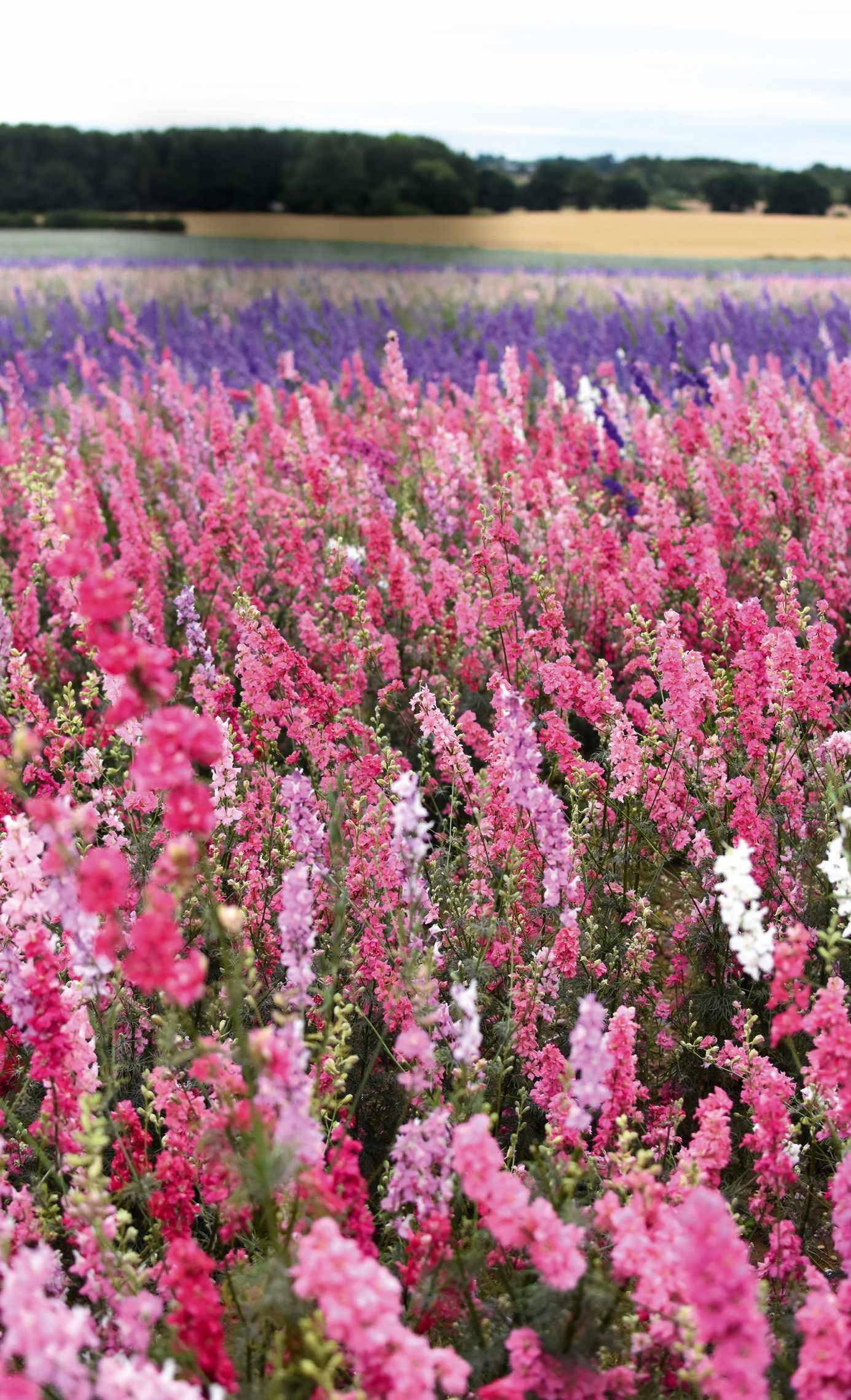
OPENING OUT
Historic, Grade I-listed Crook Hall and Gardens, with its magnificent views over the city of Durham, has been acquired by the National Trust. Forced to close as a venue as a result of Covid, the Trust is keen to welcome visitors back to explore the property’s rich history and its ten acres of gardens. Mostly laid out in the 20th century, the gardens feature formal areas with neat topiary hedges alongside areas of cottage garden filled with roses, wisteria and perennials, as well as a vegetable garden, a paddock and a wooded glade. nationaltrust.org.uk

Thriving park life
As the custodian of 5,000 acres of parkland across London, The Royal Parks is a key player in helping the capital adapt to climate change. Now thanks to funding from the People’s Lottery Fund, its long-term initiative, Help Nature Thrive, is getting underway with a series of public events including a butterfly walk and birdwatching tours, to highlight some of the projects set to transform the parks into a more biodiverse landscape. royalparks.org.uk


THE ROYAL PARKE,, NATIONAL TRUST COLIN DAVISON, CHARLOTTE PARTON
On course for success
When Charlotte Parton moved to a smallholding in Devon, she was determined to grow healthy food sustainably. She set about equipping herself with a range of skills in techniques from permaculture and biodynamics to companion planting and the no-dig method. Now with an MSc in Sustainable Food And Natural Resources under her belt, she’s passing on her expert knowledge with a series of courses, including how to design and create your own potager garden, starting a sustainable garden, growing super foods, and how to make your own cider and cider vinegar. All are taught in her own beautiful garden, with prices starting at £95. thesustainablegarden.com
3 FOR THE GARDEN… BIRD BATHS
CLASSIC Georgian Bird Bath, £399, Haddonstone, 01604 770711, haddonstone com


Down the garden path
Beady-eyed readers may have spotted illustrator Alice Pattullo’s name popping up in these pages over the past few years, including on our new column (page 130). She’s also now created a wallpaper collection for Hamilton Weston. The three nature-inspired designs – Arboretum, Arcadia and Pathways (pictured), which is inspired by childhood memories of her parents’ allotment – are all available in a range of colourways, with prices starting at £195 for a 10m roll. hamiltonweston.com

MODERN
Reiko Kaneko Birdbath £185 Ishinomaki Laboratory 020 7739 1869 scp co uk

WILDLIFE HAVEN
Nature Oasis Bird Bath and Drinker £22, RSPB, 0345 034 7733, shopping.rspb.org.uk

JULY 2022 GARDENSILLUSTRATED.COM 13
DIARY: JULY
COMPILED BY MOLLY BLAIR AND ANNIE GATTI
1 Creative with Batik – Rebecca Mason
Admire artworks from batik artist Rebecca Mason in the tearoom at Stillingfleet Lodge Gardens before exploring the extensive gardens that include a meadow garden, rill garden and plant nursery. Rebecca’s artworks, all of which are available to buy, are inspired by the plant life of the Yorkshire countryside. Until 31 July. Weekdays 1-5pm. Exhibition included in garden entry, £6. Stillingfleet Lodge Garden and Nurseries, Stewart Lane, Stillingfleet, York YO19 6HP. Tel 01904 728506, stillingfleetlodgenurseries.co.uk
2 Festival of the Garden
Don’t miss the stellar line-up of speakers that includes Piet Oudolf, Fergus Garrett, Tom Stuart-Smith, Alys Fowler and Marian Boswall at this year’s festival held at the historic Bloomsbury Group country residence of Charleston. A series of free drop-in events will also be running throughout the festival. 14-17 July, see website for event timings. Day tickets from £42.50. Charleston, Firle, Lewes, East Sussex BN8 6LL. charleston.org.uk
3 Belvoir Castle Flower and Garden Show
Now in its fifth year, the Belvoir Castle Flower and Garden Show is a chance to browse garden art, garden tools and plants from leading nurseries, as well as explore the winning designs of the London College Garden Design Countryside Borders competition. 16-17 July, 9.45am-4.30pm. £15. Belvoir Castle, Grantham, Lincolnshire NG32 1PE. belvoircastleflowerandgardenshow.co.uk
4 Brogdale Cherry Walks
Pick your own cherries and learn more about the history of the Kentish cherry at Brogdale Farm. This is an opportunity to sample more than 400 varieties of cherry from the home of the National Fruit Collection. 16-17 July, 10am-12pm or 1pm-3pm. £8.50. Brogdale Collections, Brogdale Farm, Faversham, Kent ME13 8XZ. brogdalecollections.org
5 Growing Great Grasses
Discover more about different grass species and how to choose the best grasses for different positions, on this illustrated talk from Neil Lucas of Knoll Gardens. Includes a tour of RHS Garden Rosemoor. 21 July, 2-4.30pm. £60. RHS Garden Rosemoor, Great Torrington, Rosemoor, Torrington, Devon EX38 8PH. Tel 01805 624067, rhs.org.uk
6 RHS Flower Show Tatton Park
Browse boutique shopping stands, take part in workshops and be inspired by colourful displays with a planet-friendly gardening theme. 20-24 July, 10am-5pm. £29.85. RHS Tatton Park, Mereheath Lane, Knutsford, Cheshire WA16 6QN. rhs.org.uk
7 Behind the Scenes at Great Dixter

Explore the famous gardens on a day when they are normally closed to the public. The tour includes an introduction to the history of the gardens and the planting, and a break with light refreshments. Early booking advised. 25 July, 1.30-4.15pm £45. Great Dixter House & Gardens, Northiam, Rye, East Sussex TN31 6PH. greatdixter.co.uk
8 Botanical Illustration Art Course
Learn the basics of botanical art on this two-day course from the garden charity Perennial. Held in Perennial’s seven-acre garden, Fullers Mill, on the River Lark in Suffolk, art tutor Reinhild Raistrick will demonstrate the techniques needed to capture the garden’s blooms. 25-26 July, 10am-4pm. £110. Fullers Mill, Suffolk IP28 6HD. Tel 01284 728888, perennial.org.uk
9 Outdoor Theatre – Twelfth Night
Visit Gordon Castle Walled Garden to enjoy an open-air performance of Shakespeare’s gender-swap comedy, Twelfth Night, by Heartbreak Productions. Bring your own seat and a picnic and soak up the atmosphere. 31 July, 5.30-7.30pm. £14. Gordon Castle Walled Garden, Fochabers, Moray IV32 7PQ. Tel 01343 612317, gordoncastle.co.uk
10 Summer Cycle At Kew Gardens
Explore the Royal Botanic Gardens, Kew, by bike this summer on a rare cycling open day, and enjoy pop-up food stands as well as live music. 4 August, 5.30-8.30pm. £20. Kew, Richmond, London TW9 3AE. Tel 020 8332 5655, kew.org
1414 GARDENSILLUSTRATED.COM JULY 2022 RBG KEW DIG IN EVENTS
All information
Please be sure to check all
times and
on
2 9 10 7 4 5
is correct at time of going to press, but may be subject to change. Tickets for events may be limited and may have to be booked in advance.
opening
advice
any local restrictions before travelling.


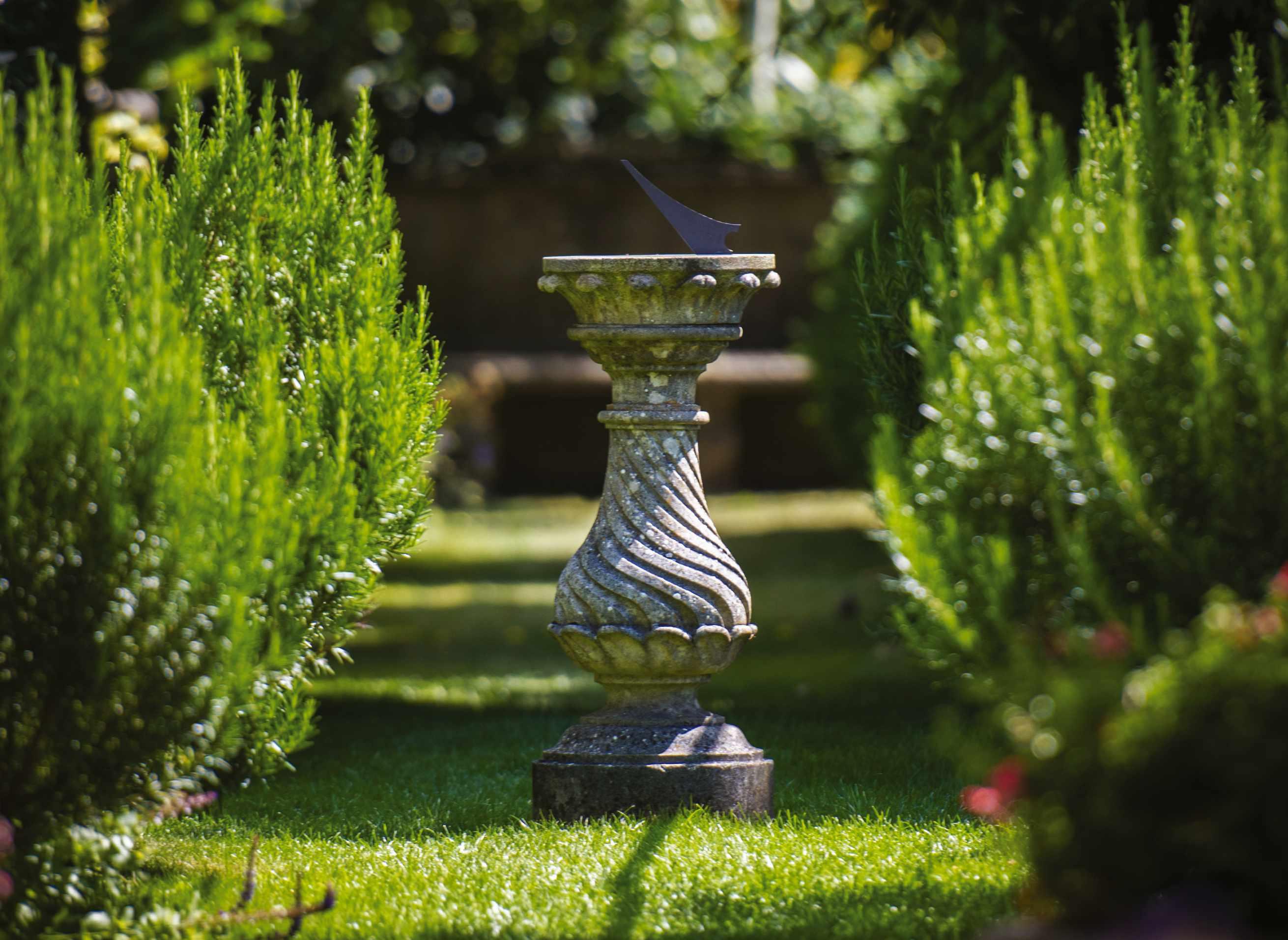

������������������������������������������������������� ���O�������� Call 01604 770711 Visit haddonstone.com

KITTED OUT
For creating the ultimate edible garden



 COMPILED BY MOLLY BLAIR
COMPILED BY MOLLY BLAIR
JULY 2022 GARDENSILLUSTRATED.COM 17
DIG IN SHOPPING
MAIN IMAGES @THESHED_PHOTOSTUDIO 2 3 4 5 1 7 6
1. Access Garden Cloche, antique ivory, L 79cm x W 53cm x H 41cm, £189, 01788 822301, garden-products.co.uk 2. City Greenhouse, £649, 01993 823117, burford.co.uk 3. Galvanised Metal Planters, set of 5, £34.99, crocus.co.uk 4. KOOLIST Jute Plant Support Netting, 5m x 2m, with five ground spikes, £19.49, amazon.co.uk 5. Lockable Galvanised Calendar Seed Trunk, H23cm x L40cm x W26cm, £49.99, crocus.co.uk 6. Sneeboer Royal Dutch Hand Hoe, £55.95, 0333 400 1500, harrodhorticultural.com 7. Jennifer Newman Box Planter on Wheels, black grey, L 40cm x W 40cm x H 47cm, £702, 020 3110 0610, wellworking.co.uk



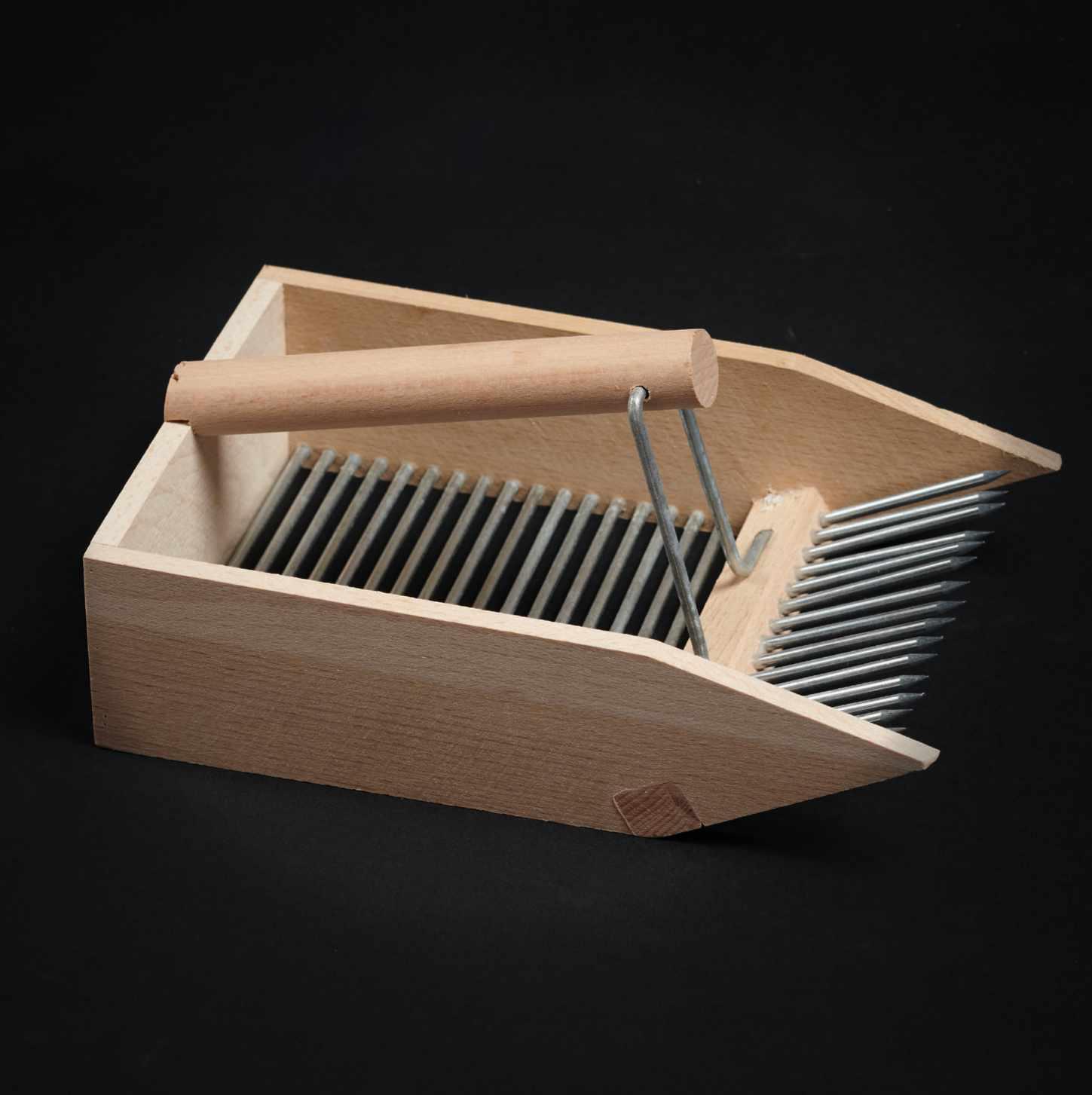 1. Wooden Berry Picker, £22.95, 0345 605 2505, worm.co.uk 2. Korbo Classic 35 Basket, acid-proof steel, H 24cm x Ø 45cm, £121, 020 3002 1196, nordicnest.com 3. Draper 19628 Telescopic Fruit Picker, £14.59, 01358 726719, toolden.co.uk 4. Niwaki Original Tripod Ladder, 2.4m, £529, 01747 445059, niwaki.com 5. Planting Ruler, 30cm, £10.49, 0114 233 8262, burgonandball.com 6. Original Veggie Bed, L 150cm x W60cm x H40cm, £99.99, sage, 0844 736 4208, suttons.co.uk
1. Wooden Berry Picker, £22.95, 0345 605 2505, worm.co.uk 2. Korbo Classic 35 Basket, acid-proof steel, H 24cm x Ø 45cm, £121, 020 3002 1196, nordicnest.com 3. Draper 19628 Telescopic Fruit Picker, £14.59, 01358 726719, toolden.co.uk 4. Niwaki Original Tripod Ladder, 2.4m, £529, 01747 445059, niwaki.com 5. Planting Ruler, 30cm, £10.49, 0114 233 8262, burgonandball.com 6. Original Veggie Bed, L 150cm x W60cm x H40cm, £99.99, sage, 0844 736 4208, suttons.co.uk
18 GARDENSILLUSTRATED.COM JULY 2022 DIG IN SHOPPING 2 3 4 5 6 7 8 1
7. Elegance Pea & Pest Fence, rustic, W 85cm x H 75cm, £46.95, 0117 934 1790, agriframes.co.uk 8. Jute Potato Planter Bag, 40L, £9.99, waitrosegarden.com

rhinogreenhouses.co.uk 0800 694 1929 Welcome the joys of spring from within your very own Rhino greenhouse. Ultra-strong and beatifully engineered to provide everything you need on your gardening journey, it’s the perfect space to protect and grow your plants as the days get longer and nature blossoms back into life.
SALVIA ‘AMISTAD’
A beautiful and incredibly floriferous salvia that will continue flowering until the first frosts. It survives the winter at Gravetye, although benefits from autumn mulching for a little extra protection. Its winter skeleton will offer some structure, although it usually dies back to the ground and should be cut back hard in early spring. We take cuttings between July and August, overwintering in a cool greenhouse and find these make the best plants. After hardening off they can be planted as gaps open up. AGM*.
Height and spread 1.2m x 50cm.
Origin Garden (species South America). Conditions Moist but well-drained chalk, loam, sand; full sun in a sheltered spot. Best plants are produced by overwintering cuttings under glass.

Hardiness RHS H3, USDA 9a-11†
Season of interest June – November.
July plants
BERKHEYA PURPUREA
This is an attractive, short-lived perennial from South Africa that has an unusual, thistle-like appearance. It works particularly well for us at the front of our long border where its big, circular, purple daisy flowers contrast beautifully with spikes of Sisyrinchium and Libertia . We generally have our best results from seed sown in autumn, which means that the plants can be grown on into 9cm pots before they are overwintered in a cold frame ahead of a spring planting. Once established it is perfectly hardy for us, flourishing in a free-draining soil.

Height and spread 50cm x 50cm. Origin Mountainous regions of South Africa.
Conditions Free-draining soil; full sun.
Hardiness RHS H4, USDA 6a-9b.
Season of interest June – July.
ROMNEYA COULTERI

Tall stems of glaucous foliage bear giant yellow and white poppy flowers with delicate, almost translucent, petals. These have a remarkable ability to remain in good condition for several days and have a delicate fragrance. It was initially collected by Dr Thomas Coulter in northern California in 1832 (not recorded), but it wasn’t until 1877 that the first plants flowered at Ireland’s National Botanic Gardens at Glasnevin, near Dublin, where a young William Robinson would have been impressed by the plant. He introduced it to Gravetye in the 1880s and it remains a favourite here. AGM.
Height and spread 2m x 2m. Origin California.
Conditions Moist but well-drained soil; full sun in a sheltered position.
Hardiness RHS H5, USDA 7a-11.
Season of interest July – August.

ERIGERON ANNUUS

A lovely fleabane from North America that behaves like an annual or biennial, self-seeding freely through the garden and flowering from June until long into autumn. Its pure-white petals, or rays, always drop before they go brown, keeping the plant looking fresh throughout the year, and is particularly good at night when the flowers have a wonderful hazy, floating quality. It is important to thin out self-seeded seedlings in the spring, weeding out those that may be in the way and transplanting to better spots. Cut back by half in June to make compact bushy specimens or it will need staking.
Height and spread 1.5m x 1m.
Origin North America.
Conditions Light, well-drained soil; full sun or part shade.
Hardiness RHS H7.
Season of interest June – November.
DIG IN PLANTSPERSON’S FAVOURITES
*Holds an Award of Garden Merit from the Royal Horticultural Society. † Hardiness ratings given where available.
High summer brings an explosion of colour to Tom’s choices, as bright oranges contrast with rich purples and blues, cooled by fresh whites and pale lilacs in Gravetye’s borders
WORDS TOM COWARD PHOTOGRAPHS JASON INGRAM
Tom Coward is head gardener at Gravetye Manor in East Sussex gravetyemanor.co.uk
JULY 2022 GARDENSILLUSTRATED.COM 21
CHARLIE HOPKINSON
Make your garden glow
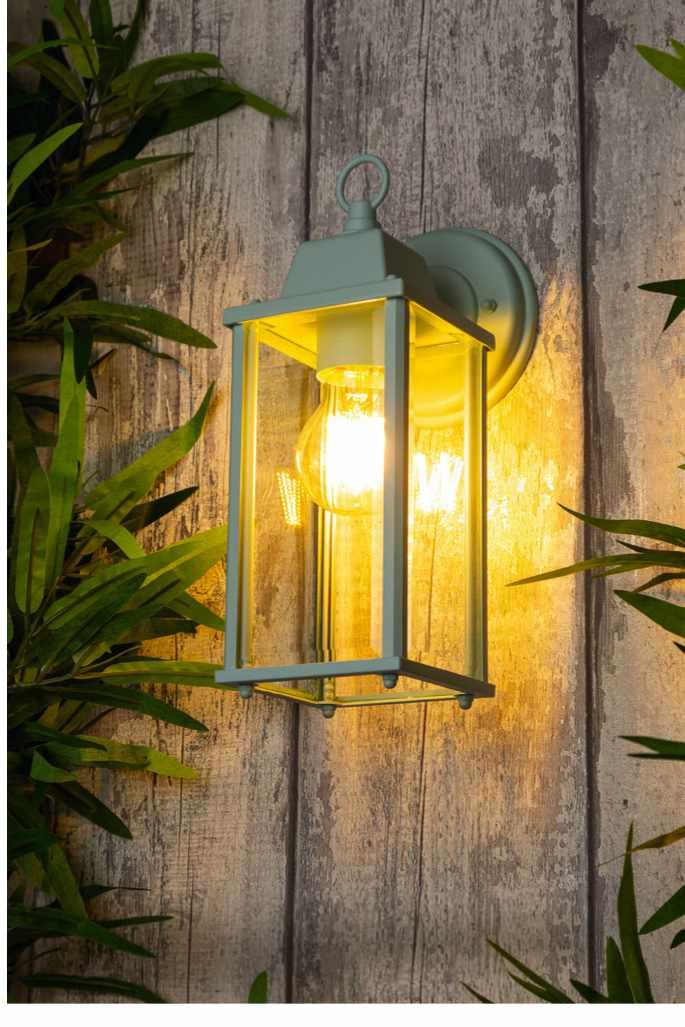
In the night garden
As days get warmer we all want to spend as much time as possible in our gardens, even once the sun goes down. Litecraft’s stylish range of outdoor lighting and heating o�ers that night garden glow with a range of di�erent styles and finishes at a�ordable prices. From traditional lanterns to modern LED lamps, there is something to suit all tastes and budgets, with innovative design features, such as motion detectors, remote control and photocell technology that adjusts light levels according to natural daylight levels. And once temperatures start to fall, Litecraft’s energy e�cient radiant heaters can help keep you warm. With incredible low-running costs heater styles include freestanding and wall-mounted fixtures and even parasol clamps – many including remote controls, LED lights and wireless speakers.
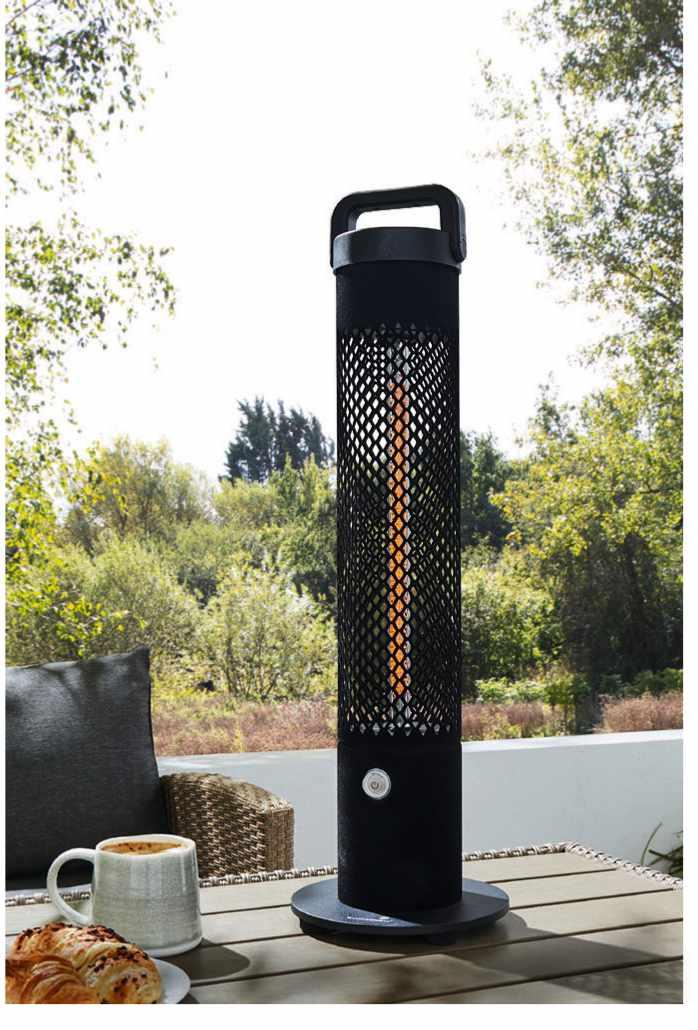



Lite fantastic

Litecraft has been lighting the UK’s homes for more than 70 years, and now in collaboration with the well-known brand BHS, the Greater Manchester-based lighting retailer o�ers an ever wider range of elegant, luxury lighting at a�ordable prices. Shop online or visit one of its five store locations across Manchester, Oldham, Birmingham, Leeds and Glasgow – open seven days a week with free parking for an in-person view of the full lighting range.

Whatever your style and budget, Litecraft’s range of stylish outdoor lighting and heating options mean you can enjoy your garden on summer evenings – long after the sun has slipped below the horizon, and regardless of what the British weather might choose to throw at us
Cetus Glass Panel Outdoor Wall Light, £85.
Grus Angled Outdoor Wall Light, £21.
Pildora Outdoor Wall Light, £16.
Colone Outdoor Lantern Bevelled Glass Wall Light Lantern, £21.
Customer service 0161 359 4777 litecraft.co.uk / bhs.com ADVERTISEMENT FEATURE
1200-Watt Free-Standing Outdoor Heater, £140.
EUDIANTHE COELI ROSA ‘BLUE ANGEL’
This charming and beautiful hardy annual is a favourite at Gravetye. With its delicate blue flowers on soft, upright, green leaves it has a similar look to flax, only with flowers of a richer blue and a longer flowering season. We generally sow in autumn and overwinter the plants in a cold frame for spring planting. These tend to make the best plants but we also do a spring sowing to grow plants that flower a little later in the season. It works well in large drifts as well as being squeezed into gaps throughout the border.

Height and spread 30cm x 30cm. Origin Canary Islands, western Mediterranean.
Conditions Well-drained chalk or loam; full sun or part shade.
Hardiness RHS H5.
Season of interest May – July.
HELENIUM ‘SAHIN’S EARLY FLOWERER’
Probably has the longest flowering season of any helenium and its strong, orange daisies are fun to work with. It can start blooming from mid June and with careful deadheading will continue deep into the autumn. Its colour is quite intense but in the mellow light of late summer it can be very effective. I particularly enjoy using it with the contrasting spikes of blue or purple salvias. Dividing it regularly will help extend the flowering season as well as giving the opportunity to remove any perennial weeds. Needs plenty of space.

Height and spread 1.5m x 1m.
Origin Garden (species North America).
Conditions Moist but well-drained soil; full sun. Hates competition.
Hardiness RHS H7, USDA 3a-9b.
Season of interest June – October.
Places to visit
Tom’s recommendations for places to see seasonal plants at their best
Be sure to check opening times. Some garden visits may need to be pre-booked
Great Dixter needs little introduction in these pages, and is a place that has inspired generations of gardeners. During the lifetime of its owner Christopher Lloyd, it became one of the most adventurous, exciting and creative of gardens, and today his head gardener and close friend Fergus Garret continues to care for the garden with the same
passion and energy. The intensive mixed borders and beautiful wildflower meadows are a constant source of inspiration, and Fergus is passionate about sharing his knowledge, meaning Dixter continues to be one of the leading places for training the next generation of gardeners. Northiam, Rye, East Sussex TN31 6PH. Tel 01797 252878, greatdixter.co.uk
CROCOSMIA ‘ZEAL GIANT’

Bred by English plantsman Terry Jones, and introduced in the 1990s, this is a very showy, impressive and tall crocosmia. The orange flowers with darker strips on the lower petals are upward facing on dark, bronzy stems. I especially like the herringbone pattern of the flowers in bud, which are beautiful even before they open. The leaves are quite broad, tall and pleated. We use ours as a single spot of strong orange in our long border. Needs careful staking before the flower buds open so it doesn’t collapse in one of those inevitable summer thunderstorms.
Height and spread 1.5m x 45cm. Origin Garden (species South Africa).
Conditions Moist but well-drained soil; full sun in a sheltered spot.
Hardiness RHS H4, USDA 5a-9b. Season of interest Flowers July –August, but impressive foliage all season.
Not far from Dixter, the haunting beauty of the Dungeness landscape makes a unique setting for Derek Jarman’s remarkable garden at Prospect Cottage. Between 1986 and 1994, the late artist and film director worked on the garden digging large holes in the shingle that he lined with bed sheets and filled with soil to establish tough seaside plants, and
naturalising exotics among local wildflowers. To mark the location of plants he used pieces of driftwood, which over time were turned into sculptures. Early July, when carpets of wild blue echiums emerge among the burnt-orange of naturalised Californian poppies, is a good time to visit this magical garden. The dilapidated nursery the Massey family
DIG IN PLANTSPERSON’S FAVOURITES
JULY 2022 GARDENSILLUSTRATED.COM 23
DIERAMA PULCHERRIMUM

Although this can be hard to establish, once it has found its place it will thrive and even self-seed. It has a handsome, translucent, grass-like appearance through spring, but when it blooms in June, and the bell-like flowers hang from its long, arching flower spikes, it has a grace and movement like no other plant. And the dried-out flower spikes look good throughout the winter. The most common form is pink with a touch of lavender but there are several named colour forms available ranging from red, pink and white to lavender.
Height and spread 1.5m x 75cm. Origin South Africa.
Conditions Well-drained soil; full sun or dappled shade in a sheltered spot.
Hardiness RHS H4, USDA 8a-10b.
Season of interest Flowers June – July; foliage looks good year round.
DAHLIA ‘PORCELAIN’
This beautiful dahlia is lilac in bud then opens to the most enchanting white-lilac, waterlily-type flower. As it matures it opens with a yellow centre, at which point we deadhead it to prevent such an elegant flower looking drab. We lift dahlias and store over winter in a shed. Some may survive just fine in the ground but by lifting we open space in the border for spring planting and secure plants against harsh weather. This one works best if forced in the greenhouse, around January. With enough warmth the plant will erupt into growth and basal cuttings can be harvested and rooted with bottom heat.

Height and spread 1.5m x 1m.
Origin Garden (species Central America).
Conditions Moist but well-drained soil; full sun in a sheltered position.
Hardiness RHS H3.
Season of interest July – November.
BISTORTA ‘PINK ELEPHANT’
Found among the Persicaria relatives bred by Chris Ghyselen in his garden, Oostveld, near Bruges in Belgium. All are excellent plants but if I could pick only one it would have to be this one. Beautifully proportioned and compact, it has plentiful soft-pink flower spikes that have a lovely waving habit, rather like an elephant’s trunk, and last over a really long season. It works well repeated along the front of the border with grasses and blue salvias. Also makes a lovely combination with early flowering asters, such as Aster pyrenaeus ‘Lutetia’.

Height and spread 50cm x 1.5m.
Origin Garden (species Afghanistan to China).
Conditions Well-drained fertile soil; full sun or part shade.
Hardiness USDA 4a-7b.
Season of interest June – October.
bought in 1967 has developed over the past 50 years into one of the UK’s best retail nurseries. Today Ashwood Nurseries offers a wide and excellent selection of quality plants, including hellebores, hepaticas, cyclamen and snowdrops, which are all specialities. The nursery offers an excellent online service but there is nothing quite like visiting the nursery
and seeing the stock. This also offers the opportunity to visit owner John Massey’s private garden, which is a three-acre plantsman’s paradise of beautiful design with the backdrop of the Staffordshire and Worcestershire canal.
Ashwood Lower Lane, Kinver, Kingswinford, West Midlands DY6 0AE. Tel 01384 401996, ashwoodnurseries.com
High summer in the Alps is something every plant lover should experience at least once. In the Bavarian Alps, south of Munich, the Alpine Garden on the Schachen is a wonderful garden at an altitude of 1,860m. It’s been a satellite garden of the Botanical Garden Munich-Nymphenburg for more than 100 years, and has over 1,000 species
of alpines from around the world, all thriving in their perfect situation. The garden, which is next to the former hunting lodge of King Ludwig II, is only accessible by a six-mile hike, climbing 850 metres, which is one of the highlights of the experience. It is important to give plenty of time for this and take a good wildflower book, because it
is fascinating to watch the flora change as you climb, with orchids, gentians and many other treasures growing wild. Close by is an alpine lake that is very pleasant to swim in and there is a nearby small chalet that serves Weißbier and Bavarian wurst… really the perfect day out.
Tel +49 (0)89 17861 310, botmuc.de/en/garden/ schachen_visit.html
DIG IN PLANTSPERSON’S FAVOURITES
24 GARDENSILLUSTRATED.COM JULY 2022
Inspiring you to grow
From gardeners looking to expand their knowledge of plants and design, to those planning a career change, RHS Level 2 Certificate is the ideal starting point.

Why study with the RHS?
Horticulture enriches our homes and communities in so many ways. Combining natural sciences with practical skills, the process of producing fruit, vegetables, herbs and flowers brings great joy to many people.
Perhaps you’ve recently discovered a passion for gardening and growing plants? Or maybe you work in horticulture and like the idea of expanding your knowledge and skills? If so, an RHS Level 2 Certificate is an excellent place to start.
What is the RHS Level 2 Certificate?
The Level 2 consists of practical-based and knowledge-based certificates. This makes it ideal for anyone wanting to further personal interests as well as those wanting a route to employment in professional horticulture.
Chitra Nagarajaiah, enrolled on the RHS Level 2 to improve her skills, she says: “I am a novice in the gardening world. This course has provided me a good foundation and at the same time has stimulated my interest so that I voluntarily spend time in deeper study into certain topics. I have learned lots of new things and gained
confidence. The experience and knowledge I’ve gained is invaluable. I’ve loved it so much!”
Why choose the RHS Level 2 Certificate?
The Level 2 Certificate allows you to be fully immersed in the world of horticulture, as well as acquire the knowledge and skills to carry out routine tasks proficiently. For learner Martin Page, it was the technical know-how from the course that gave him the confidence he needed to create his own outdoor sanctuary. He says: “Some of what I’ve done includes replacing the lawn with new perennial beds, digging out a pond and creating some raised beds to grow vegetables. All of this has been much more enjoyable and less stressful than I think it would’ve been otherwise.”
The RHS has been awarding qualifications since 1893, providing education at all levels in the horticulture industry. Whatever you want to gain, whether it’s a bit more technical ability or a recognised qualification, the Level 2 Certificate can certainly provide you with an exceptional foundation to grow.
To find out more about learning with the RHS, visit rhs.org.uk/qualifications or follow @RHS_Learning
Advertisement
© RHS / Paul Debois
© RHS / Mark Waugh
GA R DENS

when you subscribe to the digital edition
Save




A must-have read for passionate gardeners, Gardens Illustrated magazine provides a unique insight into the world’s most beautiful gardens, expert advice and planting ideas. ENJOY OUR PREMIUM APP EXPERIENCE NOW buysubscriptions.com/ gardensillustrated
THE CONSTANT GARDENER
As days get hotter, summer growth is at full pelt and borders are overflowing with an abundance that can leave gardeners with the welcome dilemma of having too much choice
 WORDS BENJAMIN POPE ILLUSTRATION CLAIRE HARRUP
WORDS BENJAMIN POPE ILLUSTRATION CLAIRE HARRUP
Much like the previous month, July is a time of plenty in the garden and the borders are brimming with flowers. Given a deadhead, lupins and spring geraniums will be offering the last of their flowers, alongside other perennials such as campanulas, hemerocallis, monardas and phlox, all of which are in their prime. Many shrubs also throw their hat into the ring with cistus, hypericum and weigela all flowering profusely.
I particularly love the hazy coral plumes of Cotinus ‘Grace’ and arching floral sprays of Physocarpus opulifolius ‘Diabolo’. Also joining the party are annuals including Cosmos sulphureus, Erigeron annuus and Nicotiana suaveolens. These will continue with gusto, bridging the August gap before the late summer perennials arrive.
Like the borders, containers are in full flow and benefit from a little care. I regularly pick over plants removing spent flowers and old leaves, as well as feed them every other week with a weak seaweed tonic, along with the occasional dose of tomato
food that will help if flowering is shy. If space allows, it’s always a good idea to grow an assortment of pots so that they can be rearranged for seasonal interest, temporarily accommodating either houseplants from inside or additional seasonal flowers. While care and watering are always a concern, this type of gardening can enliven even the dullest space and make for a very creative and dynamic feature.
As summer rolls on the garden tasks focus on the maintenance of growth and ripening of produce, with watering, feeding and summer pruning top of the list. If very dry, additional water will ensure spring-flowering shrubs, such as camellias and rhododendrons, have adequate moisture to set their flower buds.
As another day comes to a close and the warmth subsides, I take the opportunity to sit outside with a cool drink and become inspired by the arrival of bulb catalogues. I check notes and cross reference photographs of spring flowers to compile a list of bulbs for ordering later in the summer, ensuring best quality and choice so that the borders and containers will be as colourful next spring as they are now.
What to sow and plant
With summer in full swing, it’s easy to be seduced by the abundance of flowers and produce. Though as a gardener my mind looks to the seasons that will soon follow.

Now is a good time to start off wallflowers for early spring interest, sowing in seed trays or modules before planting in the ground – where I find they mature better into healthy, strong plants than if grown on in pots – and then transplanted to containers in late winter. For bright and bold combinations, I go for cultivars, such as ‘Scarlet Bedder’, ‘Sugar Rush Purple Bicolour’ or ‘Sunset Orange’, though the softer ‘Sunset Apricot’ and ‘Sunset Primrose’ are charmingly sophisticated.
For the plate, another sowing of French or runner beans, along with salad leaves, radish or turnips will prove fruitful this season, though looking ahead I start to sow fast-maturing carrots, such as ‘Nantes 5’ and winter-cropping endives and kales. Sowing chard ‘Bright Lights’ now will provide both colour and nourishment through winter, while onion ‘Rossa lunga di Firenze’ can be cropped early as a spring onion or will swell and stand through winter to be used for delicately flavouring dishes.
What to harvest and pick
The hot days and warm nights of July bring perfect growing conditions for many plants. While roses and perennials are producing much for cutting, I find gladioli and lilies highlights during July. The rich and zesty cultivars available match the stature and size of their blooms, making them easy to arrange with. A mixture of dazzling gladioli: ‘Espresso’, ‘Evergreen’, ‘Plum Tart’ and ‘Purple Flora’ require little else to have impact, while Lilium African Queen Group will look fantastic when paired simply with dark-red amaranthus and Panicum miliaceum ‘Violaceum’.
In the fruit cage and vegetable beds the harvest continues to grow, from broad beans, peas, carrots and potatoes, through to cherries, currants, strawberries and early raspberries. Cucurbits romp away with courgettes and cucumbers producing a glut. Pinching the side shoots of melons and removing the tips of trailing squashes will result in fewer but larger fruits later in the year. Onions will soon be ready to pull when the foliage folds; allow to dry fully, somewhere cool and dry, and away from the sun, before cleaning and storing for winter use. n
GARDEN JOBS for July
Summer prune wisteria Tame these vigorous climbers by lightly trimming the long tendrils and foliage of current season’s growth to tidy the appearance and neaten the habit.
Deadhead spent flowers Continue to deadhead roses and annuals, such as cosmos and sweet peas, cutting back old flower stems to a strong bud or stem to improve the appearance and promote continuation of flowering.
Clean insides of greenhouses, cold frames and polytunnels With most plants growing happily outside, now is a great time to clean and tidy the inside of your growing structures. Wash internal glazing and membranes, while cleaning and preserving timber and metal staging. List seeds for collection As flowers begin to produce seeds, get organised and list what seed you’d like to keep, as well as gathering paper bags and envelopes so you can safely collect and store seed ready for sowing next year. Visit garden shows and festivals With the growing season well underway, it’s a great time of year to visit other gardens and shows to gain ideas, inspiration and the odd new plant, leaving you buzzing with enthusiasm for your own garden.
DIG IN IN THE GARDEN
JULY 2022 GARDENSILLUSTRATED.COM 29
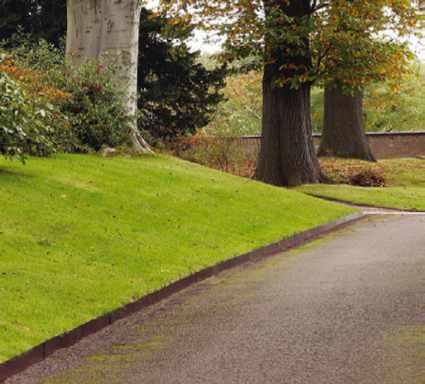









GARDENING TALENT
JAMES TODMAN
As a self-employed topiarist, James is helping to raise the craft of clipping plants into an art form
 PORTRAIT ANDREW MONTGOMERY
PORTRAIT ANDREW MONTGOMERY
First plant love A spider plant when I was about ten years old. I gave it a very short haircut, for no other reason than I wanted to see what happened. I think this may have been the start of my desire to shape plants.
Who has inspired your career? Luciano Giubbilei, in particular a roof garden he designed for the Swiss private investment company Unigestion. He placed a series of green domes in a long curve, set against pale-grey gravel. The simplicity of the shape, with the effect of light and shadow playing on the form, really caught my attention.
What did you do before gardening? I studied hotel and catering management at university and then managed a delicatessen for many years but wanted to work outdoors. I began by working in some beautiful gardens that had a lot of topiary and undertook short courses at Pershore College to help me specialise in topiary maintenance.
Horticultural heroes Jake Hobson, for his cloud pruning and organic topiary. I also appreciate the skill and knowledge of Chris Crowder, head gardener at the historic topiary gardens at Levens Hall in Cumbria.
Favourite gardens I really admire the topiary at Les Jardins de Marqueyssac and Les Jardins d’Étretat in France, as well as Levens Hall. However, my biggest influence is the natural landscape. I try to emulate rolling hills with my cloud designs. Most valuable training Practice; with topiary someone can show you what to do, but nothing beats picking up a pair of shears and having a go.
Three worthwhile tips Learn about the plant you’re working with. Each one will respond differently to clipping. When deciding on a design, work with the plant’s natural growth habit – don’t try to force a shape on it. For example, plants with vertical growth habits won’t suit being shaped into a ball. And don’t be afraid to make mistakes. If you clip a plant and are not happy with the shape, in most cases it will grow back, and you can try again.
Favourite ‘weed’ you’re happy to have in your garden Ivy can be interesting as it can be clipped and shaped. Do you have a particular aim in your gardening career?
Topiary is seen as an aspect of horticulture, whereas sculpture belongs with the art world. I want to bridge the gap between the two by creating topiary that can be considered green (or organic) sculpture. I would like topiary not to be seen solely as a gardening process but also as an artistic creation, with plants being the sculptor’s medium. Contact jamestodman@icloud.com, @james_todman
JULY 2022 GARDENSILLUSTRATED.COM 31
With topiary someone can show you what to do, but nothing beats picking up a pair of shears and having a go

CLOSE AND PERSONAL
IN BRIEF
What Rectory garden that surrounds a church on three sides. Where Northamptonshire. Size Two-acre garden within an 18-acre site. Soil Clay.
Climate Exposed hilltop, which can get very windy. Hardiness zone USDA 8.
The traditional vicar’s lawn has been rationalised for use in the 21st century, with sections of long grass and high-spirited herbaceous borders, which include dark stemmed Penstemon digitalis ‘Husker Red’. New trees – constantly being added at different sizes – bring life and height to the garden while filtering wind, along with the mature trees around the garden’s edges.

JULY 2022 GARDENSILLUSTRATED.COM 33
In a garden that was once only about looking out, James Alexander-Sinclair has brought colour and personality close to the house through abundant planting
WORDS KENDRA WILSON PHOTOGRAPHS BRITT WILLOUGHBY DYER
hen James Alexander-Sinclair began working on this rectory garden four years ago, most of the area used by his clients and their family faced north, with a vast open sky to the east. By lunchtime, the sun had moved to the other side of the church behind the house, shining on a field of nettles. He was tasked with connecting the whole garden, which wraps around both the house and the church. Northamptonshire villages are peculiarly feudal, often still dominated by the ancient set-up of manor, vicarage and church. At this old rectory, the church is so close to the house that it is in the back garden.
Newly rationalised, with terraces for maximum sun as well as a variety of views, the garden has the appearance of being quietly at peace with its surroundings, as inevitable as Northamptonshire stone or the ridge-and-furrow fields just below. On the distant horizon, a line of beech trees was planted by ‘Capability’ Brown; scanning the eyes to the right, past shrub roses in the long grass and a small gate in the wall, fallow deer roam about in a small deer park.
“We call it a deer garden,” says Victoria Bridgeman, who lives here with her husband
WLuke. This little piece of grandeur, as well as the avenue of fastigiate yews marching down the slope of the garden, are happy reminders of the previous owner, a colourful character, but other reminders had to go: a wall of Leyland cypresses blocked not only wind but the sight of the deer. A more interesting wind buffer consists of scores of trees (and gorse further from the house), with many hardy specimens in the garden: hawthorn, plum, crab apple, a new cherry orchard on the other side of the church, and a rejuvenated apple orchard between the house and the valley.
The Bridgemans had time to get to know the garden in the ten years before James was called in. Luke identified an area away from the shadow of the house that was less convenient for eating, but perfect for reading. Now, there are several options. “James gave us terraces and a way of navigating different areas around the garden,” comments Victoria, while pointing out that previously the garden was mainly about the view and little else. Instead, there is focus in the foreground: a rill joins the two terraces, with the pale inflorescence of Eremurus ‘Joanna’ picked up in the creamy effusion of several Hydrangea arborescens ‘Annabelle’ in deep borders, backed by billowing roses.
James’s description of the garden’s “unbridled abundance” is a good summary
Along the wall separating the house and garden from the church, a 2.5mdeep border runs parallel to a rill that James put in to point towards the view over Northamptonshire. Rosa ‘Madame Alfred Carrière’ clothes the house wall; Rosa x odorata ‘Mutabilis’ mingles with fennel, near Agapanthus africanus and more raspberry colour from Calycanthus ‘Aphrodite’.
Facing page A long and tall east-facing wall is used to best advantage, supporting clouds of roses that mix with honeysuckle, the clouds continuing with creamy Hydrangea arborescens ‘Annabelle’ in the deep borders. Making further incursions across the lawn by the rill, salvias include S. ‘Royal Bumble’ and S yangii Hamamelis x intermedia ‘Diane’ holds the near corner along with Penstemon ‘Andenken an Friedrich Hahn’.

34 GARDENSILLUSTRATED.COM JULY 2022

Newly rationalised, with terraces for maximum sun as well as a variety of views, the garden has the appearance of being quietly at peace with its surroundings
of the Alexander-Sinclair design style. His appreciation of colour and refinement comes across in plant choices, such as a duo of vanilla and raspberry sweetshrubs, Calycanthus ‘Venus’ and C. ‘Aphrodite’, and in the great number of roses, including Rosa x odorata ‘Mutabilis’, which James has been using for a long time. It flowers repeatedly in myriad shades, “from a rather elegant dark pink to a pale, laundered apricot”. Turk’s cap lilies make themselves known all around the terraces,
as well as salvias in the ground, in pots, and anywhere they will fit.
Flowers and trees, in ever-growing quantities, began to settle in just before lockdown, triggering a passion for planting in Victoria (who has expert help from gardener Chie Arai).
“I love doing things such as taking cuttings and seeing if they are going to work,” she says.
“I can see it could totally fill your life. Which is, you know, not a bad way of spending your life.” The end of full-time work in London
ROOM FOR A VIEW
The surrounding view – which could be called a borrowed landscape – is dominant in this garden. “We’re sitting on top of the hill; it’s like being in a crow’s nest,” observes James. But views can be too big, and they need to be manageable, from the perspective of someone in a garden. On the northeast side of this house, the view is framed between the canopies of two ancient oaks further down the slope, one of which is looking distinctly ‘picturesque’ in its dying state. “Everything leads to the view,” says James. “All paths lead to the view, the rill leads to it, and everything is pointing in that direction.” He has opened up another angle, while allowing in more light, by removing the oversized Leyland cypress to the north, and better revealing the deer park. This collection of views build up around the place to give a triptych e�ect, with pictures of the panorama that are on a more human scale. On the other side of the garden the view and light have been purposely limited, with pleached pears dividing the house from the churchyard.
Another section of the view is framed by two ancient oaks, with a line of beech trees planted by ‘Capability’ Brown strung out along the horizon to the left. In between, a growing population of rugosa roses, including Rosa ‘Blanche Double de Coubert’ occupies the long grass by an allée of fastigiate yews tumbling down towards a gate into the deer park.

36 GARDENSILLUSTRATED.COM JULY 2022
16 KEY PLANTS

1 Rosa x odorata ‘Mutabilis’ Designer favourite, with single flowers that open yellow then age to pink and crimson. As it’s long-flowering, there is myriad colour on one plant. 2m x 2.5m. AGM*. RHS H5†
2 Eremurus ‘Joanna’ Sun-loving, vigorous perennial spires on stout stems that need no staking, sometimes growing in a way that is not straight. Very tall. 2.5m x 30cm. AGM. RHS H6.
3 Rosa Scepter’d Isle (= ‘Ausland’) English shrub rose from David Austin, repeat flowering over a long season, strongly scented. Happy in sun or part shade. 1.25m x 1.25m. RHS H6.
4 Achillea ‘Summerwine’ A perennial that has much appeal in borders and is also highly attractive to pollinators. It has divided foliage that is a good foil to its handsome crimson flowers. Happiest in full sun. 90cm x 50cm. AGM. RHS H7, USDA 3a-8b.
5 Salvia ‘Nachtvlinder’ Velvety, tender, perennial sage with aromatic leaves. Long-flowering, very attractive to pollinators, needs shelter and full sun. 75cm x 50cm. AGM. RHS H5.
6 Rosa Lady of Shalott (= ‘Ausnyson’) English shrub rose. Repeat flowering and lightly scented, the big draw is the flower shape and petal colour of a glowing, peachy-orange. 1.5m x 1.25m. AGM. RHS H6.
7 Eryngium x tripartitum An excellent choice for exposed areas, brings colour and texture and many hoverflies. Needs full sun and soil that is well-drained. 1m x 50cm. AGM. RHS H5.
8 Digitalis parviflora A slender, exotic-looking foxglove that is easy to grow, and produces rich, orange-brown flowers above glossy, lance-shaped, dark-green leaves. Happy in both full sun or full shade. Or anything inbetween. 60cm x 40cm. AGM. RHS H5, USDA 4a-8b. 16 key plants continues on page 38.
1 2 4 5 6 7 8 3
16 KEY PLANTS CONTINUED
9 Anemone x hybrida ‘Honorine Jobert’ A fabulous plant for bringing life back to a flagging border, as it stays fresh from August until first frosts. Does well in part shade. 1.2m x 1.2m. AGM. RHS H7, USDA 4a-8b.
10 Dahlia ‘American Dawn’ Richly coloured dahlia on dark stems with fresh-green foliage. Dahlias enjoy conditions that are moist but well drained. Prefers full sun, 90cm x 60cm. RHS H3.
11 Aruncus ‘Horatio’ A distinctive goat’s beard cultivar with red stems, which was popular at this year’s RHS Chelsea Flower Show. Happy in part shade, and exposed positions. 1.2m x 75cm. RHS H6, USDA 4a-7b.
12 Eremurus x isabellinus ‘Cleopatra’ Dramatic foxtail lily with flowers in shades of burnt orange and red. It mingles well with other Eremurus cultivars. 1.5m x 60cm. RHS H6.
13 Astrantia major ‘Star of Billion’ Pollinator-friendly, cottage-garden plant. Its blooms seem larger than they are because of the green-tipped white bracts surrounding the pinhead flowers. 75cm. RHS H7.
14 Penstemon ‘Andenken an Friedrich Hahn’ With dark foliage and stems, and garnet-coloured flowers, this elegant perennial, also known as P. ‘Garnet’, stands out in a border. 90cm x 30cm. AGM. RHS H5.
15 Papaver nudicaule Easy to grow from seed, Icelandic poppies offer flowers in a variety of shades. Needs full sun. 50cm x 15cm, RHS H7.
16 Thalictrum ‘Elin’ Supremely elegant rue that enjoys partial shade and can take some exposure. Good foliage appears long before the baubles of lilac flowers. 2.5m x 50cm. AGM. RHS H7.
*Holds an Award of Garden Merit from the Royal Horticultural Society. †Hardiness ratings given where available.
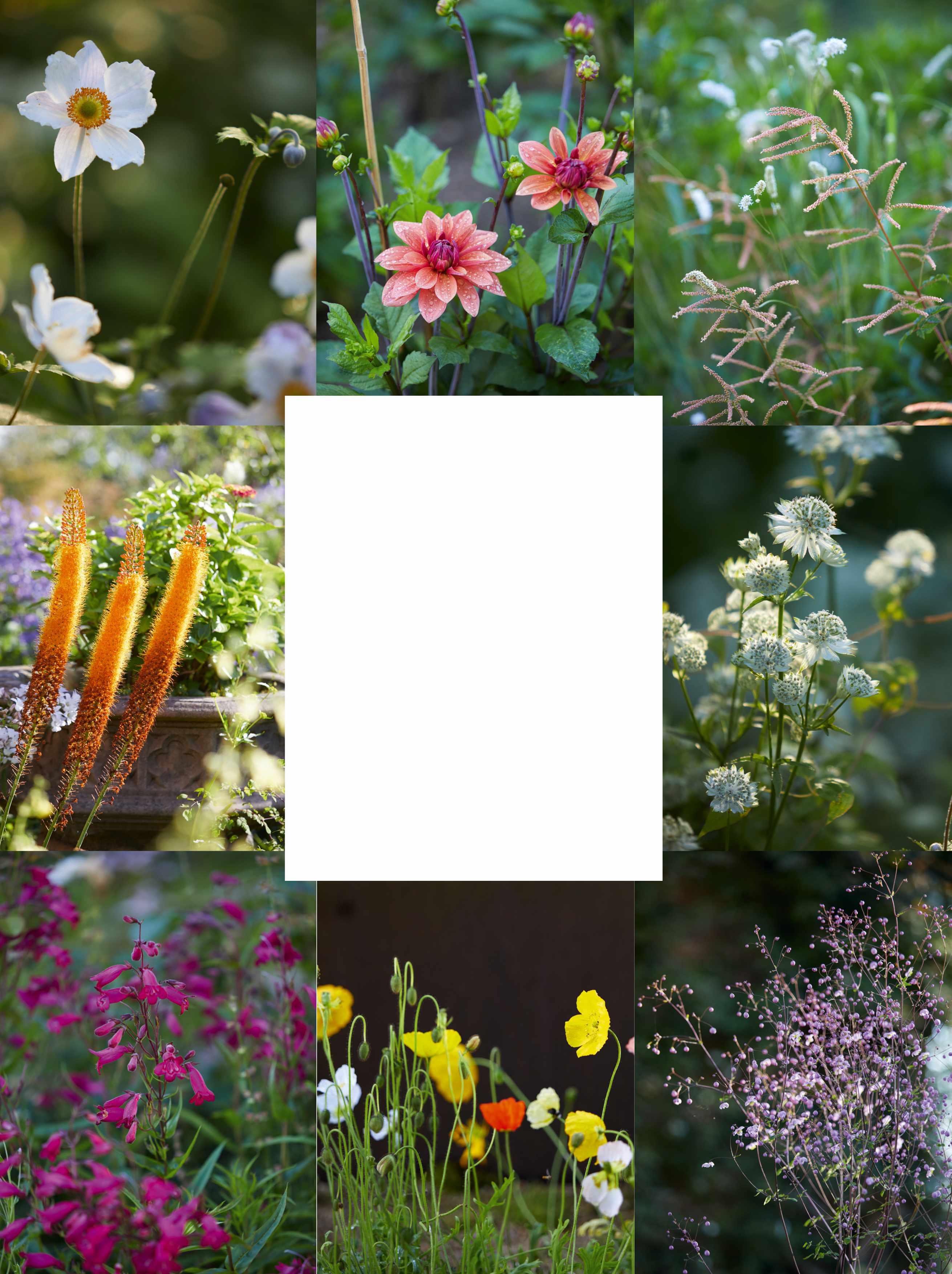
9 10 12 13 14 15 16 11
for Victoria happily coincided with the implementation of the new garden. The ongoing results make a strong case for bringing in a professional to add function and form to your surroundings: “As a designer, you’re making something and then you’re giving it to the client, who can do what they want with it,” says James.

The landscape relaxes down the bank from the terraces and rill, with tough but beautifully scented rugosa roses in grass. They are probably the best roses for exposure and many more are being added. This area signals the next part of the journey around the property: at each stage, the view is represented, with different angles seen from pausing places that are also being added with enthusiasm. A door at the bottom of the long, rose-covered wall that descends from the house opens above the apple orchard,
with a path that winds around the church and up to a newly created pond, which seems to have always been there, but is in fact new. Back at the house, gently cordoned off from the churchyard by a pleached line of Pyrus calleryana ‘Chanticleer’, a final terrace that faces southwest is the place to be, later in the day. The circuit around the house and the opening up of views has made the garden “much more interesting” in Victoria’s words, just as the natural beauty of this part of rural England only needed to be teased out – with the help of someone familiar with the area’s somewhat unknown charms. “Considering we’re squished between two motorways and a high-speed railway,” says Victoria, “we’re pretty lucky.” n
USEFUL INFORMATION
Find out more about James’s work at jamesalexandersinclair.com
Facing southwest, a terrace outside the study is filling up with tall and colourful planting, a distraction from the driveway just beyond. Mauves and purples include airy Thalictrum ‘Elin’ and Salvia nemorosa ‘Caradonna’ while foxtail lilies, Eremurus ‘Joanna’and fiery E. x isabellinus ‘Cleopatra’, reverberate in texture, shape and colour. In front of the study window, Malus ‘Red Sentinel’ performs over several seasons.
JULY 2022 GARDENSILLUSTRATED.COM 39
The heat is on
Cottesbrooke’s head gardener offers three ideas for high-summer containers, turning up the heat with hot colours then cooling things down with a soft meadow combination
 WORDS JENNY BARNES PHOTOGRAPHS RICHARD BLOOM
WORDS JENNY BARNES PHOTOGRAPHS RICHARD BLOOM
MOVEABLE MASTERPIECE
We often joke at work that 90 per cent of a gardener’s time is spent moving plants – from greenhouse to cold frame, into the garden and then back again for winter. That merry-go-round gave me the idea of planting directly into this vintage wheelbarrow. It not only makes an attractive container large enough to create an impressive display but it is easily moveable so the arrangement can be wheeled into any position to add interest wherever there are gaps in the planting.
How to achieve the look
Container and composition
This galvanised wheelbarrow has seen much service at Cottesbrooke, although the base has started to rust through. Luckily, this has created convenient drainage holes making it an ideal planting container. The tray is deep enough to accommodate the large rootballs of taller perennials, such as artemisias, and phlox. I’ve placed smaller groundcover plants, including a geranium and nepeta, around the edges and encouraged them to spill out over the sides to recreate the exuberance of a midsummer herbaceous border. To add pops of more intense colour, I have added the annual Cleome hassleriana ‘Violet Queen’ throughout. Other annuals, such as cosmos, larkspur or cornflowers, could also be interplanted.
Cultivation and care
All of these plants are divisions from the herbaceous borders in the garden. I planted this wheelbarrow in early spring when the plants were still dormant. I added a layer of crocks to the base of the barrow and then filled with a multipurpose compost. Using such large plants in a small container means it’s imperative to water regularly, to keep the soil moist. Feed throughout the summer with an all-purpose plant feed. The taller plants, such as Artemisia lactiflora Guizhou Group and Veronicastrum virginicum ‘Fascination’, may need some support as they grow. Push garden canes into the compost and secure the stems using twine. Watch out for the cleome’s thorny stems.
Plants
1 Artemisia lactiflora Guizhou Group An upright perennial with purple feathery leaves. 1.2m x 60cm. RHS H7, USDA 3a-8b †
2 Geranium Rozanne (= ‘Gerwat’) Reliable perennial with violet-blue flowers. 60cm x 80cm. AGM*. RHS H7, USDA 5a-8b.
3 Cleome hassleriana ‘Violet Queen’ Pink flowers on tall stems. 1.5m x 45cm. RHS H2.
4 Eutrochium purpureum Clump-forming perennial. 2.5m x 1m. RHS H7, USDA 4a-9b.
5 Veronicastrum virginicum ‘Fascination’ Spikes of lilac flowers held on statuesque stems. 1.2m x 40cm. RHS H7, USDA 3a-8b.
6 Phlox paniculata ‘Lilac Time’ Pretty lilac flower. 1m. RHS H7, USDA 4a-8b.
7 Nepeta racemosa ‘Walker’s Low’ Silvery foliage with deep-blue flowers. 60cm x 50cm. AGM. RHS H7, USDA 4a-8b.
8 Hemerocallis ‘Stafford’ Burnt-orange/ red flowers. 60cm x 45cm. AGM. RHS H6.

JULY 2022 GARDENSILLUSTRATED.COM 41
1 2 4 5 6 7 8 3
*Holds an Award of Garden Merit from the Royal Horticultural Society. Hardiness ratings given where available.
SOFT SUMMER MEADOW
I love the idea of creating meadows that everyone can enjoy, regardless of the space they have available. Even a small basket such as this one can provide habitat for bees, butterflies and insects and is small enough to sit on a table, on a balcony or can be used as a window box. Perennials are a sustainable option that will come back year after year. The grasses, sanguisorba and poppies will continue to look good into late autumn and winter, offering a long season of interest.
How to achieve the look
Container and composition
I love the way that the light filters through the grasses and wanted to reflect this soft, airy effect with the wicker basket. I chose one that is slim and rectangular, but you could use any shape or size. The Dianthus carthusianorum, Sanguisorba officinalis ‘Red Thunder’ and scabious all hold their flowers on tall, wiry stems, which mingle with the grasses and float in the breeze. To create this look, the bulk of the display needs to be grasses, but you can add any summer-blooming wildflowers – harebells, cornflowers, wild carrot (Daucus carota), ragged robin would all work well. If the container is for a shady situation, foxgloves, aquilegias and cardamines would all work too.
Cultivation and care
To protect the wicker work, I lined the basket with an old compost bag. I added a layer of gravel to the base for drainage, which also adds stability to the container. I filled the majority of the basket with the grasses and then threaded through the flowering plants. These plants are happiest in full sun, they don’t need a lot of water, but it’s important not to let the container dry out completely. Deadhead the scabious and dianthus as blooms finish to extend the flowering period. When the grasses begin to look tatty, shear over the whole basket, leaving a couple of centimetres’ growth. Keep the basket damp, but not waterlogged throughout the winter and the display will reappear next spring.
Plants
1 Papaver somniferum Tall annual with glaucous foliage. 1.2m x 30cm. RHS H5.
2 Stipa tenuissima ‘Pony Tails’ Compact grass with soft, feathery leaves. 60cm x 30cm. AGM. RHS H4, USDA 7a-10b.

3 Scabiosa caucasica ‘Fama Deep Blue’
Mound-forming perennial with green-grey foliage. 60cm x 45cm. RHS H4.
4 Sanguisorba officinalis ‘Red Thunder’
Dark-maroon flowerheads on slender stems. 1.2m x 60cm. RHS H7, USDA 4a-8b.
5 Scabiosa incisa Kudo White (= ‘Ichwit’)
Button-like white flowers, attractive to bees and pollinators. 50cm x 50cm. RHS H4.
6 Scabiosa columbaria subsp. ochroleuca
Dainty pale-yellow pincushion flowers. 80cm x 60cm. RHS H5.
7 Dianthus carthusianorum Evergreen perennial with bright-magenta flowers. 40cm x 20cm. RHS H7.
42 GARDENSILLUSTRATED.COM JULY 2022
1 3 4 5 6 7 2

Plant suppliers
• Avondale Nursery Tel 07367 590620, avondalenursery.co.uk
• Bressingham Nurseries Tel 01379 688282, thebressinghamgardens.com
• Chilterns Seeds Tel 01491 824675, chilternseeds.co.uk
• Cotswold Garden Flowers Tel 01386 422829, cotswoldgardenflowers.co.uk

FLAMING JULY
I’ve long coveted this vintage bucket. My parents always used to use it to collect the ash from their open fire, but it was only recently that I realised it had the word FIRE printed on the side, making it the perfect container for a selection of fiery-coloured plants, so I have commandeered it. I wanted to play on the fiery theme and create an eye-catching display, using those hot yellows, reds and oranges that are sometimes difficult to incorporate elsewhere in the garden.
How to achieve the look
Container and composition
I’ve always loved this beautiful, rusty, orange-coloured bucket and it’s the perfect showcase for this selection of hot-coloured perennials. Kniphofia ‘Toffee Nosed’ and Kniphofia Bressingham Sunbeam (= ‘Bresun’) look like flames reaching skywards, while the crocosmias add sparks of bright colour. I wanted to keep the whole display very vertical so that it reassembled a roaring fire. I’ve used the evergreen, red sedge Carex buchananii ‘Red Rooster’ to add texture and the grass Calamagrostis x acutiflora ‘Karl Foerster’ to add height. Crocosmia x crocosmiiflora ‘Star of the East’ with its huge orange flowers would be a fantastic substitution for C. ‘Bressingham Blaze’.

Cultivation and care
All of these plants thrive when placed in full sun, but like to be planted in soil that retains some moisture. I incorporated a slow-release plant feed with a multi-purpose compost and added a good handful of our home-made leaf mould to keep the soil structure open and free draining. I used a fine gravel to top dress the planted container, which acts as a mulch to keep moisture locked into the soil. Deadhead the crocosmias and kniphofias after flowering. The grasses and achillea will continue to stand, providing attractive winter interest, the colours turning from fiery reds and oranges to softer, strawcoloured tones. Cut the whole arrangement back to a few centimetres above ground before any new growth appears in the spring.
Plants
1 Kniphofia ‘Toffee Nosed’ Cream flowers, with orange tips. 1m x 60cm. AGM. RHS H5.
2 Crocosmia ‘Lucifer’ Glowing orange flowers held above bright-green foliage.
1.2m x 8cm. AGM. RHS H5, USDA 5a-9b.
3 Calamagrostis x acutiflora ‘Karl Foerster’ Clump-forming grass.
1.5m x 60cm. AGM. RHS H6, USDA 5a-9b.
4 Achillea ‘Terracotta’ Feathery, greygreen foliage with sprays of orange-yellow flowers. 1.1m x 40cm. RHS H7, USDA 3a-8b.
5 Carex buchananii ‘Red Rooster’ Mounds of upright, red-bronze leaves with twisted tips. 60cm x 90cm. RHS H5, USDA 6a-9b.
6 Kniphofia Bressingham Sunbeam (= ‘Bresun’) Apricot-yellow, red hot poker. 1m x 60cm. RHS H5.
7 Crocosmia ‘Bressingham Blaze’ A cormous perennial. Orange-red flowers in late summer. 1m x 60cm. RHS H4.
JULY 2022 GARDENSILLUSTRATED.COM 45 1 2 3 4 5 6 7
IN BRIEF
What Long, rectangular, suburban garden on several di�erent levels. Where London.
Size 250 square metres.
Soil Poor London clay soil, full of rubble, improved or replaced as needed with a compost-enriched loamy topsoil.
Climate Temperate.
Hardiness zone USDA 9.
Levelling up
Tom Massey has contrasted modernist hard landscaping with shaggy and shimmering grasses in this small suburban garden in Twickenham

JACOBS PHOTOGRAPHS ALISTER THORPE
WORDS KATE
The most prominent feature in this long, narrow garden has already earned itself a nickname, “We call it the Cubist cliff path,” explains designer Tom Massey with a smile. This sculptural element merges Brutalist blocks of cast concrete with the experience of a walk along the rugged Cornish coast, complete with the risk of getting one’s feet wet while jumping a stream. “I wanted to create the same sense of adventure and excitement that you get when interacting with a wild landscape,” says Tom. “I took inspiration from the cubist shapes of the architecture, but softened that with generous, immersive planting.”
This is Tom’s ingenious solution to the problem of how to access the garden from the newly excavated, lower-ground floor of this imposing Victorian house. Basement extensions have become increasingly popular, but Tom was keen to avoid the standard approach to garden access. “The usual answer is an oppressive bank of steps, with token planted areas, which can feel quite gloomy,” he explains. Instead Tom has designed a series of steps intended as sculpture. “I wanted them to feel interesting and inviting.”
The change of levels also gave Tom the opportunity to introduce the element of water, which flows down through the space via a series of spouts and pools,
Above left The cast concrete blocks nod to the modernist additions to this Victorian house and are softened by densely planted grasses and a multi-stem Amelanchier x lamarckii. The garden beyond has been deliberately veiled by planting, encouraging the visitor to step out and explore.
Above top Some of the steel is ‘tea-washed’ to a powdery, dark-slate grey, as a reference to the leadwork of the Victorian building. Tom chose rushes and grasses with varied flowering periods, including Luzula nivea and Hakonechloa macra,to bring a sense of movement to the scheme.
Above The foliage of Dryopteris filix-mas and Anemone x hybrida ‘Honorine Jobert’ is silhouetted against perforated panels of Corten steel cladding, by Graepels, which was chosen to break up the grey hard landscaping with a deep-rust tone.


JULY 2022 GARDENSILLUSTRATED.COM 47
Above top A system of spouts, pools and channels weaves around the ‘Cubist cliff path’ steps, an area designed to be engaging for adults and fun for children, as well as encouraging wildlife, with water that has not been chemically treated. As a result, the garden has quickly gained a population of frogs that help to keep garden pests under control.
Above In this long narrow plot, Tom has used planting to create rooms, each with their own character. This seating area is engulfed by grasses including Calamagrostis x acutiflora ‘Karl Foerster’, Miscanthus sinensis ‘Yakushima Dwarf’ and Deschampsia cespitosa, as well as tall, feathery Foeniculum vulgare


buffering the suburban soundtrack of planes or cars. The water is chemicalfree, providing a habitat for tadpoles, frogs, newts and dragonflies. “It’s important that we see our gardens as places that we share with wildlife, rather than trying to shut it out.” Tom has tapped into the landscape of the surrounding area by using species that are native to this riverside location, including Crataegus monogyna, Deschampsia cespitosa, Luzula nivea, Asplenium scolopendrium and Molinia caerulea
When Tom joined this project it was in the middle of a major modernist reworking of the large Victorian house and, in the process, the garden had been rendered a completely blank – if very muddy – canvas. “It was a chance to re-landscape and create these little scenes, each with its own character. All too often, long, narrow suburban plots get the same treatment, a stretch of lawn with thin borders down each side and a shed at the back as the unintentional focal point.” With the risk being that the whole space can be taken in at a quick glance, sometimes without even needing to step outside.
Tom used the path of the sun as his guide to design two seating areas, positioning one close to the house where the family likes to dine, and another more intimate space with a firepit to the rear of the garden, where a low-slung garden room serves as a home gym. In between the two areas, there’s an area
48 GARDENSILLUSTRATED.COM JULY 2022
Elements of surprise in a small garden
“The key to creating a sense of surprise is to move away from the traditional idea that small gardens need to be open. For a really successful space, the opposite is true,” advises Tom. The classic suburban ‘corridor’ back garden is often much longer than it is wide, making it perfect for a succession of spaces in which to entertain, play or grow produce. “Even in a small garden, it is possible to enclose areas in order to create di�erent atmospheres, through the use of immersive planting and creative use of hard landscaping.”
Here, Tom worked with the natural slope of the garden to site each space at a di�erent level, creating a journey of discovery as you move between the di�erent zones, and giving each space a more distinct character, making the garden feel larger in the process. Each area is enveloped by semi-transparent ornamental grasses, “Their blurring, hazy textures bring a sense of mystery as you see tantalising glimpses of the rest of the garden. The trees help the garden to play games of conceal and reveal.”
An irregular path of concrete steps nods to the Japanese design principle of tobiishi: raised stepping stones that oblige the user to slow their pace and engage with their surroundings. “You have to interact in a more meaningful way than you would with a straight path. It brings your attention fully into the garden and what it might reveal.”
Above At the summit of the cast concrete steps, a seating area reveals itself. Tom tracked the path of the sun in order to find the best spots for benches, some of which are incorporated into the garden’s retaining walls to make the best use of this small space. Tom included nine trees in his planting plan, including Amelanchier x lamarckii and Cornus kousa. He favoured multi-stem specimens with light, airy canopies to create visual interest, as well as dappled shade.

Concrete steps nod to the Japanese idea of tobi-ishi: stepping stones that oblige the user to slow their pace and engage with their surroundings
Above This long, narrow garden has been zoned into a series of individual spaces. At the centre of the garden there’s a small lawn, requested by the clients as a place for their children to play. Beyond that, the garden gym room is extremely unobtrusive, thanks to the use of reflective glass which adds more greenery to the vista. Grey limestone gravel was chosen to tone in with concrete ‘stepping stones’. The concrete was cast on site, pumped down the narrow side return, which was felt to be a more feasible and cost-effective option than craning in pre-cast slabs and blocks.

dedicated to a small patch of lawn, requested by the family as a place for their children to play. A cantilevered bench, made from iroko timber, is a favourite spot for the owners’ daughter to sit and read.
These spaces are linked by the coherent material and planting palettes. The cube steps morph into cast-concrete ‘stepping stones’ that meander through each area, their irregular layout deliberately slowing the pace of the garden user, “so that they become mindful of their every step”. Cast concrete was also used for the retaining walls that gently enclose each area and double up as extra seating, “There are lots of opportunities for sitting on the built elements, which makes good use of the limited space in this small garden,” explains Tom.
Corten steel, another key material, used for cladding panels and planter edging, is conversely prized for its slim profile. “It’s a good material in a small garden because it doesn’t need to be thick like brick or blockwork, so you can get the planting up close to the edge in the places where it’s needed.” Perforated Corten steel floor panels, which match the vertical cladding, allow water to permeate through into the integrated drainage system, reducing the risk of flooding to the lower ground floor. Both Corten steel and concrete gain character with age. “There’s no point using materials that only look good when they are pristine and new,” says Tom.
�e trees bring a sense of enclosure; they allow light to permeate and create atmospheric dappled shade, which adds to the sense of calm here
50 GARDENSILLUSTRATED.COM JULY 2022
Tom has tempered the hard landscaping with generous areas of greenery, “The hardscape is still readable but it is partially engulfed by the softness of the planting.” The clients love ornamental grasses so Tom opted to champion them in this scheme, with around ten species chosen for their variety of texture, tone and flowering season, including Hakonechloa macra and Sesleria autumnalis The other elements of the planting palette, such as Verbascum chaixii ‘Album’ and Foeniculum vulgare “are plants that will snake through the grasses and feel naturalistic, light and airy”, all adding to the sense of a journey of discovery. Adding another layer, Tom has included an impressive number of trees in this small plot, including multi-stem Amelanchier x lamarckii, Crataegus monogyna which is native to this Thameside area, and Pyrus communis ‘Conference’ – which addresses the clients’ desire for some edibles in the scheme. “The trees bring a sense of enclosure that’s particularly important in a small, overlooked garden, but the open multi-stem forms still allow light to permeate and create atmospheric dappled shade, which adds to the sense of calm here.” n

USEFUL INFORMATION
For more information on Tom’s work visit tommassey.co.uk
Above top In the main seating area, a block of Deschampsia cespitosa ‘Goldschleier’ stands out against the black-coated larch, from Russwood, which Tom chose to clad the disparate boundary fences. To create subtle visual interest, the panels are of irregular widths laid in a randomised order.
Above The sculptural block steps are softened by Asplenium scolopendrium and generous tufts of shaggy rushes and grasses, including Luzula nivea, Hakonechloa macra and Deschampsia cespitosa that shimmer in the slightest breeze.

PLANT PROFILE
What A short-lived perennial or biennial and a member of the Malvaceae (mallow) family.
Origins Wild species of Alcea are native to Asia and Europe.
Season From May to early October.
Size Can grow up to 2.5m tall with a spread of between 40cm and 1m.
Conditions Alcea grow best in a sunny position. They can grow in a range of growing media from well-drained fertile soil, to gravel paths and cracks in paving. Although they can grow well on exposed sites, some shelter can be beneficial to prevent them being rocked over in strong winds.

Hardiness Hardy throughout the UK. Most have a hardiness rating of RHS H5 or USDA zones 3a-8b, although there is some variation.
*Holds an Award of Garden Merit from the Royal Horticultural Society.
†Hardiness ratings given where available.
Alcea rosea ‘Halo Peach’
The flowers of this cultivar from the bi-coloured Halo Series are a soft shade of peach with dark maroon centres. This is highly recommended by National Collection holder Jonathan Sheppard. 1.8m x 60cm.
Alcea rosea ‘Arabian Nights’ Tall, dramatic stems of maroon flowers, so dark they appear almost black. Hollyhock flowers are edible and these look as beautiful on a plate as they do in the garden. 1.8m x 60cm.

RHS H5, USDA 2a-10b†
ALCEA
As one of the quintessential cottage-garden plants, towering hollyhocks are a firm favourite with many gardeners, and offering such a wide range of colours it’s not hard to see why
WORDS BECKY CROWLEY PHOTOGRAPHS ANNAÏCK GUITTENY
JULY 2022 GARDENSILLUSTRATED.COM 53
Alcea rosea ‘Mars Magic’
A ruby-red cultivar from the Spotlight Series, which was introduced by Jelitto Perennial Seeds in 2010. Out of all the hollyhocks in Jonathan’s collection, this is the one he recommends as the best bright red. It is a first-year flowering perennial. 1.8m x 60cm. RHS H5, USDA 2a-10b.

This is a beautiful bi-colour cultivar, similar in appearance to the better known and certainly more widely available A. rosea ‘Crème de Cassis’. It has white flowers with maroon centres and dark-veined petals. 1.8m x 60cm.
For me, one of the joys of high summer is being in the presence of plants that tower above head height. In any garden it’s fascinating see flowers bustling with life, insects busy searching, collecting and feasting in blooms. When I think of the times and places where I’ve felt happily dwarfed by plants that are humming with life, one of the first plants that springs to mind is Alcea rosea, the best known of the 80 odd species affectionately known as hollyhocks. It’s their slightly intangible, fairy-tale quality that is one reason I always include hollyhocks in gardens I make.
Wild species of Alcea are likely to have first come to Britain in the 15th and 16th centuries, although it’s possible they arrived here much earlier. The plants were used in cures for various ailments including the healing of horses’ hooves, helping to sooth the digestive tract, and reduce inflammation. Today, around six species of Alcea are found in gardens, of which the most common is Alcea rosea .
There are many different cultivars of Alcea rosea available to us today, and they come in a broad spectrum of colours. The mixes of bright pinks, reds and yellows all growing side-by-side bring to mind an image of the quintessential cottage garden, but there are also lots of cultivars in more subtle shades too, including whites, pale primrose and soft apricot.
This eye-catching hollyhock is the oldest of the near-black cultivars. It had arrived in Britain by 1629 and received much attention and admiration. It continues to be popular and widely available today. 2m x 75cm.
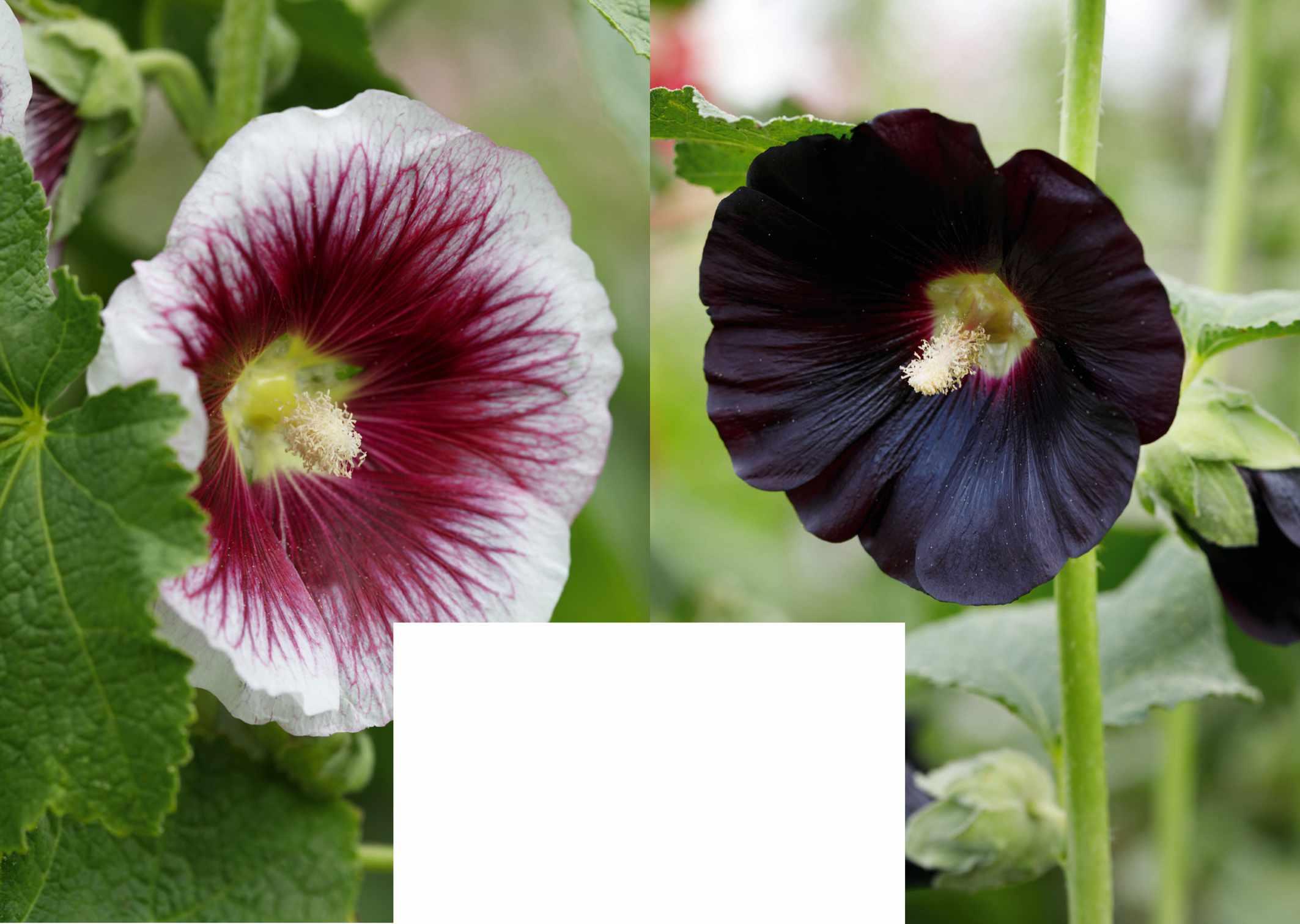
Then there are the beautiful deep maroons, dark enough to appear almost black. I tend to choose the nectar-rich, single-flowering cultivars for my work, though there’s also a range of interesting doubles too, many of which were bred in the mid-1800s. It was back then that a handful of nurserymen had started to make serious attempts to produce new hollyhock cultivars. One of those nurserymen was William Chater who succeeded in creating a strong strain of doubles that bear his name to this day in the Chater’s Double Group.
In 1873, however, Chater and his fellow nurserymen were challenged by the arrival of a pathogenic fungus called Puccinia malvacearum. This causes rather unwelcome orange pustules to form on the leaves of hollyhocks; in the Victorian era it was named the scourge and today we know it as rust disease.
Because rust is still with us it’s important to seek out strong, vigorous hollyhock cultivars, so when signs of rust do appear it remains a minor cosmetic issue and can be handled with a few pragmatic tips (see How to grow on page 57). It’s for this reason I visited Jonathan Sheppard’s National Collection of Alcea, which offered an opportunity to compare health and growth habits of a range of cultivars all within a two-acre plot.
A few stood out as being particularly strong and healthy. The fig-leaved cultivars, such as Alcea ficifolia pink flowered and Antwerp mixed were
To continue turn to page 59
Alcea rosea ‘Nigra’
Alcea rosea ‘Blackcurrant Whirl’
�eir slightly intangible, fairy-tale quality is one reason I always include hollyhocks in gardens
JULY 2022 GARDENSILLUSTRATED.COM 55
JONATHAN BUCKLEY / GAP PHOTOS.
Alcea rosea Chater’s Double Group salmon-pink-flowered Bred by William Chater in the mid 19th century, this apricotflowered cultivar, and the similarly coloured, A rosea Chater’s Double Group chamois, appeal to florists. The doubles can be slower growing to start with, but soon catch up. 1.8m x 60cm.

Bred by Jelitto, this seed mix produces flowers in a variety of colours, including chestnut brown, red, pink, yellow, copper and white. A little shorter than many other hollyhocks, but it is also possibly hardier. 1.6m x 60cm.

If you’re looking for a seed mix in soft, pastel colours, this is a great option to go for. Technically a short-lived perennial, its flowers come in more muted shades of pink, yellow, rose and red as well as white. 1.8m x 60cm.
How to grow Alcea
• Hollyhocks grow best in a sunny position, in a range of growing media from well-drained fertile soil, to gravel paths and cracks in paving. Although they can grow well on exposed sites, some shelter can be beneficial to prevent them being rocked over in strong winds.
• Hollyhocks are easily grown from seed. I treat them as biennials by sowing fresh seed each year during May or June. Sowing at this time of year gives them plenty of time to grow a substantial plant and a strong root system, both of which will be needed to produce those huge spires of flowers the following year.
• If you have a spare patch of ground, the seed can be sown directly. However, if your garden is full, as is likely the case in early summer, they can be sown into pots. Jonathan’s technique is to sow two seeds into peat-free compost in 7cm or
9cm pots, bumping them up into larger 1L pots if needed before space becomes available in the garden.
• Puccinia malvacearum, also known as hollyhock or mallow rust, is a fungus that attacks plants within the Malvaceae family and is characterised by orange to yellow spots on lower leaves. It’s best to take a pragmatic approach to dealing with rust: expect it to show up at some point and use some of the chemical-free methods below to keep it to an absolute minimum. “Rust is just one kink in the hollyhock’s armour,” says National Collection holder Jonathan Sheppard. “It’s no reason to be put off growing them.”
• You can minimise the risk of rust by choosing cultivars or seed mixes that are known to be vigorous and healthy, and treating them as biennials. Although many cultivars are technically short-
lived perennials, on the whole they tend to be more resistant to rust in their first year of growth. So by treating them as biennials and replacing plants each year, the likelihood of rust is reduced.
• One common piece of advice is to increase airflow. This works well for plants that have self-seeded into gravel and paths, but when growing them in borders among other plants, good air flow can be harder to provide. In this case it is often easier to position hollyhocks behind other plants, which will hide any blemished leaves.
• If you do spot signs of rust remove any infected leaves and make sure they don’t get into your compost heap as the spores will survive over winter and find their way back to your garden. If possible water at the base of the plant, not the leaves as spores can be spread by water splash.
Alcea ficifolia ‘Las Vegas’
Alcea rosea ‘Simplex’
JULY 2022 GARDENSILLUSTRATED.COM 57
Alcea ficifolia
pink flowered
Commonly known as the fig-leaved hollyhock thanks to its palmate leaves, which resemble those of fig plants, Alcea ficifolia originates in Iran and is a strong, healthy species. 2m x 60cm.
Alcea biennis
This Turkish species, often referred to as Alcea pallida is a particularly beautiful plant with lavender-pink flowers that have scalloped petals. It is considered to be very resistant to rust and self seeds generously.
1.8m x 75cm.
Alcea rosea ‘Lemon Light’
A strong-growing cultivar with blooms that are a soft shade of primrose yellow. It works well with A rosea ‘Halo White’, which has white flowers with a pale-yellow centre that picks up on ‘Lemon Light’. 1.9m x 70cm.

Alcea rosea giant single mixed
This is the seed mix to choose if you want to achieve the quintessential cottage-garden look in a full array of colours from pale pink to maroon. Vigorous, strong-growing plants. 2.4m x 60-80cm.
Not available to buy just yet but hopefully will be in the years to come. The unusual salmon-pink semi-double blooms are from a selfseeded plant in Jonathan’s garden, and he’s now working to isolate the flowers and save seed. 2m x 1m.
This white-flowered species from Afghanistan to China is similar in appearance and growth habit to Alcea rosea. It is rare in cultivation but I think the simple, purewhite flowers make it an elegant addition to the garden. 1.5m x 40cm.

billowing out of their beds. Plants bred from A ficifolia are well known for their rust resistance, and although a few small signs of it were present, the overall vigour of the plants made it relatively inconsequential. It was also notable that the seed mixes such as A. ficifolia ‘Las Vegas’ and A. rosea giant single mixed were particularly robust and healthy. Of all the individual culitvars, ‘Lemon Light’ stood out for its overall size and quality, and is one I’m using in a cutting garden I’m currently designing, where the overall palette is made up of soft and muted tones.
Hollyhocks can be grown to great effect in several different ways. One of the loveliest I’ve seen is in the Chatsworth Kitchen Garden, where gardener Stefan Homerski scatters spare seed over an otherwise bare area of gravel. The strongest thrive and grow to great heights, drawing much admiration from visitors. If space is limited, cultivars from the Halo Series are an excellent option as they grow smaller than many of the others, and would even be worth trying in pots if you have little or no garden at all.
Within a larger setting I like to plant hollyhocks as individuals or in small groups behind other plants such as grasses, dahlias or roses. They shoot up above the other plants as flowery punctuation marks, creating a visual link throughout the garden, holding on to their upper-most flowers until autumn. Jonathan has a lot of spare seed,
Where to see and buy
which he broadcasts into the wilder perimeters of his garden where they try their luck against the grasses and weeds, creating a beautiful, pollinator-nourishing meadow-style planting; an ornamental imitation of their wild origins. No matter how you grow hollyhocks, you and the insects will be generously rewarded. n
Becky Crowley is a garden maker, flower grower and flower artist.
• Chiltern Seeds Crowmarsh Battle Barns, 114 Preston Crowmarsh, Wallingford, Oxfordshire OX10 6SL. Tel 01491 824675, chilternseeds.co.uk
• Chatsworth Kitchen Garden Bakewell, Derbyshire DE45 1PP. Tel 01246 565300, chatsworth.org
• Claire Austin Hardy Plants White Hopton Farm, Wern Lane, Sarn, Newtown, Powys SY16 4EN. Tel 01686 670342, claireaustin-hardyplants.co.uk
• Jelitto Perennial Seeds info@jelitto.com
• Jonathan Sheppard* The Poplars, Welbourn Road, Brant Broughton, Lincolnshire LN5 0SP. britishhollyhocks.wordpress.com Email jonathan@crossbenchcommunications.com to arrange a visit
*National Collection holder.
Alcea ‘Sheppard’s Delight’
Alcea nudiflora
JULY 2022 GARDENSILLUSTRATED.COM 59
Hollyhocks shoot up as �owery punctuation marks, holding on to their upper-most �owers until autumn
MANY THANKS TO JONATHAN SHEPPARD IN WHOSE LINCOLNSHIRE GARDEN THE MAJORITY OF THESE IMAGES WERE TAKEN
HORTICULTURAL WHO’S WHO
VANESSA EASLEA
The former investment banker and current chair of the Working For Gardeners Association on her own change of career and how Covid has led to a national reassessment of our working lives
The past few years of working disruption have seen many reassess their working lives and reconsider their careers, something Vanessa Easlea, chair of the Working For Gardeners Association (WFGA) knows all about. “I used to work in investment banking covering Asia, and travelled a huge amount, so I could only garden at the weekends. I would go into work at 6.30am and come home at 6.30pm, but any spare moment I had I would sit in the trading room and think about roses.”
The WFGA was once known as the Women’s Farm and Garden Association, and is best known for helping women into professional horticulture, a career path traditionally dominated by men. Its flagship scheme is WRAGS or Work and Retrain as a Gardener Scheme (formerly Women Returners to Amenity Gardening Scheme), in which career changers can dip their toe in the career-changing waters with a paid parttime placement under a head gardener.
An upheaval in her early fifties led Vanessa to become a WGFA member in 2003. “It was time to reassess my life. I joined the WGFA and got even more hooked on gardening, spending a lot of time visiting gardens and doing the WGFA workshops on how to set yourself up as a self-employed gardener, among other topics. It struck me that maybe this was something I could do professionally.” In 2013 she became a trustee of the charity, and decided to apply for a placement. The charity found here a WRAGS placement at Chenies Manor in Hertfordshire, two days a week, and she went part time at the bank. “It was physically hard, especially the first few weeks. It’s such a huge change from an office job. But that’s why the scheme works so well. It’s part time, and paid, so you can try it without sacrificing everything else. You’re not starting in a classroom and thinking ‘I could do this’ and then getting into a job and finding that it’s too physical, that working out in the elements is too tough, that it’s seven hours a day out of doors and it’s too much.”
For Vanessa it worked (although, she says, “I really ached for a few weeks”), and at the end of her placement she resigned at the bank, and became a full-time gardener. In 2017, she also became chair of WFGA, and set about helping this 120-year-old organisation to modernise. The name change was a controversial one, with many different opinions among the membership, which was polled before it was carried out. The organisation has an incredible history, supporting women into horticulture since 1899 and helping to establish the Women’s Land Army in the First World War. “The
problem was we had become all about the history, and I wanted us to reposition ourselves so that people would understand that we were the solution to a very modern problem. We also had men applying for WRAGS and we wanted to be able to open up to them.” The name change was approved by the membership and now around 15 per cent of members are men. She has also pushed the organisation forward with a new website and a social media presence, and forged links with the Royal Horticultural Society and National Garden Scheme. “We needed to start talking to other organisations. We have a unique offering and people are pleased to help us promote it.”
Then, when Covid hit, and many people had time to look at their lives and their careers, the WGFA saw a huge increase in membership. “During Covid everybody suddenly wanted to become a gardener. Our membership shot through the roof, because everybody wanted to learn more about their own patch or start growing, and many also wanted a career change.” Graduates of the scheme have gone on to run their own garden business, work in plant nurseries and become head gardeners.
There is now often a waiting list for placements, particularly in urban areas. “Nurses, police, civil servants, lawyers, accountants, lots of different professions are wanting to move into horticulture. There’s been a sea change,” says Vanessa. The WFGA is perfectly placed to help them, but the challenge now is finding enough gardens to fulfil demand. “I would love to encourage any large gardens to consider it. We ask that they pay the National Living Wage, and in return they get support from us and a really enthusiastic trainee, someone who is keen, and will work really hard. Career changers bring so much to the gardens they work in.”
This is something Vanessa has proved herself. After her initial year at Chenies Manor she was taken on one day a week, and has since built up her own gardening business, planting up and caring for local gardens (“I often walk to them, with my trolley of plants and tools,” she says) as well as volunteering at Horatio’s Garden, RNOH Stanmore, where she helped plant up Tom Stuart-Smith’s design. “Changing careers has been wonderful for me,” she says. “Following my heart to work with plants was the right thing to do.” n
USEFUL INFORMATION
The WFGA offers workshops, garden tours, practical skills days, access to horticultural jobs, access to bursaries to support career development. For more information visit wfga.org.uk
I WOULD GO INTO WORK AT 6.30AM AND COME HOME AT 6.30PM, BUT ANY SPARE MOMENT I WOULD THINK ABOUT ROSES
WORDS LIA LEENDERTZ PORTRAIT ANDREW MONTGOMERY
60 GARDENSILLUSTRATED.COM JULY 2022

JUNGLE GIANTS
Arow of terraced houses in suburban Surrey provides the unlikely setting for a truly extraordinary garden. Hidden in a valley just behind them lies a tropical forest of leafy bananas, palms, cannas, bromeliads and angel’s trumpets dripping with fragrant yellow lanterns – just some of the delights that await visitors to Jack Salway’s botanical masterpiece.

A former senior lecturer in medical biochemistry, Jack and his wife Nicky moved to the beautiful village of Chiddingfold 45 years ago. “I was looking for a garden with a house in it,” he says. “So, when we found this property with three-quarters of an acre of land, it ticked the box perfectly. The previous owners kept goats and chickens on the land, but most of it was covered with brambles and saplings when we arrived. However, I felt it had potential, though I didn’t have an exact plan at the time.”
Jack says his love of gardening is in his DNA: his grandfather was a head gardener, and his first memories are of his Aunt Lilla showing him how to sow seeds and telling him about her plants. He went on to study A-level botany and biochemistry at university, and now uses the garden as his laboratory, testing the tender plants
he grows in the variety of soils and microclimates it offers. Set in a narrow combe, it’s carved out of a sandstone ridge with clay below, which Jack has terraced and improved with compost and stable manure. His first experiment was with gunneras, planted in the boggy floor, while regular trips to nearby RHS Garden Wisley fuelled more ideas. “Wisley had a few subtropical plants tucked away behind the glasshouses, which tempted me to try cannas and bananas, and gradually the theme evolved.”
The garden begins in what is known as Nicky’s garden, the more conventional flower-filled plot Nicky tends close to the house. Taking a right turn along a narrow path, you then enter the tropical garden, first passing alongside Jack’s prized greenhouses, where he overwinters vulnerable plants and raises annuals from seed. Peering over a wooden handrail along the path, you look down from this vantage point into the layered storeys of lush foliage and colourful dahlias, cannas, and crinums below.
The path then opens out on to a range of hot, dry terraces set on the ridge of the combe, which homes Jack’s succulent collection of bushy Kalanchoe thyrsiflora, the crimson bromeliad Fascicularia bicolor and jewel-bright gazanias, together with tall Verbena bonariensis, the exquisite peacock tiger flower Tigridia
*Holds
available. 62 GARDENSILLUSTRATED.COM JULY 2022
an Award of Garden Merit from the Royal Horticultural Society.†Hardiness ratings given where
Jewel florals and towering plants thrive in the moisture-rich climate of a suburban Surrey valley garden created by plant adventurer Jack Salway
WORDS ZIA ALLAWAY PHOTOGRAPHS CAROLINE MARDON / GAP PHOTOS
Left The path is edged with the dramatic leaves of a Darjeeling banana Musa sikkimensis, darkleaved Canna x generalis Cannova Bronze Scarlet (= ‘Fcaa35’) and a mutant of Canna ‘Cleopatra’, together with Dahlia ‘Danum Torch’ and nasturtiums.


Right Jack uses plants in vibrant shades, such as this Canna ‘Orange Punch’, as focal points to guide the eye through a backdrop of foliage towards the golden stems of Phyllostachys vivax f. aureocaulis

Below (from left) Dahlia ‘Danum Torch’ is a tall, eye-catching dahlia with green leaves and collarette red flowers edged with yellow brushstrokes. 1.7m.
RHS H3† Tigridia pavonia has flowers that last just one day but are produced in succession in summer.
60 x 10cm. RHS H1C. Ipomoea lobata or Spanish flag is an annual climber with bright yellow and red flowers over lobed leaves. Grow it in full sun on free-draining soil. 4m x 50cm. AGM*. RHS H1C, USDA 10a-11.
IN BRIEF
What A jungle-themed garden inspired by a love of tender and exotic-looking plants. Where Surrey.
Size Three quarters of an acre.
Soil Sandy and friable clay over a substrata of stone and clay, improved with compost and composted stable manure.
Climate Temperate, in an area of a sheltered valley that is protected from cold winds and hard frosts.
Hardiness zone USDA 9.
pavonia and an array of other drought-tolerant plants. Descending into the cooler valley where rain drains off the hillside, Jack has planted his favourite annual climber, the aptly named Spanish flag (Ipomoea lobata), with its spikes of small yellow and crimson flowers fluttering in the breeze.
“I grow it each year, soaking the seeds to coax them, although only about ten per cent germinate,” says Jack. “I combine it with Dahlia ‘Danum Torch’ and Canna ‘Cleopatra’, which produce flowers in complementary colours.” He adds that gardening on this precipitous slope is not always predictable and, one year, a storm caused a huge landslide of liquid slurry to race down the hill. Undaunted, Jack viewed this event as an opportunity rather than an obstacle, and promptly planted up “the nice shoulder” it created with cannas and bananas.

The garden winds down through a labyrinth of tree ferns (Dicksonia antarctica), purple leaved Ricinus communis ‘Gibsonii’ and stands of the dramatic Colocasia esculenta, with its shieldsized green foliage. Usually grown as a houseplant, Colocasia thrives outside in summer, and provides a cool foil for the army of pinstriped cannas such as ‘Durban’ and ‘Bethany’ that jostle for attention. While the jungle garden is testament to Jack’s scientific skills, he is also a talented artist, creating a canvas of bold foliage
colours, textures and shapes, overlaid with intricate and vibrant blooms that shine out against the leafy backdrop.
A natural stream flows along the bottom of the valley and, capitalising on the damp conditions in this part of the garden, Jack has created three ponds for aquatics, including water lilies, water hawthorn (Aponogeton distachyos) and the alligator flag (Thalia dealbata), as well as resident fish and frogs. He has also installed a deck, a place where he can sit and enjoy his morning cup of coffee to the sound of the birds and bees that share his love of the garden.
Caring for tender plants is a challenge that Jack relishes, but he says overwintering some inside is no longer required as climate change brings warmer conditions. “During recent winters, temperatures here only get down to -1°C or -2°C, so I can get away with a thick mulch over the dahlias and some of the cannas. Other plants, such as the ensetes and colocasia are brought undercover.”
Although Jack maintained his Surrey garden single-handed for many years, he now has help from garden designer Abby Grainger, who also suggests new plants for him to try. “I’m learning all the time,” says Jack. “And it’s great to have Abby working with me and offering ideas. We’re a team and our plant adventure constantly delivers new surprises.” n
64 GARDENSILLUSTRATED.COM JULY 2022
A canvas of bold foliage... overlaid with intricate and vibrant blooms shines out against the leafy backdrop
Right Jack has included hardier plants such as Crocosmia x crocosmiiflora and Rudbeckia fulgida var. sullivantii ‘Goldsturm’ which enjoy the same conditions as the tender types, but require less maintenance, since they can stay put over the winter.

Below (from left) Eucomis pallidiflora subsp.
pole-evansii produces large, handsome foliage and spikes of small greenish-white flowers topped with tufts of leafy bracts. 1.8m x 20cm.Canna
‘Cleopatra’, is a chimeric form with chocolate and green leaves and red and yellow flowers. 1.2m x 60cm. RHS H3, USDA 7a-11. Colocasia esculenta
‘Jack’s Giant’ has huge heart-shaped leaves that add a dramatic touch. 1m x 1m.
Left Midway down the terraced hillside, the welldrained soil conditions provide the perfect home for tender dahlias and cannas, while moisture-loving gunneras thrive in the valley below.
The secret garden
IN BRIEF
What Relatively recent garden created within the grounds of an 18th-century estate, mixing both formal and informal planting. Where North Wales.
Size Approximately three acres. Soil Good quality loam sitting on river shingle, which provides good drainage; a neutral to alkaline pH.
Climate Sheltered from the worst of the wind and rain by Snowdonia to the west. The walls create their own microclimate but frost pockets can be a problem. Hardiness zone USDA 8.
The Walled Garden’s borders brim with the romantic cottage garden-style planting Tom and Jenny love, where a calming pastel palette of Alchemilla mollis, Lychnis coronaria ‘Alba’ and Centranthus ruber ‘Albus’ sits within a formal framework of yew hedging.

Tom and Jenny Williams used reclaimed landscaping materials to give their new garden authenticity and a sense of history
WORDS LOUISE CURLEY PHOTOGRAPHS JOE WAINWRIGHT

JULY 2022 GARDENSILLUSTRATED.COM 67
The resourceful owners of this Welsh garden have created a magical place with a timeless quality that befits the historic setting. High, old walls surrounding a garden would be top of many a gardener’s wish list, providing privacy, a microclimate and bucket-loads of character.
Those at The Laundry near Denbigh in north Wales date back to 1770, when the Grade II-listed house was once the dairy and laundry for the adjacent Llanrhaeadr Hall. When Tom Williams inherited the property and land, he and his wife Jenny set about transforming the higgledy-piggledy plots that were dotted around the site.
The Laundry Garden is made up of three main sections: the several areas closest to the house, which are collectively known as the House Garden, the Walled Garden and a patch of woodland. “We were lucky to have lots of walls, so we already had predefined spaces and didn’t have to think about creating boundaries,” says Tom, who is a builder.
Tackling the areas closest to the house first, the couple took the bold decision to completely remove the aged cottage garden that was already there.
“I think some gardens can get stuck in such a rut as their owners try to work around what’s already there, instead of just starting again,” says Jenny.
It’s hard to believe that the stone terrace with its box parterre, the oval lawns hugged by curving beech hedges and billowy herbaceous borders are just ten years old, such is Tom and Jenny’s attention to detail and assiduous use of reclaimed landscaping materials. “We’ve had to be thrifty, doing what we can, when we can, including reusing stone and slate that was already on site. I don’t like things that look new, and our approach has meant that everything looks like it’s always been here,” says Tom.
The area at the back of the house overlooks the old Hall, now a nursing home. “We couldn’t work out what to do with the space, we just knew we wanted some privacy and somewhere beautiful to look at from the kitchen,” says Jenny.
A visit to Allt-y-bela in Monmouthshire, the home of renowned landscape designer Arne Maynard, provided inspiration. Tom and Jenny were particularly taken by his use of pleached crab apples. The Hall Garden is now a courtyard space with cobbled paths painstakingly laid by Tom, yew hedging, planting pockets and a striking pleached circle of the crab apple Malus ‘Evereste’, which is covered in white
Above left The border known as Regent Street was riddled with ground elder, so Tom dug down around a metre, replacing the old soil with fresh topsoil. A wisteria now covers the stone wall and self-seeding foxgloves intermingle with a mix of shrubs such as Cotinus coggygria ‘Royal Purple’ and Rosa Darcey Bussell (= ‘Ausdecorum’).
Above right Tom and Jenny embrace selfseeders for the informal feel they give the garden. In the Hall Garden, Linaria purpurea, Nigella damascena and fennel emerge above a carpet of aromatic herbs, which spill over the winding cobble path laid by Tom.

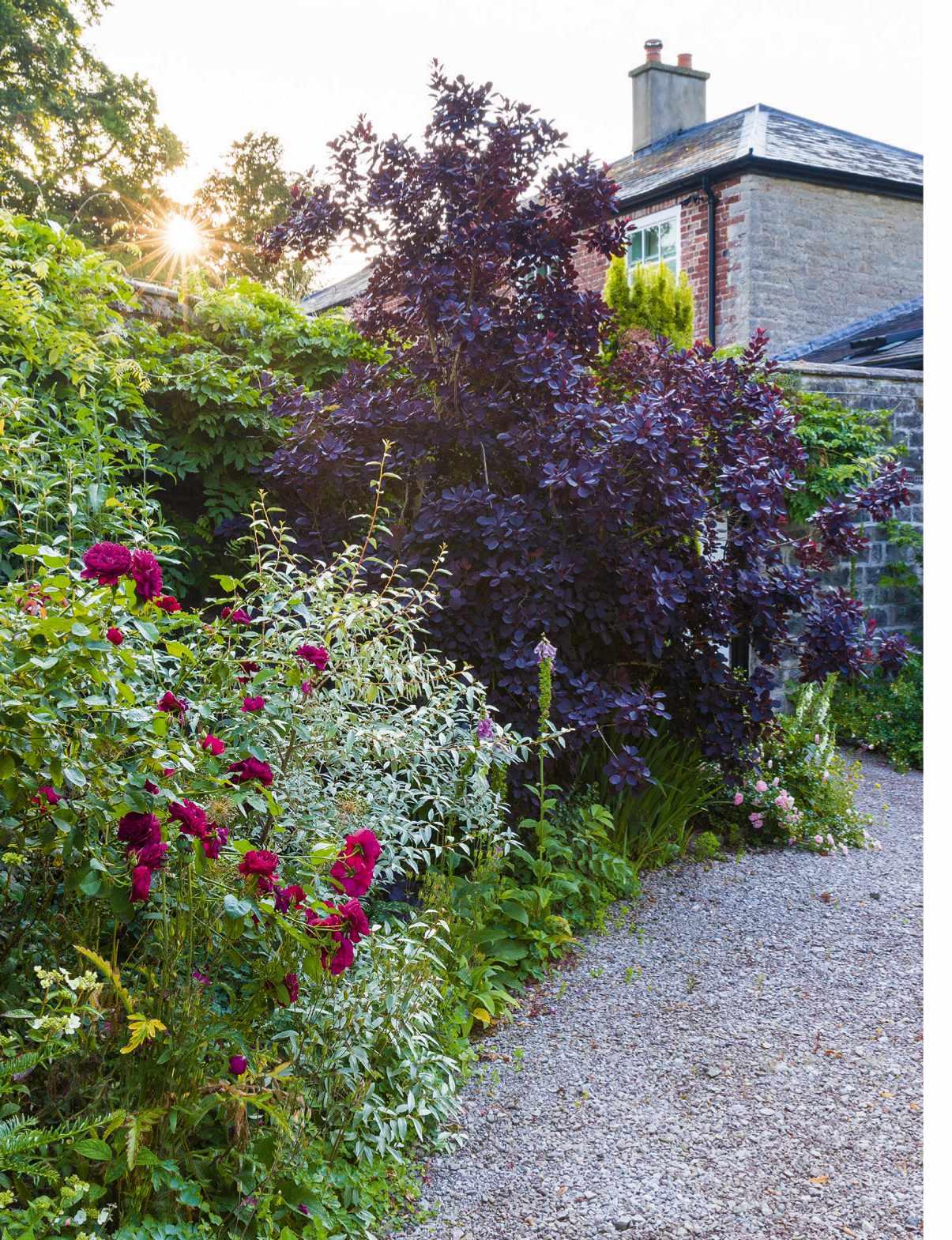
Right above In the Walled Garden the westfacing border features the repurposed stone pillars from the old Hall. These lend height and scale to the one-acre space, as does a row of clipped Prunus lusitanica underplanted with an annual seed mix that includes calendula and poppies to provide a contrast to the formality of the trees.
Right below A curving border in the House Garden leads past a silver-leaved, weeping ornamental pear to a wirework gazebo nestled in a sheltered spot and clad in the fragrant, buttery-yellow blooms of the climbing rose R. The Pilgrim (= ‘Auswalker’) and the violet-blue flowers of Solanum crispum ‘Glasnevin’.
68 GARDENSILLUSTRATED.COM JULY 2022
We don’t really have holidays. We’ve put so much care and love into this garden, why would we want to leave it


blossom in spring and miniature red apples in autumn and winter.
Hidden behind an arched, wooden door in a red brick wall lies the jewel in the crown of The Laundry: a one-acre Georgian Walled Garden, which would have once provided fruit and vegetables for the Hall. “While the different areas that make up the House Garden felt manageable, we put off touching the Walled Garden for some time, the scale of it was so daunting,” says Tom. “We used to walk in there and get that awful butterflies feeling and then walk out again. It was our local National Garden Scheme co-ordinator who persuaded us to tackle it. We were planning to open the rest of the garden in 2013, but she was keen to see what we’d done in the Walled Garden, but at that point it was just a field.
“As with the rest of the garden I knew, with my builder’s hat on, that we needed to get the bones of the garden in place first,” says Tom. “We looked at old maps and they gave us a clue as to where the paths should be, and as we dug we uncovered the original slate edging.”
But what to do with the four-metre deep borders they’d now created? “All that bare soil was petrifying,” says Jenny. “I would visit other walled gardens to see what they had done, and if there were elements we could implement here. I pored over

magazines and books. Sissinghurst gave me lots of ideas, as did visits to Arabella Lennox-Boyd’s garden at Gresgarth Hall.”
To make the task more manageable, the couple started with the west border first, dividing it into two sections separated by a terraced seating area with four tall stone pillars. “These were once part of the porch on the main Hall, but in the 1950s my grandfather pulled them down and they lay around for nearly 70 years before we found a use for them,” says Tom. Jenny set about planting the backbone of the border with ceanothus, cotinus and gleditsia, then a gardening friend of Tom’s parents asked if they’d like to dig up her blue border. They leapt at the chance, coming home with herbaceous perennials to fill in the gaps.
The garden is still evolving with plans for a greenhouse and a Mediterranean garden along the sun-baked south wall. “We don’t really have holidays,” says Jenny. “We’ve put so much care and love into this garden, why would we want to leave it.” n
USEFUL INFORMATION
Address The Laundry, Llanrhaeadr, Denbighshire LL16 4NL.Tel 01745 890515. Web thelaundryretreat.co.uk
Open 24-25 September; by appointment for groups of ten or more, and to guests staying in the B&B or roundhouses.
Training trees
Trees can be manipulated to grow in controlled ways to create living sculptures with practical uses, with Tom teaching himself to train various tree features in the garden.
A pleached lime avenue was planted using 3m whips. Tom created a metal framework, then every branch that was superfluous to the required shape was removed, as was the leader. In late autumn and spring he ties or weaves the branches into place and prunes anything else. After six years the structure was strong enough and the metal frame removed. Near the house, a circle of pleached Malus ‘Evereste’ (above left) encloses an area of cobble, slate and millstone laid by Tom and edged with Erigeron karvinskianus. The crab apple has a frame made from bamboo from Tom’s parents’ garden, which he cut and used while it was still pliable enough to bend into a circle. The crab apples are pruned in late summer back to the frame to form spurs that will produce more flowers and fruit. Like the crab apple circle, the natural pergola (above right) is an idea borrowed from Arne Maynard. Tom and Jenny trained plane trees (Platanus x hispanica) to form this verdant roof, which provides shade at the hottest part of the day. It was planted with two opposite rows of three trees using a bamboo frame. The lower branches were removed and the higher branches carefully bent and tied down to form the ‘roof’. Tom prunes in winter when he can see the leafless structure and ties in branches to create a mesh of growth.
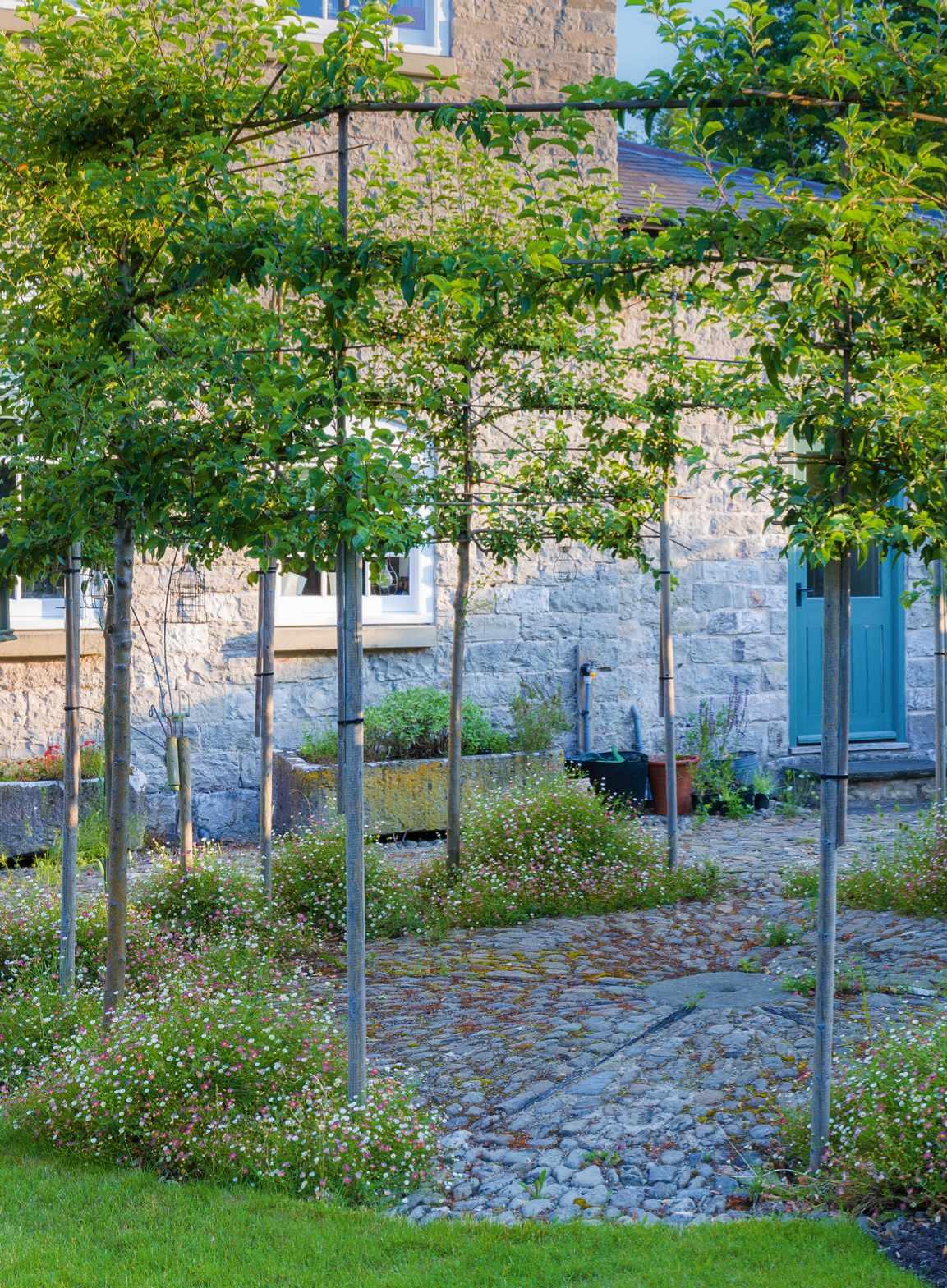
70 GARDENSILLUSTRATED.COM JULY 2022
8 of Tom and Jenny’s key plants
1 Centranthus ruber ‘Albus’ The white form of valerian with grey-green leaves and clusters of tiny flowers, which are a magnet for pollinators. 75cm x 50cm. RHS H5, USDA 5a-8b †
2 Geranium pratense ‘Summer Skies’ Hardy geranium that has masses of ruffled pale-lavender, double blooms throughout summer. Its trailing habit makes it ideal for edging paths. 75cm x 75cm. RHS H5, USDA 5a-8b.
3 Rosa ‘Chevy Chase’ Grown on the Walled Garden’s west wall, this rambling rose makes a spectacular sight in early summer with its deep-red flowers. 4.5m x 3m. RHS H6, USDA 5a-9b.
4 Rosa Joie de Vivre (= ‘Korfloci 01’) Floribunda rose with neat habit and clusters of scented, peachy-pink blooms borne in flushes from June to September. 60cm x 45cm. AGM*. RHS H6, USDA 5a-9b.
5 Rosa Darcey Bussell (= ‘Ausdecorum’) Compact, repeat-flowering shrub rose with a profusion of fragrant crimson flowers that take on purple tones with age. 1m x 1m. AGM. RHS H6, USDA 5a-9b.
6 Persicaria microcephala ‘Red Dragon’ A vigorous spreading perennial with eye-catching, red-purple leaves splashed green and silver; slender stems of tiny white flowers emerge in late summer. 50cm x 1m. RHS H5.
7 Nepeta racemosa ‘Amelia’ This compact catmint has aromatic, grey-green foliage and arching stems studded with pale-pink flowers from May to September. 80cm x 75cm. RHS H7, USDA 4a-8b.
8 Erigeron karvinskianus Used under the pleached crab apples, Mexican fleabane forms frothy clumps of white and pink daisies from May to November. Self-seeds readily and thrives in dry, poor soil. 50cm x 50cm. AGM. RHS H5, USDA 6a-9b.
*Holds an Award of Garden Merit from the Royal Horticultural Society. †Hardiness ratings given where available.

1 2 4 5 6 7 8 3
With its box-edged beds, topiary and abundant planting, Abi and Tom’s is an inspiring garden as well as a working nursery. In the early morning quiet, the gravel paths and pillar-box red shed are seen through pink clouds of Eupatorium cannabinum, waving grasses and bronze fennel.
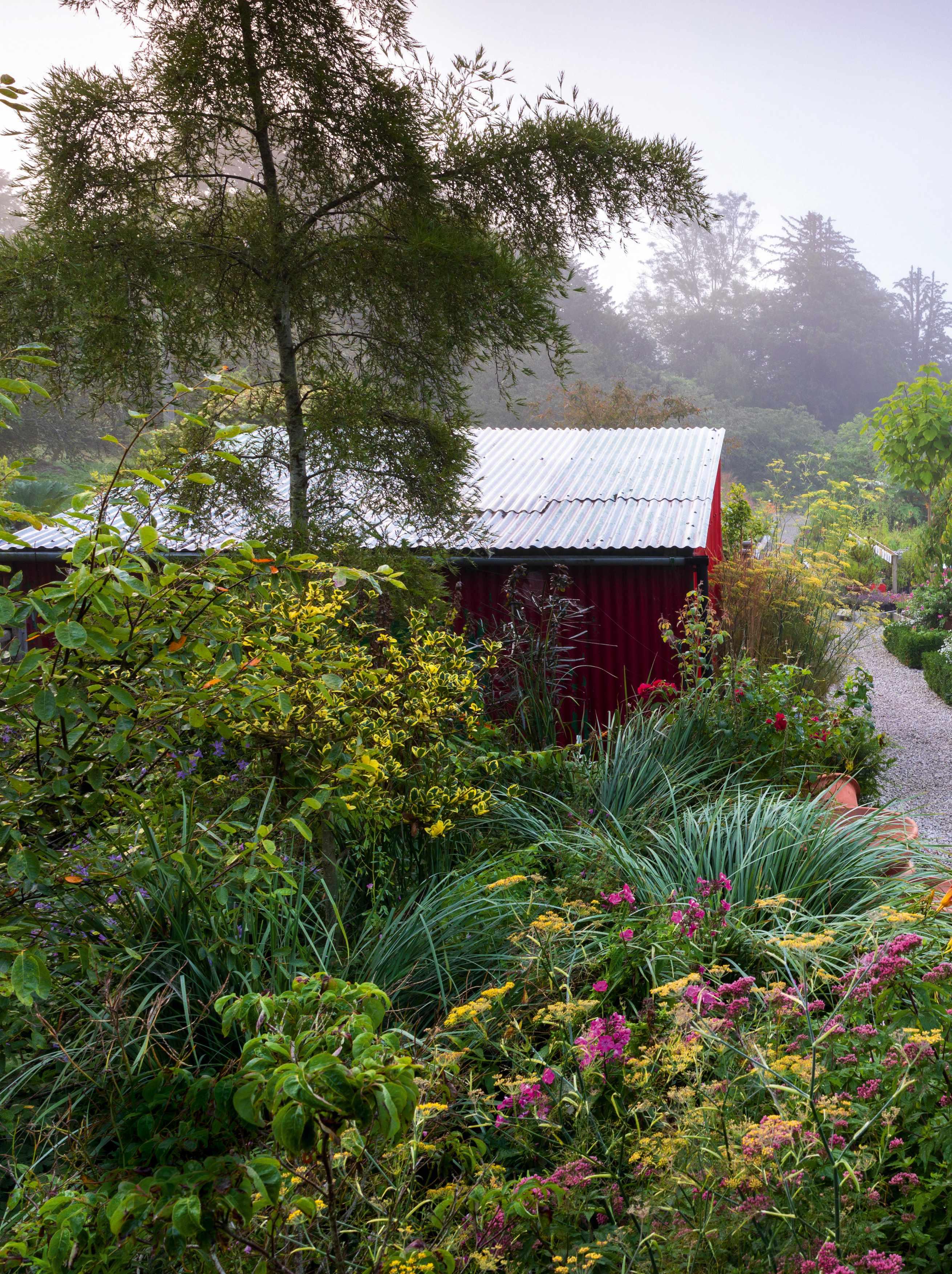
72 GARDENSILLUSTRATED.COM JULY 2022
Growing together
Visiting Abi and Tom’s nursery is as engaging as hanging out in the garden with a pair of plant enthusiasts eager to share their knowledge and love of horticulture
 WORDS SUSIE WHITE PHOTOGRAPHS RICHARD BLOOM
WORDS SUSIE WHITE PHOTOGRAPHS RICHARD BLOOM
1 Throughout the nursery Abi and Tom have planted up containers with surprising combinations and quirky choices and dotted them around the space, such as this oval galvanised planter, which tones with the grey wood of a beautiful old bench. Light catches the tops of a variegated sea holly, Eryngium planum ‘Jade Frost’, its delicate, cream-edged leaves mingling with a pleasing fretwork of the darker purple spikes of Verbena rigida, anchoring the planter to its place.
2 A raised horseshoe-shaped border displays an explosion of exotic foliage, the neat curve containing the contrasting planting. Huge leaves of Musa basjoo and Tetrapanax papyrifer ‘Rex’ happily neighbour the intricate patterns of Begonia rex and the cascading blades of Astelia chathamica, while the eye darts to vivid dabs of apricot-orange from clusters of Ligularia dentata ‘Desdemona’.
3 Different-sized terracotta pots staged on a galvanised trough create an exuberant and quirky pyramid of planting. An ornate terracotta urn creates the focal point; silver-grey spikes of agave rising out of a froth of Mexican fleabane daisies give the impression of a water fountain.
4 A new twist on the traditional hanging basket, the curious purple flowers of Rhodochiton atrosanguineus tumble through variegated ivy and Bidens aurea
The complementary colours of purple and yellow are used subtly thanks to the small size of the flowers and are further softened by the delicate trails of ivy.
5 Two old farm troughs have been artfully arranged using contrasting foliage to create drama. The deeply cut leaves of Fatsia polycarpa rise above the frosted fern, Athyrium niponicum and serrated Kirengeshoma palmata. The quirky triangles of Persicaria runcinata ‘Purple Fantasy’ dance below a pot-grown rhododendron.
6 A greenhouse is used to overwinter potted bulbs and alpines or the tender display plants that stand outside in summer. Situated behind a wooden gate and partially obscured by floor-standing pots filled with dahlias and cannas, these are overarched by tall stands of Eutrochium purpureum and Rudbeckia laciniata ‘Herbstsonne’, creating a floral tunnel effect on the approach.

1 2 3 4
6
5
The ancient woodlands of south Cumbria flank the Whitbarrow escarpment and the land drops down to the sands of Morecambe Bay. Between forest and coast is a sheltered valley where Halecat House stands and here, surrounded by orchards, is Abi & Tom’s Garden Plants. Imaginatively laid out on a tricky site, the lush display beds and artful combinations of pots give a garden atmosphere to this working nursery.
“I used to come here with my grandparents,” says Abi Atwood. “It’s where they’d come to buy plants when I was a child.” Over the years, growers had run the two-acre nursery but it had deteriorated by the time she revisited the place with her husband Tom. “The stock beds had every pernicious perennial weed,” she says. “It was in a dreadful state, so overgrown and mad. Tom and I said to each other, ‘Wouldn’t this be amazing but you’d be an idiot to take it on.’”
Abi’s parents own Summerdale House, a garden and nursery near Carnforth and it was there that Abi worked after her biology degree at Oxford. Tom did a two-year HND in Plantsmanship at the Royal Botanic Garden Edinburgh – “The best possible introduction to the plant

world,” he says – followed by the Kew Diploma at the Royal Botanic Gardens, Kew. They’d both been hooked on horticulture since their teens so when Abi’s dad saw Halecat was for rent they just had to risk it.
Stock beds overrun with bindweed and an unusable bramble-covered slope made this a challenging site but it was good, slightly alkaline soil. They decided to take two years transforming it before opening in 2011. “It was real shoestring stuff,” says Tom. “We blew the bulk of our money in that first year, bulldozing, levelling and building a retaining wall into the slope. The sales beds were made using the dimensions of tanalised wood to make life easier. With very little money left over for our first years stock, we ordered a massive box of seed from Jelitto in Germany, growing one plug tray for selling and one for display borders.”
Today it is easy to be unaware of the site’s gradient because Tom and Abi have remodelled the slope so cleverly. Sales benches – raised squares incorporating central plantings – stand deeper on the downward side and gravel paths follow the contours. The working area of polytunnels and stock beds is tucked in at the lowest point, hidden by trees and abundant borders. By high summer the spring exuberance of
Abi and Tom Atwood have been hooked on plants since their teens. They love experimenting with the borders and sharing knowledge with visitors.
JULY 2022 GARDENSILLUSTRATED.COM 75
Imaginatively laid out on a tricky site, the lush display beds and artful combinations of pots give a garden atmosphere to this working nursery
8 FAVOURITE PLANTS
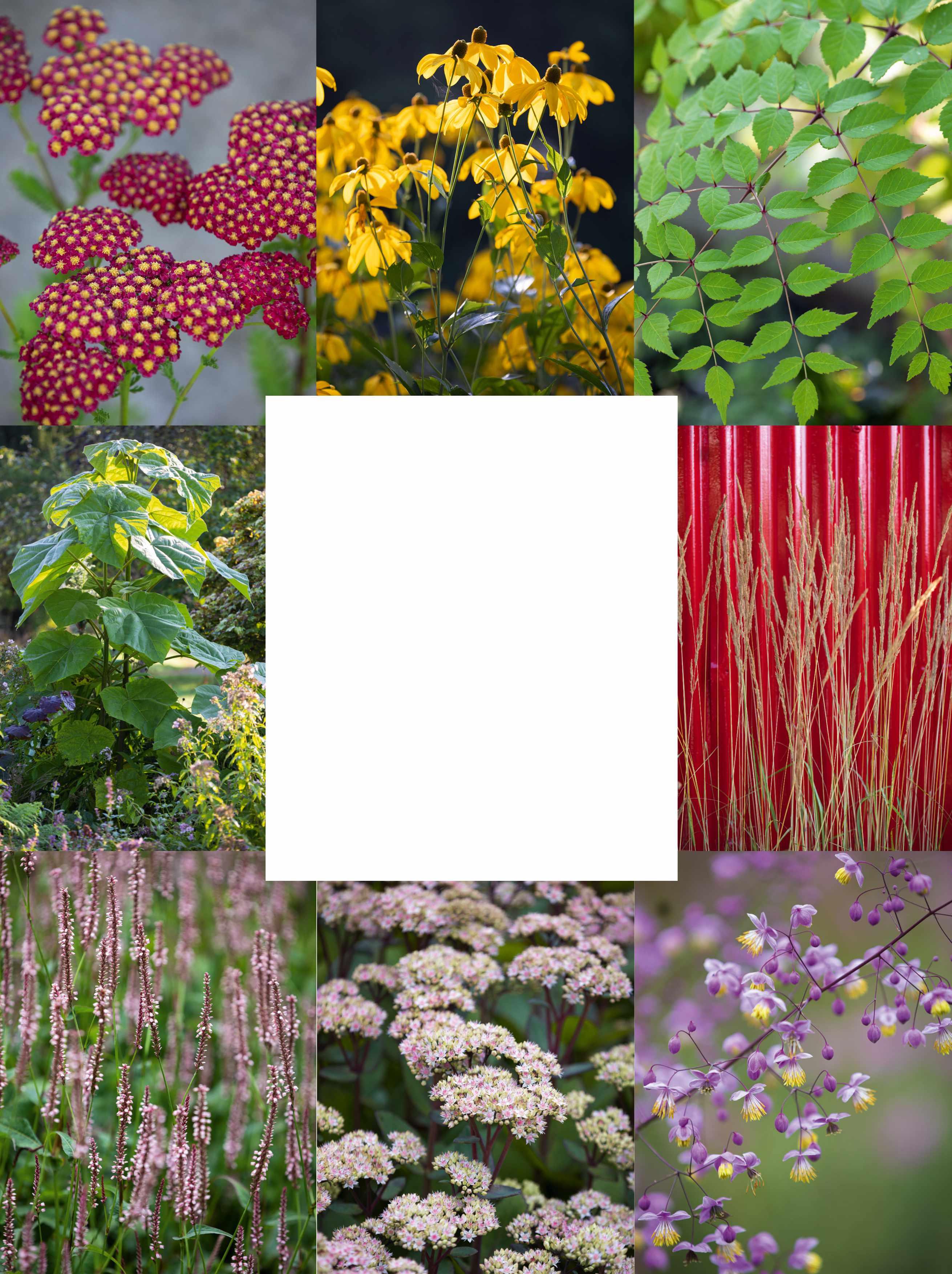
1 Achillea ‘The Beacon’ One of the most striking of all yarrows with yellowcentred crimson flowers and finely dissected leaves. Loved by pollinators, it makes a good cut flower. 75cm x 60cm. RHS H7, USDA 3a-8b †
2 Rudbeckia laciniata ‘Herbstsonne’ Tall and imposing, this vigorous perennial has daisy flowers with reflexed petals and chartreuse conical disks. Combines well with grasses. 2m x 90cm. AGM*. RHS H6, USDA 5a-9b.
3 Aralia elata The Japanese angelica tree is a deciduous shrub or small tree with thorny stems, pinnate leaves and large billowy panicles of creamywhite flowers. 5m x 3m. RHS H5, USDA 4a-9b.
4 Paulownia tomentosa The fast-growing foxglove tree with light lilac-purple flowers. Tom coppices his annually to produce extra-large, heart-shaped leaves for the tropical-garden look. Up to 12m x 8m. AGM. RHS H5, USDA 5a-8b.
5 Calamagrostis x acutiflora ‘Overdam’ Variegated feather grass with green-and-white striped leaves. Thin stems topped in narrow, purplish plumes turn biscuit-coloured in autumn. 1.2m x 60cm. RHS H6.
6 Bistorta amplexicaulis ‘Rosea’ With its fine wands of bell-shaped, soft-pink flowers, this easy-going bistort has a delightful airy looseness. Attracts pollinators especially hoverflies. 90cm x 90cm. RHS H7.
7 Hylotelephium telephium ‘Strawberries and Cream’ A lovely clump-forming orpine, which Tom and Abi use in their planters, valuing its purple-tinged leaves and sprays of starry pink-and-white flowers. 50cm x 50cm. RHS H7, USDA 3a-9b.
8 Thalictrum delavayi Delavay’s meadow rue is an elegant perennial that throws up delicate sprays of lilac flowers with cream stamens above blue-green leaves. Floats cloud-like above a border. 1.2m x 50cm. RHS H7, USDA 4a-7b.
*Holds an Award of Garden Merit from the Royal Horticultural Society. †Hardiness ratings given where available.
1 2 4 5 6 7 8 3
cottage perennials and massed tulips has given way to a more exotic mood. Languid banana palms arch over fiery coleus and bronze canna leaves. Coppiced paulownias stand tall above silver Plectranthus and spiky agaves. Shuttlecock ferns splay open gracefully around a stumpery next to a cast-iron fern bench.
“We live in a flat in the house so the nursery is essentially our garden,” says Abi, “This is the place where we can indulge all our plant passions. We experiment with borders and rotate our seasonal collections of pots to keep things fresh. In the beds around the pond we grow semi-hardy varieties that we cajole through the winter in the greenhouse.”
“This is a frost pocket though,” says Tom, “So locals know the plants we sell are tough. We grow 1,200 perennials. Plant choices are based not only on their own merits but on how they might combine with others.” When customers want help they ring a bell that hangs on a corrugated iron shed, exhilaratingly painted in pillar-box red.
Tom and Abi’s private garden sits behind a paling fence, the perfect place to relax with their young children, Esther and Rowan. There’s a wooden
Raised vegetable beds packed with edibles for the family are enlivened by colourful annuals. In this, their private garden, a magnificent bug house gives their children a chance to learn about wildlife.

summerhouse, raised beds of vegetables intermixed with bright annuals and a magnificent bug house. The owners of Halecat House, from whom they lease the nursery, put up an open-sided barn using estate oak where a tame robin shares lunchtime crumbs.
Beautiful hand-hewn entrance gates and cleft oak fencing were made by a local woodsman, while Abi laid a neat brick path beneath a pergola. Box-edged beds, topiary birds and yew hedges sit comfortably next to Chusan palms or bowls of cacti and succulents. Aesthetics and function combine to make the nursery an inspiring place to wander as well as to buy plants. It’s a quirky and delightful blend of traditional and modern that never fails to lift the spirits. n
USEFUL INFORMATION
Address Abi & Tom’s Garden Plants, Halecat, Witherslack, Cumbria LA11 6RT. Tel 015395 52946. Web abiandtom.co.uk Open Daily, 9.30am-5pm, (10am-4pm, Sundays).
• Join Tom Attwood for our tour of Lake District gardens in September. See page 8 for details.
JULY 2022 GARDENSILLUSTRATED.COM 77
In Tom and Abi’s private garden there’s a wooden summerhouse, raised beds of vegetables intermixed with bright annuals and a magni�cent bug house
Living the hive life
In his Hampshire workshop, Matt Somerville crafts bee hives that mimic the way bees live naturally in the wild
WORDS ALYS FOWLER PHOTOGRAPHS ANDREW MONTGOMERY
One of Matt’s rocket hives sitting in his Hampshire garden. Its wonderfully gnarled legs are either made either from stag oak or sweet chestnut he sustainably sources from the Weald of Kent. It’s important to Matt that all elements of his hives are sustainably sourced; it’s important for the sustainability of the woodlands too, as regular coppicing lets in the light.
Facing page Honeybees at work, cleaning the base board of one of Matt’s hives. It is coloured orange with propolis, an antiviral, resinous mixture that bees use to seal their hives.

78 GARDENSILLUSTRATED.COM JULY 2022
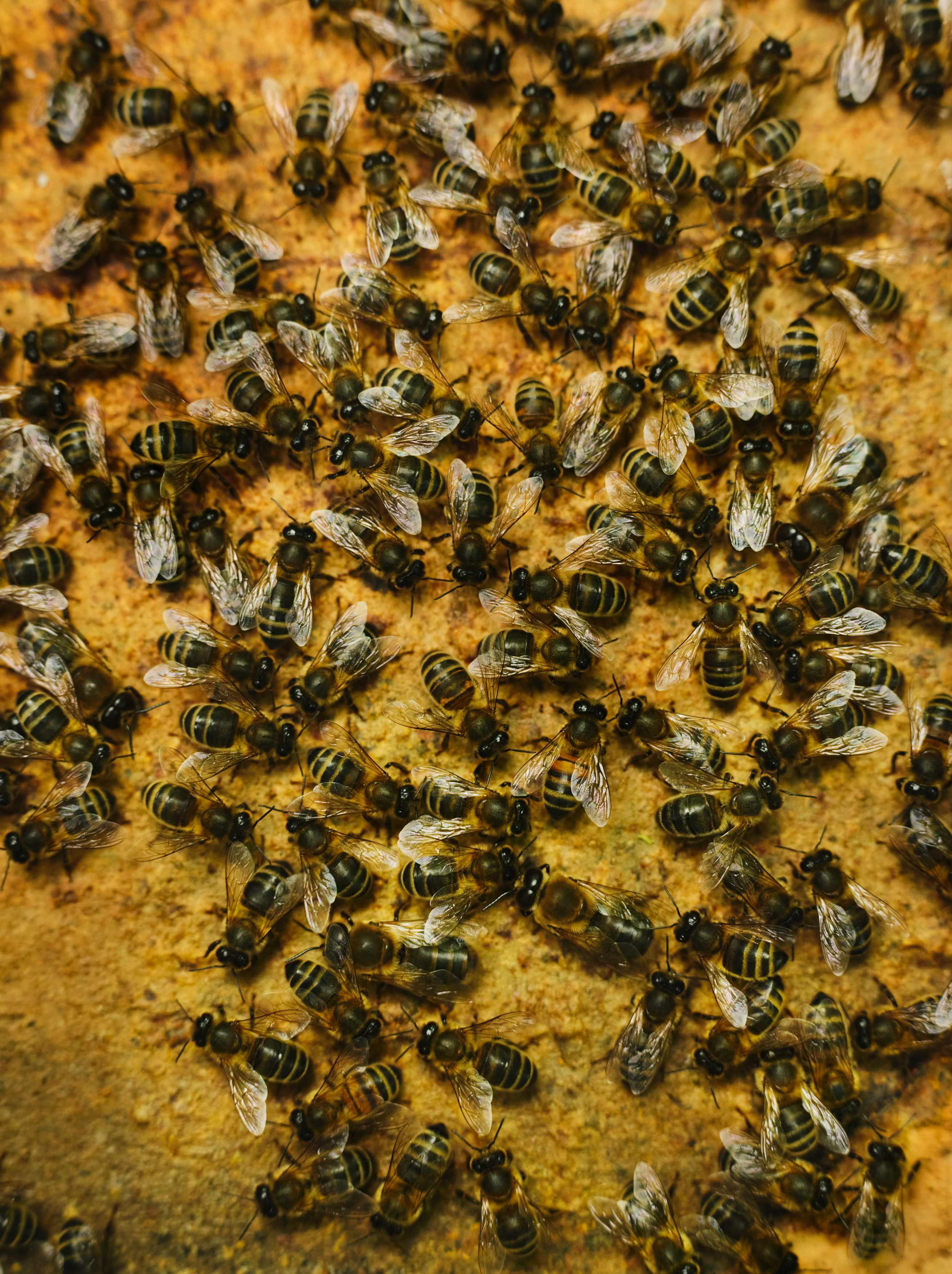
There is something very gently animated about Matt Somerville’s Hampshire workshop. Around the edge chickens roam through flowering meads and long grass, and a little farther away, against a backdrop of beech trees swaying in the wind, is a group of tall, wooden sculptures that are distinctly alive in design.
With their pointy hats and long ambling limbs these structures look as though they might march off through the meadows and into woods at any minute. But move a little closer, slow down and really look, and you see that they are alive in another, unexpected way, as swathes of bees alight and take flight. For these aren’t really sculptures at all, but beehives made from hollowed-out logs and perched above head height so you can watch the bees without disturbing their flight path.
These quirky rocket hives have charm but they also have a practical, scientific, even philosophical, purpose. The bees that live in them are wholly autonomous, you don’t get to manipulate them or for that matter take any honey. Each hive is fashioned from a single log (roughly 1m x 50cm) of Douglas fir or larch, which Matt hollows

out using first a chainsaw then a long gouge, leaving a 10cm wall for vital insulation. Matt adds holes to let the bees in and out, a reed hat or waterproof membrane for more insulation, and a removable base so hive owners can keep an eye on the colony, but nothing else. Everything, is designed to allow bees to be bees and form strong, healthy colonies capable of coping with varroa, viruses and other pathogens. “Many things in honey-driven beekeeping are against bee health,” Matt explains. “The shape of the hives is wrong, and the practise is only efficient because of feeding bees sugar to replace the honey taken.”
Matt used to keep bees that way himself. Although, by profession he’s as a cabinet maker, he studied agriculture at college and it’s still in his blood. Shortly after he and his wife Emily moved to Hampshire he bought a cider orchard where in spring he loved to lie on the grass listen to the bees buzzing in the blossom. Until one day he couldn’t hear them. He’d read about the decline in bee numbers and felt compelled to do something, so he signed up for a beekeeping course.
“Like many people, I got into beekeeping thinking that it was a way to help out,” he says. “At that point I didn’t know about all the chemicals, the suppressing of swarming and the manipulating.” Then around 12
80 GARDENSILLUSTRATED.COM JULY 2022
This page
Above Matt, assisted by Spencer Upton, adds the sockets to a hive body into which he can bolt the bevelled legs. These can either be stag oak or sweet chestnut, both of which are high in tannin so they last a long time. Right Freestanding log hives are topped by a reed hat, known as a hackle, to provide insulation and keep the rain off. Reed is more durable than wheat straw, and regular cutting and harvesting improves the biodiversity of the reed beds by ensuring the willows don’t become dominant.
This page: clockwise from above Matt and Spencer winch up the hive body so they can bolt on the 2.4m stag oak legs. These raise the hive to a height at which the bees like to nest. Using a long chisel, Matt cuts flat sockets into which the bevelled legs will sit. Matt collects reed for a hackle, which each require Matt sources from the Norfolk broads.
A selection of Matt’s tools, which include long framing chisels for cutting the long sockets, a baton for ensuring the sockets are flat and a wooden mallet.

Everything is designed to allow bees to be bees, and form strong healthy colonies capable of coping with varroa and viruses
This page: clockwise from left
The bottom of a hive has a removable base so that infrequent inspections can be made to check bee health. Matt hollows out the centre of the log leaving an outer edge of around 10cm, which is essential to keep the hive well insulated. “It’s calculated that it takes ten per cent of the colony’s energy to keep warm or cool,” explains Matt, Matt begins by taking a square core out of the log with a chainsaw then finishes hollowing out by hand. He uses a gouge on a long pole made specially for him by master blacksmith, Hector Cole. An established colony of honeybees sits on a comb they have filled to the bottom of a hive. Each hive can hold up to around 40,000 bees.

Our instinct to marvel at the architecture of combs is strong, but if you have to get a ladder to do so you’re less likely to meddle
This page
Above The log hives have three entrance holes. Bees tend to use the top hole most oftenas an entrance and the bottom one for fanning to help cool the hive and remove excess C02 during hot weather.
Left Matt carefully removes the base of a hive to inspect the colony. His log hives can either be strapped to an existing tree or free standing on a tripod of legs for easy positioning in meadows and gardens.
years ago he had what he describes as his Damascene moment. One day one of his hives swarmed, so he chased after it, and saw that when the swarm came to a tree with a long slit the bees went in. “All I’d heard was that bees couldn’t survive in the wild,” he says, “but it wasn’t true. I knew then what I needed to be doing to help the bees.”
Reading Honeybee Democracy by bee expert Thomas Seeley added science to what he had observed. One of Seeley’s ideas is that bees like to nest at around 4-5m high, which corresponds to the height at which larger branches often rot away, creating a hole in the trunk. “It’s why bees like eaves in a roof,” says Matt. It’s also why Matt’s hives can also be strapped to a mature tree, where they can be left largely undisturbed. Our instinct to marvel at the architecture of combs is strong, but if you have to get a ladder to do so you’re less likely to meddle.
For those without a suitable tree, Matt’s rocket hives offer the ideal opportunity to stand and watch. And both types of hives have now found their way into everywhere from farms and orchards to schools and prisons, and a great many gardens both large and small. As well

as making the hives Matt also installs them advising customers on the best position for their hive, which is normally an open glade or the edge of a wood. He also uses a few tricks, such as fitting a portion of old comb, and rubbing the wood with propolis and lemongrass, to encourage the bees to make this their home. This can take several weeks or as little as an afternoon, but once the bees find the hive the rewards are greater than any honey.
“It’s lovely to watch in the summer, in the evening when they come out to fan and there’s this gentle hum,” says Matt. “It’s something that you don’t really get to experience with a hive on the ground. Watching bees has also changed the way I garden. You start by focusing on the flowers but if you learn to look, you’ll see the flower is alive with life. That’s what bees teach – how to become a bee watcher rather than a bee keeper.” n
USEFUL INFORMATION
Find out more about Matt’s freedom hives at beekindhives.uk and follow him on Instagram @_beekindhives_
JULY 2022 GARDENSILLUSTRATED.COM 83
Middle ground
For this garden in central Spain, Fernando Martos has used planting that is absolutely of its place, with year-round good looks, and a reduced need for water – essential for this harsh climate
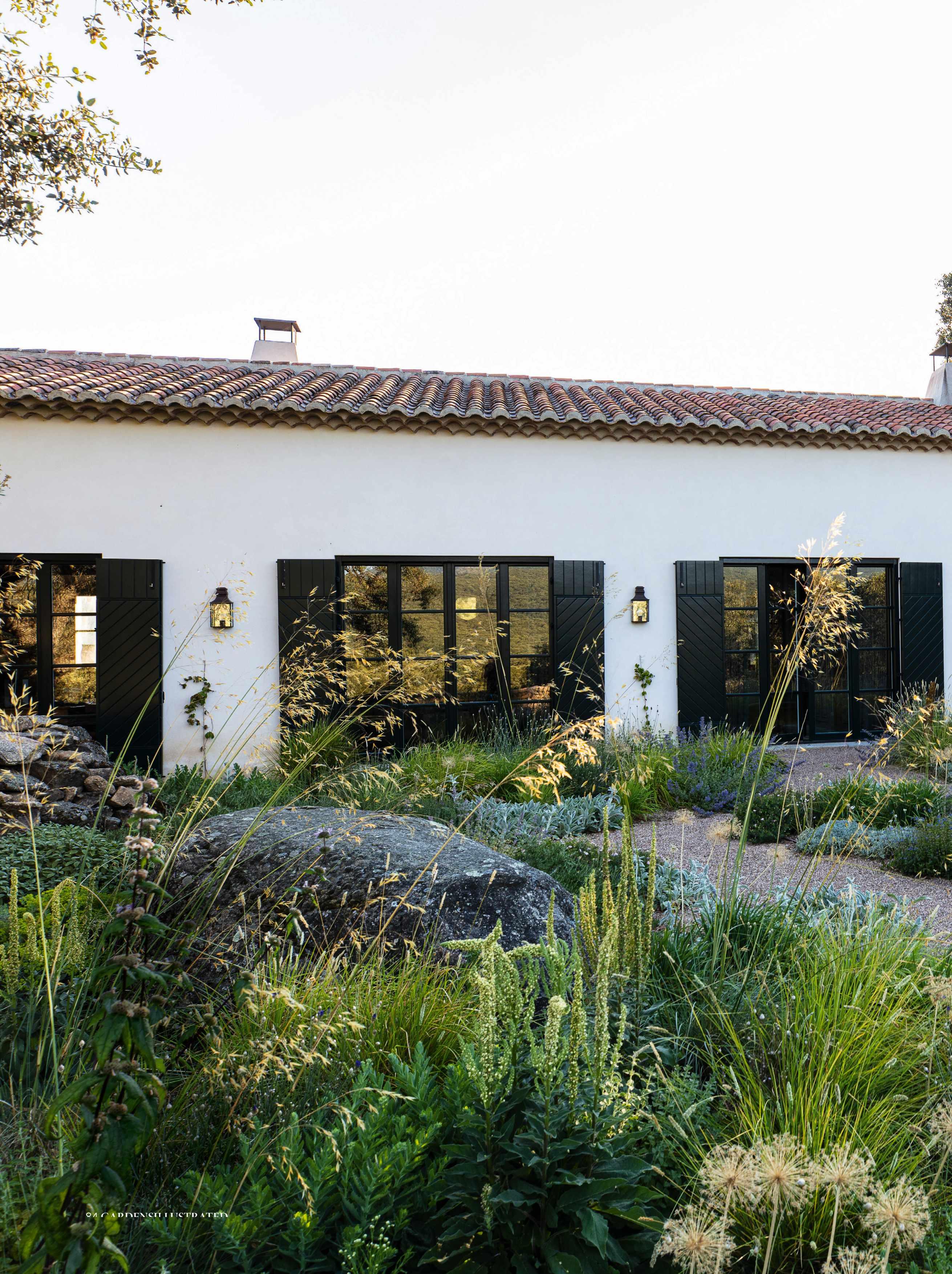 WORDS NOEL KINGSBURY PHOTOGRAPHS CLAIRE TAKACS
WORDS NOEL KINGSBURY PHOTOGRAPHS CLAIRE TAKACS
IN BRIEF
What A reduced-irrigation garden using mostly Mediterranean region native species. Where Central Spain. Size 600 square metres. Soil Free-draining, granite-based soil mixed with sand.
Climate Mediterranean steppe, with a wide temperature range. Cold winters and hot, dry summers. Hardiness zone USDA 8.
Designer Fernando Martos used the grasses Sesleria ‘Greenlee’ and Stipa gigantea to knit together a mix of different shapes and textures from mainly evergreen shrubs, including Euphorbia seguieriana subsp. niciciana, Stachys byzantina and Phlomoides tuberosa
84 GARDENSILLUSTR ATED C OM JULY 2022 4 ARDE SILLUSTR

There’s nothing especially unusual about the sight of old stone walls, made of rough granite, in the countryside of central Spain. But hidden behind the stone walls surrounding this private house, near Toledo, south of Madrid, is something that really is unusual in this part of Spain: a garden.
And not just any garden. There are no bright colours, no lawn and none of the obvious statussymbol irrigation seen all too often in dry-climate regions. Instead this is a garden that seems to concentrate the best of its surroundings into one moderately small space. The rounded shapes of many of the plants echo the grey forms of the holm oaks (Quercus ilex) that dominate the surrounding hills. There are grasses, similar to those growing in the wild and lots of different textures. These plants sit happily alongside big stones, boulders really, the shapes of which mirror many of the rounded plants. This is clearly a new model of gardening, and one that is very much of its place.
“The clients asked for something very natural,” says the garden’s designer Fernando Martos. “They wanted it to look as though it had been here for ever.” To this end Fernando has used the tough, low-growing grass, Sesleria ‘Greenlee’, as a matrix
plant. These are plants that are relatively lowprofile, and not ecologically or visually assertive, but strong enough to dominate a ground layer. They help reduce the danger of weed infiltration, filling in the gaps between other plants and, very often, helping highlight their special qualities – of colour or form. In this garden, the Sesleria makes up around half of the total planting, and this particular cultivar is relatively drought tolerant, has a good colour and according to Fernando grows better than the well-known Sesleria autumnalis popularised by the Dutch designer Piet Oudolf. Among the Sesleria are plants that tend to form rounded shapes, and with habits that ensure there will be a certain amount of meshing together over time, including Salvia officinalis ‘Berggarten’, a superior form of the culinary sage that makes a good foliage plant. Many plants are Mediterranean natives, their hummocky shapes emphasised by being lightly pruned once or twice a year. A 5cm mulch of local limestone chips forms a pathways between the areas of planting, and is partly extended in-between the plants, its neutral tones offer a contrast to – and also help to highlight – the grey-green of the plants.
On the whole, this garden’s look is an example of the aesthetic widely promoted by the French nurseryman, Olivier Filippi. But there is another

To continue turn to page 90
Above Terracotta pots, filled with neatly clipped wild olive (Olea europaea subsp. europaea var. sylvestris) and Lavandula dentata, add a more formal touch to the cobbled courtyard. Behind, deep raised beds hold three, multi-stem Amelanchier alnifolia underplanted with a loose mix of planting that features the trailing rosemary Salvia rosmarinus ‘Rampant Boule’ spilling over the edge.
Right Mexican fleabane Erigeron karvinskianus trails down from upper planters, adding to the feel that this garden has been here for years. Below, the deep-raised beds are filled with an exuberant mix of textures and colours, including Salvia ‘African Sky’ and Salvia rosmarinus ‘Rampant Boule’ – both of which make effective groundcover plants with aromatic foliage and attractive flowers.
86 GARDENSILLUSTRATED.COM JULY 2022

�is is a garden that seems to concentrate the best of its surroundings into one moderately small space
The holm oak-covered hills surrounding the garden are echoed in both the shapes of many of the plant species used and by the shapes of the planting beds – and indeed by that of the whole walled area. On the other side of the wall in the foreground is Fernando’s wildflower meadow – already showing the impact of the hot, dry summer.

88 GARDENSILLUSTRATED.COM JULY 2022
Right plant, right soil
“My experience with Mediterranean region planting is that you need a poor soil and good drainage,” says designer Fernando Martos. That poor soil might help plants to thrive may sound surprising to some, but basically it is about slowing down plant growth.
Most species that thrive in dry summer climates also naturally grow on lean soils. Many are also relatively short-lived, and will ‘burn out’ rapidly in moist and fertile ground – something northern European gardeners may well have discovered when a cistus or ceanothus grows rapidly for a few years and then suddenly dies.
It can be more di�cult to create a dry-climate garden on a rich loam because the natural flora of a loam soil is generally herbaceous and would die back in the summer drought. In contrast, plants that grow naturally in shallow, rocky soil are evergreen and so they at least maintain their basic appearance through the summer. Some dry-climate species are also prone to fungal diseases if watered during hot weather.
In this garden, Fernando has combined the existing soil with sand in a 50/50 mix. This helps to open it up and reduce its fertility, a measure that will help to ensure longevity of plants and promote plant health.
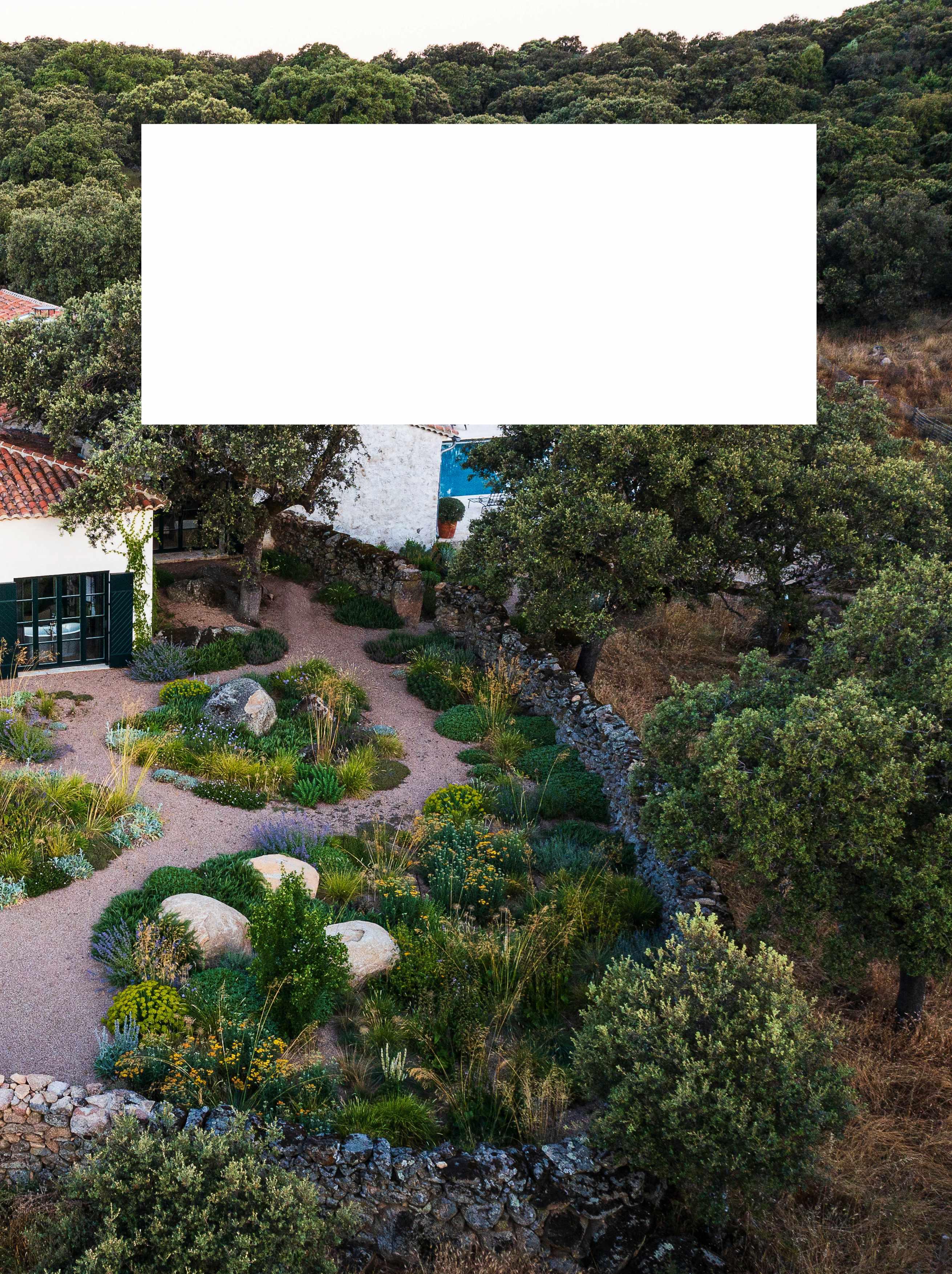
emerging Mediterranean regional style that uses more grasses and herbaceous plants to create a more raggedy, slightly wilder and looser style.
There is a nod to that here, with taller grasses that do a good job of catching the light with their flower- and seedheads. Stipa gigantea, surely one of the best of all ornamental grasses (and native to this area), is a feature. It is a wonderful species for adding height, but without bulk or anything other than a faint veil to sight lines, and can be magically illuminated by low sunlight at the end of the day. As one of the most distinctive plants of upland Spain and Portugal, its presence in the garden reinforces the link between the design and the locality.
This style is less drought-tolerant gardening and more low-water-requirement gardening. It addresses the desire of many who, although acutely aware of the chronic shortage of water in this part of the world, are looking for a garden that steers a middle course – eliminating the lawn and thirsty annuals, but still full of life in midsummer.
Even locally native plants – as many of these are – go into a ‘drought dormancy’ in summer, dropping leaves, shrivelling, going brown, and obviously withdrawing themselves to minimise the use of scarce water. This may help them to survive, but it is not especially attractive. Gardens that use dry-habitat plants but keep them looking fresh with minimal watering is an obvious
solution.“Nobody wants a dry garden,” says Fernando. “But we need to minimise irrigation.”
In this garden, for example, Fernando irrigates once a week, from July to midSeptember – “Around 12 times a year in total,” he says. This ensures plants look alive but without encouraging too much growth. But beyond the garden wall he has created two areas where established plants have to rely solely on rainfall.
One is a meadow area made up of native species, sown with seed from Semilla Silvestres, a specialist in seed mixes of Iberian natives. “It can be cut after flowering and then in summer when it’s dry, it’s a place for children to play,” says Fernando.
In the other he’s planted hundreds of native shrubs. “We planted very small,” he says. “Not watered from the second year, they produce fruit for wildlife, which is important for me.” With the exception of Pistacia terebinthus, the shrubs –Crataegus monogyna, Prunus spinosa, Viburnum lantana and Rosa canina – are also native to the UK. Gardens like this may be novel here, but in many ways they have more authenticity than wastefully irrigated pastiches of those of other climates. They are more truly of their place. n
USEFUL INFORMATION
Find out more about Fernando’s work at fernandomartos.com/en
Above In the slightly shaded area close to the dining terrace, Fernando has created a loose natural look with a mix of mainly evergreen shrubs, including Phillyrea angustifolia and Cistus salviifolius, and the trailing, aromatic rosemary, Salvia rosmarinus ‘Rampant Boule’, against the backdrop of a climbing white rose. Among all this dark-green foliage Phlomis italica adds a fine silver-grey splash. It’s a genus that includes some of the very best silver-leaved plants for dry climates.

90 GARDENSILLUSTRATED.COM JULY 2022
An emerging Mediterranean style uses more grasses and herbaceous plants to create a slightly wilder and looser style
8 KEY PLANTS
1 Stipa gigantea An evergreen grass that forms a tight clump. Its flowerheads and seedheads rise in airy panicles, which look fabulous when backlit. Good for cold, dry climates. Long-lived and atmospheric, it needs full sun. 2.5m x 1.2m. AGM*. RHS H4, USDA 5a-9b †

2 Euphorbia seguieriana subsp. niciciana A handsome spurge, with blue-green foliage and contrasting lime-green flowers. Drought tolerant, it offers a long season of interest in full sun. 50cm x 50cm. RHS H5, USDA 6a-10b.
3 Stachys byzantina An attractive, low-growing perennial with furry, silver leaves. Can be used as groundcover in dry summer climates. Tolerant of thin soils and needs full sun. 20cm x 45cm. RHS H7, USDA 4a-9b.
4 Salvia rosmarinus ‘Rampant Boule’ A form of rosemary that makes a small mound with pendent outer branches – making it useful for spilling over a wall. Needs sun and is drought tolerant. 20cm x 60cm. RHS H4, USDA 8a-10b.
5 Convolvulus sabatius A low-growing plant with trailing stems but not spreading. It has a long, summer-flowering period, and is good in stony soil and sun. 20cm x 50cm. AGM. RHS H3, USDA 8b-11.
6 Achillea umbellata One of many Achillea species that can be used as a groundcover or a lawn alternative for areas that are rarely walked on. Needs sun and dry soils. 20cm x 30cm. RHS H4.
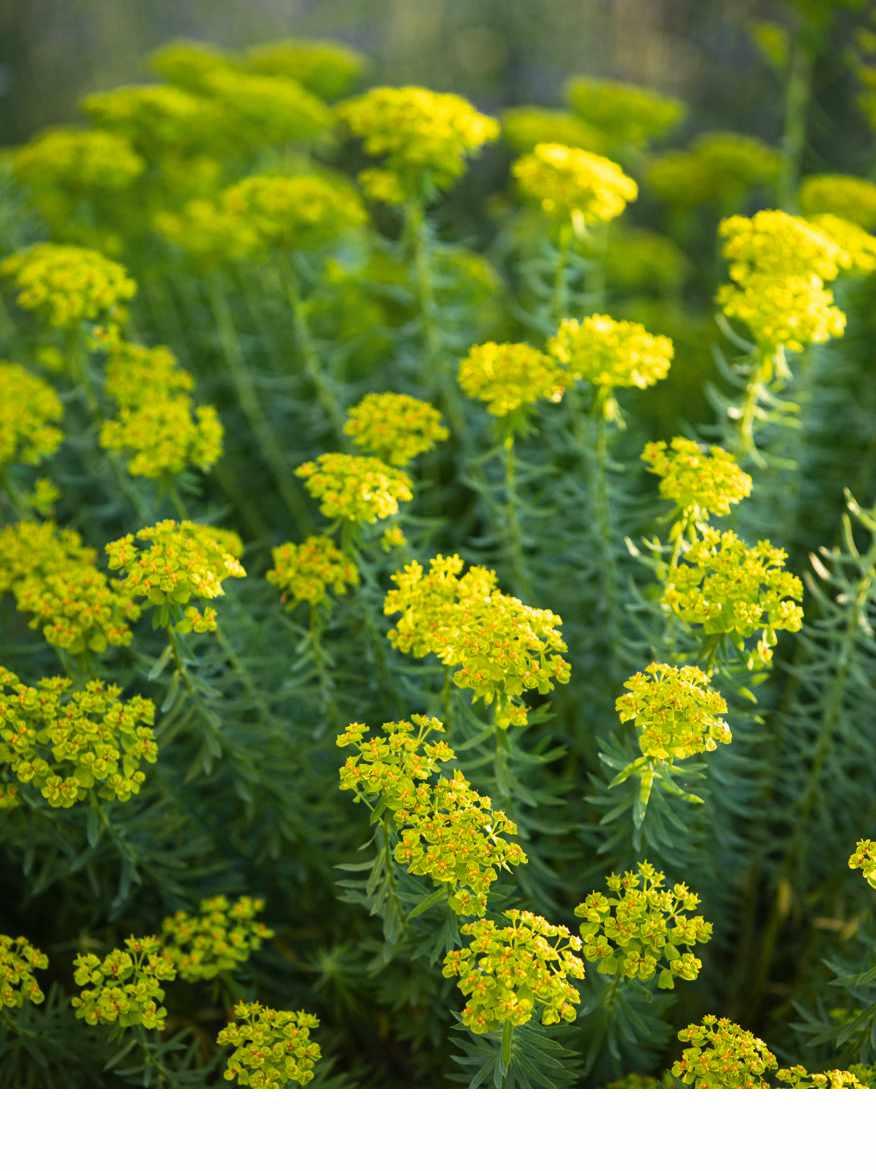
7 Ceratostigma willmottianum Small, deciduous shrub, which is usually treated as a herbaceous perennial. It has a long flowering period from summer to autumn, and offers vivid, dark-red autumn colour. Can cope with sun or light shade, and has a spreading habit. 1m x 1.5m. AGM. RHS H4.


8 Salvia forreri A little-known salvia that is sprawling but low growing. Flowers from late summer to autumn. Not especially drought tolerant. 25cm.
*Holds an Award of Garden Merit from the Royal Horticultural Society. †Hardiness ratings given where available.
1 2 4 5 6 7 8 3
Nature reserve
In his new book, Meadow, writer Iain Parkinson shares the reflections of notable experts, each with their own area of specialism, in an exploration of how the UK’s classic hay meadows have shaped our cultural heritage. We hear from three of those voices whose passions include the virtues of leaving grass verges untouched, the symbiotic relationship and micro-dramas that play out between fields and insects, and the lives of the crofters who work on the grassy plains of Scotland’s magical machair
 PHOTOGRAPHS JIM HOLDEN
PHOTOGRAPHS JIM HOLDEN
Nectar networks
Keith Datchler OBE, retired farmer
Having spent my entire working life in farming, several decades of it meadow-orientated, I did not think roadside verges would become a part of my life, but they have. I am a meadow nut – my wife says if I were cut in half, I would have the word ‘meadows’ written through me like letters in a stick of rock. Increasingly, the push to save existing meadows, and create more species-rich, biodiverse grassland, has gathered pace. Thank heavens –they are basic in the story of human life, in ways people are only beginning to understand. Wheat, barley, oats, rye, rice and maize, are all staples to our existence, and all types of grass. We need to feed ourselves, and farms and farmers always rise to that challenge. Not all farms can turn over large areas of land to conservation alone, although a sympathetic approach is rising in popularity. Thankfully, schemes – which come and go – offer support to farmers if they embrace conservation. With this in mind, and the realisation that the surviving pockets of intense biodiverse grassland themselves are fragmented, what to do? Obviously, look at land capable of supplying, or that might already be supplying, natural diversity. What is this and where is it? Parks, gardens, churchyards and other public green spaces are an obvious place to start – and roadside verges: all 200,000 hectares of them. Roadsides, although mostly strips of grass, are everywhere. They are in the public view, linear and connective throughout the nation. I can hear the thinking: “But they are individually so small there’s nothing of them.” However, collectively they represent a simply massive land holding, and not a hectare of it used for food production. Therefore the impact on our agroeconomy is zero, the potential to increase diversity gigantic. All in the public domain.
Roadside verges are connective in the public eye and representative of every local soil type, geology and elevation. Plus, as they have sat outside of agriculture, many represent fragments of meadow or the last stronghold of a species – be that plant or insect. The majority view is that short green grass is neat and tidy, a reflection of civic pride and care. ‘Tidy’ is a curse of nature. What is wrong with ‘beautiful’? Long grass blowing in the wind, the tapestry of colour, banks alive with ox-eye daisies and knapweed or even buttercups. Even in winter, brown grass stalks covered in hoar frost or dripping with morning dew… it is a question of perception.
Until councils had flail mowers, strimmers and petrol mowers, we had natural roadsides. These produced an abundance of insects, because left to grow for their full annual life cycle, the grasses and other plants host myriad insects that also complete their life cycles. All we have to do is stop mowing – please. Safe junctions and sightlines must be maintained, but otherwise leave verges free to nurture nature. That is a basic first step. Opportunities exist for enhancing some verges where diversity has been lost. The introduction of good local provenance wildflower seed, for instance. Roadsides are also excellent sanctuaries for rare plants. One of our rarest plants, spiked rampion, has a stronghold on a verge. Where safer for a rare plant than the verge of the M25? I would love to see roadside verges designated reserves for wildlife.
Main image Keith Datchler among the ox-eye daisies, Leucanthemum vulgare and meadow buttercups, Ranunculus acris, growing on a roadside verge near his home in East Sussex. Many local authorities designate roadside verges as special conservation areas. In East Sussex the areas are identified with a small yellow flower sign, which earmarks these areas for special conservation management.
1 Ragged robin, Silene flos-cuculi, growing on a roadside verge. Verges are among some of the UK’s richest habitats, supporting more than 700 species of wildflower – that’s nearly half of our total flora.

2 Upland roadside verges hold a profusion of widespread species, such as meadow buttercup, Ranunculus acris, and sorrel, Rumex acetosa, that are supplemented by a number of specialist plants including wood cranesbill, Geranium sylvaticum, and globeflower, Trollius europaeus,

3 Flower-rich roadside verges are not only important for wildlife, but with flowers, such as the pretty cuckoo flower or lady’s smock, Cardamine pratensis, they provide a beautiful ‘side drop’ as we go about our everyday lives.

JULY 2022 GARDENSILLUSTRATED.COM 93
1 2 3
Tangled web
Laurie Jackson, entomologist
Daydream of a summer meadow and I bet there is the buzz of a bumblebee, a flash of butterfly wing and the hypnotic chorus of crickets. And rightly so. Insects are the beating heart of a meadow, providing the soundtrack and magnifying its vibrancy. While our scythes may now lie quiet, meadows remain hubs of activity for insects. Industrious bees are joined by chunky flies, clumsy beetles and elegant wasps. Just as we do, different pollinators have their preferred blooms. Long-tongued bumblebees often choose the protein-packed pollen of clovers and vetches, while knapweeds and scabiouses provide an irresistible draw for butterflies.
Throughout the year, the insect community waxes and wanes through a seasonal sequence, and the variety of wildflowers has a direct impact upon the species present. Some, such as the red bartsia bee, rely on the pollen from a single species and many, including the long-horned bee, survive only in places where the flowering community is allowed to thrive, becoming rich and diverse. As well as pollinators, meadows also contain herbivores, predators and decomposers; the scenes of natural micro-dramas as their lives unfold.
Meadows are a key part of the patchwork of our landscapes. Feeding opportunities entice species from adjacent habitats, including colourful longhorn beetles. Their larvae develop in decaying wood, and adults can flock to the meadow edge to feast on umbellifers and other open-fronted flowers. But meadows provide more than food. They provide an intricate mix of micro-habitats: the scuff of a passing cow’s hoof, a grassy tussock, an anthill or a scrubby edge. Hollow stems and seedheads help insects hide from predators or while away the winter, emphasising the importance of varied vegetation height in and around meadows.
Insects are important for meadows too. Decomposers break down plant and animal material, returning nutrients to the plants. Elaborately patterned bugs join beetles and the larvae of moths and butterflies in grazing the vegetation, contributing to the structural diversity, while the soil dwellers distribute nutrients, aerate the soil and help to disperse seeds.
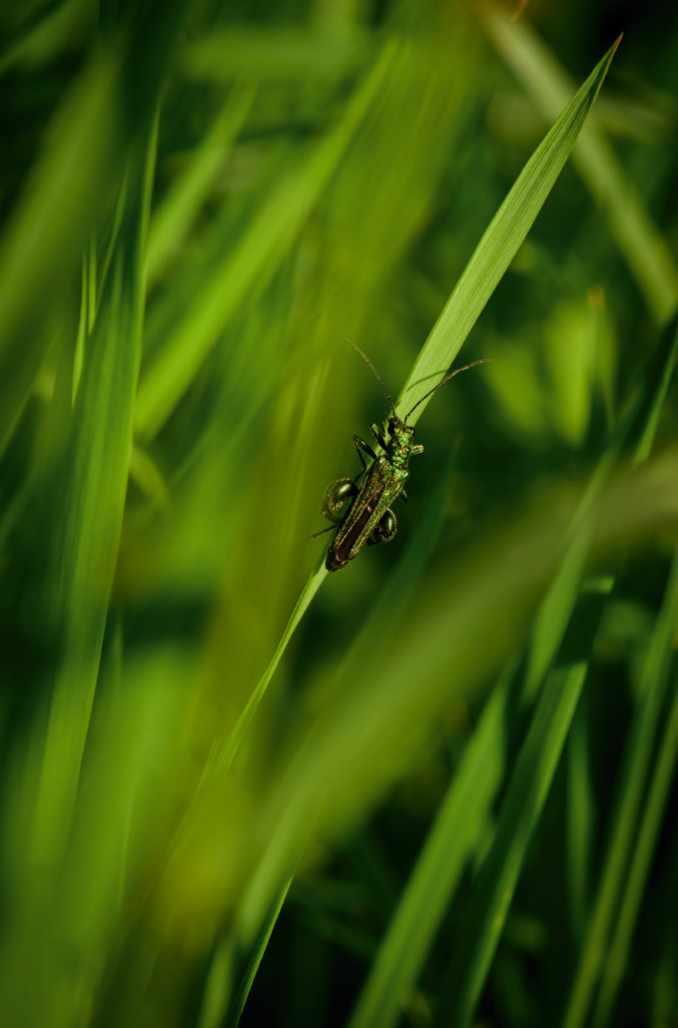
The loss of meadows presents many species with a lack of stability. Insects are often adapted to the subtleties of a particular meadow type: its hydrology, soil type, even its history of management. Today’s meadows are more thinly dispersed; their breaking apart into ever smaller fragments can be an insurmountable barrier, making individual populations more vulnerable. Meadows may be the last refuges for some insects within a countryside that is getting ever less flowery and increasingly similar in terms of plant composition.
We have lost so much of these species-rich habitats, but it is not too late to atone for this. By restoring meadows, we enable insects once again to flow through our landscapes, allowing them to move and mate and become more resilient. We need to see beyond misconceptions of meadows being unkempt and start to listen to and feel all they have to tell us. The richness of insect communities is tied to the richness of the communities they support. This colourful cast is a key part of our meadows and our lives would be poorer without them.
Main image Entomologist Laurie Jackson sweeps a field in search of insect life. Fixed-route transects can be used for airborne species such as bees and butterflies, while beating woody vegetation can tell you about the species around the meadow edge. Monitoring flowering resources at di�erent times of year provides a useful insight into the availability of foraging opportunities. Whichever methods are used, it is important that they are standardised so that they are easy to repeat and data gathered is comparable.
1 Particularly active on hot and sunny days, the swollen-thighed beetle, Oedemera nobilis, feeds on pollen and so is easy to spot. Its iridescent, coppery green hue contrasts strikingly with openstructured flowers, such as the ox-eye daisy, Leucanthemum vulgare
2 Ox-eye daisies attract various pollinating insects including many di�erent species of hoverfly and beetle.

3 The funnel-shaped webs that suddenly seem to appear in meadows on dew-laden mornings are not the lairs of some poisonous funnel-web spider. Instead they are the homes of labyrinth spiders, Agelena labyrinthica, which feed on grasshoppers and crickets.
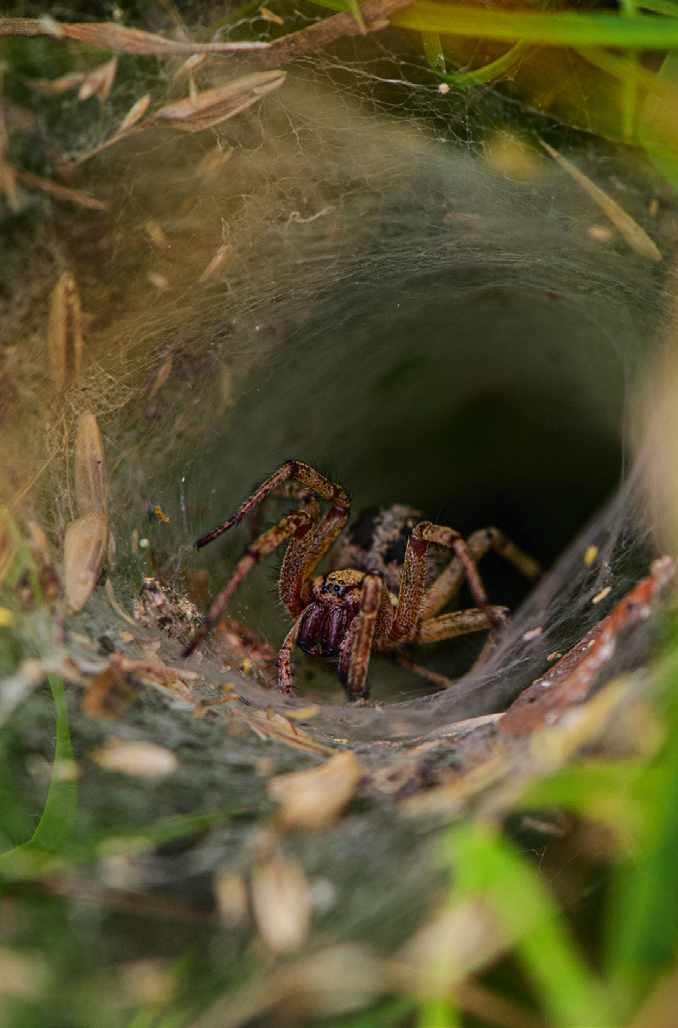
94 GARDENSILLUSTRATED.COM JULY 2022
1 2 3

Meadows are important for insects, but insects are important for meadows too

�e machair presents an astonishing spectacle, providing us with an amazingly rich and diverse ecosystem of high conservation value
Magical machair
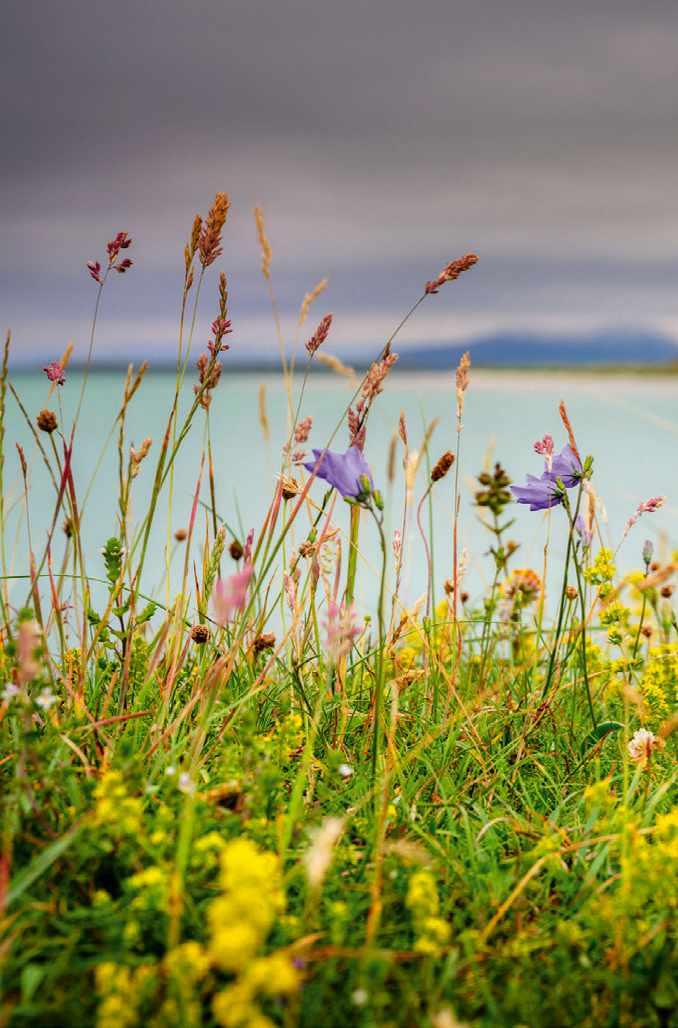 John A Love, naturalist
John A Love, naturalist
I came to Uist late in 1992 to work as area officer for what was then Scottish Natural Heritage, and I have lived beside machair ever since. Edward Dwelly’s classic Gaelic-English Dictionary (1911) describes it perfectly – ‘an extensive, low-lying fertile plain’ and ‘a long range of sandy plains fringing the Atlantic side of the Outer Hebrides. They are closely covered with short green grass, thickly studded with herbs of fragrant odours and plants of lovely hues’. Machair is not just confined to the Outer Hebrides, with other fine examples on the inner islands, parts of the nearby mainland and Orkney, Shetland and the west of Ireland. Many areas might be damper, with some marshes, ditches and small lochans scattered throughout, sand dune systems along the shore, perhaps even the sandy beaches too. But what makes Uist machair special is the human contribution – crofting. Rotational cultivation of ‘corn’ (a mixture of small oats, rye and the old bere barley) adds to the mix – both by cropping and as fallow, even small potato patches. Machair is not so much a single habitat, but a mosaic of habitats.

The sand blown inland from beaches and dunes is composed of crushed seashells and therefore rich in calcium. But the lime-rich sandy soils drain readily, lacking much humus, and are deficient in certain trace elements that modern cereals demand. So, to produce good crops, seaweed cast upon the shore in winter storms is applied before ploughing and sowing. The traditional corn mix grows short and stiff to withstand the winds and salt spray, so was harvested by hand or binders. Being grown largely as animal fodder, largely for cattle, what modern farmers might consider ‘weeds’ can be tolerated. Hence the flowerrich sward, making the ideal conditions for a whole host of insects and nesting birds.
This ancient land use was low intensity and effectively organic. When I arrived this remarkable system was being encouraged (with payments for the application of seaweed, altered mowing techniques and late cutting to encourage the disappearing corncrake). Some maintained that without this crofting would not have survived much longer. Uptake was high.
But times are changing. Agricultural support seems to be nudging machair crofters into becoming farmers. The demand for beef and for cattle is declining, thus also their manuring effect that adds flower seeds and organic matter to the machair in winter. Modern machines plough deeper, compacting the soil and restricting drainage; mineral fertilisers are replacing seaweed, sprays are sometimes applied to clean out the weeds. Black plastic bags wrap the silage, cut earlier to the detriment of our corncrakes, corn buntings, skylarks, etc.
In nearly 30 years of living beside the machair, I have seen its conservation resource diminish. And now there is the threat of climate change, increasing the frequency of storms and sea level rise, both promoting coastal erosion. The machair has been retreating for centuries yet still presents an astonishing spectacle, providing us with an amazingly rich and diverse ecosystem. It has helped sustain a successful, sympathetic and thriving rural population. But, we have to ask ourselves, where will it be in the future? n
Main image John Love among the hawkbit, Pilosella caespitosa, and ox-eye daisies, Leucanthemum vulgare, growing on the machair near his home on Uist in the Outer Hebrides. He is fascinated by the interplay between crofting and crofters with the flat, windswept landscape.
1 The low-lying, fertile grassy plains of the machair are a unique habitat that is home to a wealth of wildflowers, including harebells, Campanula rotundifolia, and lady’s bedstraw, Galium verum. Machair is one of the rarest habitats in Europe; occurring only on the exposed, westfacing shores of Scotland and Ireland.
2 The machair is a windswept and hauntingly beautiful landscape.
3 Machair is dominated by crofting, a traditional family farming practice carried out on small areas of land.

This is an edited extract from Meadow: The Intimate Bond Between People, Place and Plants by Iain Parkinson with photographs by Jim Holden. Through 30 first-person accounts, the book explores the intimate and complex relationship between people, place and plants which, over the centuries, has shaped the character of the British Isles. It’s published by Royal Botanic Gardens, Kew, priced £25. ISBN 978-1842467473.
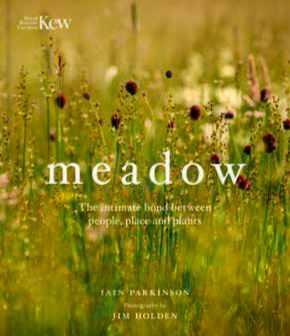
JULY 2022 GARDENSILLUSTRATED.COM 97
1 2 3


Garden Inspiration Garden Structures Fruit Cages Plant Supports Kitchen Garden Outdoor Living 15%OFF GAR1522 WHEN YOU USE CODE *VALID TO 31.8.22 see website for terms and conditions agriframes.co.uk | 0117 934 1790
News, garden design and sourcebook Design
KINDRED SEOUL
Following the success of its undulating park for Pier 55 on New York’s Hudson River, UK-based Heatherwick Studio has proposed a similar playful public space for the Han River in Seoul. The floating, multi-level pier, dubbed The Leaf, would be part of a plan to rejuvenate the area around Seoul’s Jamsil Olympic Stadium and would be connected to parkland around the stadium complex by a walkway. It would incorporate event spaces and an auditorium covered by a planted roof, along with winding trails, play areas and view points. An adjoining marina would allow people to arrive by water taxi. heatherwick.com

JULY 2022 GARDENSILLUSTRATED.COM 99
HEATHERWICK STUDIO
News
COMPILED BY ANNIE GATTI
1 MELBOURNE GALLERY
The winning design for The Fox: NGV Contemporary in Melbourne has been announced. The design team for what will be Australia’s largest gallery of contemporary art and design, is led by Angelo Candalepas and Associates and includes 20 architecture, design and engineering firms. The gallery will feature distinctive arched entries from the new public parkland into a spherical hall that soars more than 40 metres to a lantern in the roof. Here a terrace on two levels, with a sculpture garden, will offer expansive views across the city to the distant Yarra Ranges. ngv.vic.gov.au

100 GARDENSILLUSTRATED.COM JULY 2022
LH GARDEN SHOW, SOUTH KOREA
Andy Sturgeon Design has created a permanent garden at Incheon Geomdan NewTown, South Korea, the site of the LH Garden Show. Working in collaboration with SeonJeong Mun of Hay Designs, Andy has devised a series of terraces that rise up through the woodland setting, with shallow pools and planting to suggest a monoculture, in reference to local agriculture. A series of Corten steel walls provide sculptural elements that act as backdrops to the planting and, like the walls in his Mind garden for this year’s RHS Chelsea Flower Show, create a sense of enclosure. andysturgeon.com
NEW PLATINUM JUBILEE GARDEN
A new permanent garden, to mark The Queen’s Platinum Jubilee, has been installed at Three Counties Showground, Malvern. The garden, designed by Jess Russell-Perry as a quatrefoil with raised wooden beds, incorporates two existing cherry trees. An Acer campestre ‘Queen Elizabeth’ provides a focal point at the centre of the garden, and the surrounding planting is a combination of plants favoured by Her Majesty, such as lily of the valley and poppies, and plants named after her, including David Austin’s new English shrub rose, Rosa Elizabeth (= ‘Ausmajesty’). threecounties.co.uk
COURTYARD OF ST JAMES’S PICCADILLY
Robert Myers Associates is to bring a fresh look to St James’s church in London’s Piccadilly. The new landscaping will increase biodiversity and create a more welcoming approach to the historic church. New planting in the transitional space between the churchyard and the existing Southwood Garden will have a woodland-edge feel beneath plane trees, while a new path will create step-free access to the garden for the first time. The landscaping is part of the Wren Project, led by architect Ptolemy Dean, to restore the Christopher Wren church. sjp. org.uk; robertmyers-associates.

PARCO DELLA REGGIA DI RIVALTA
Dutch landscape and urban design practice OpenFabric, in collaboration with Caarpa and F&M Ingegneria, has designed a contemporary park for Reggio Emillia, Italy. The design for the site, which during the first half of the 18th century was planted with a Versailles-style garden, retraces the main pattern of the original garden, with a grid of triangles planted with different types of seed mixes to create blocks of saturated colours. Vine-covered pergolas will provide shade at the intersection of the diagonal paths. Two elliptical water features will form part of the treelined parterre. openfabric.eu
DESIGN
2 3 4 5 5 2 3 4 2
3
4
ANDY STURGEON DESIGN;
MIKAL LUDLOW PHOTOGRAPHY;
ROBERT MYERS ASSOCIATES.
6 CLIMATE ISLANDS
Spanish architecture and landscape practice SCOB has designed seven Climate Islands for the area around Barcelona’s Port Vell harbour. Set in a strip of land between the city’s Gothic Quarter and La Barceloneta neighbourhood, the series of modular islands will provide space to relax among vegetation with misting from water vapour systems. Proposed planting will include a mix of shrubs, grasses and trees from Mediterranean climates, including tamarisk and pine. New paving in white resin and red asphalt will reflect more light and cause the city’s thermal effect to be reduced by several degrees. scob.es
7 SOUTH BANK SQUARES
Planning permission has been granted to transform the former ITV Studios on London’s South Bank into a mixed-use development with wellbeing and sustainability at its heart. The design for 72 Upper Ground by Make Architects will provide affordable workspaces with external terraces and balconies overlooking the Thames. Landscaping by Grant Associates will create a rooftop restaurant with outdoor terrace, two new squares and a network of public walkways to ensure that 40 per cent of the site is open to the public. grant-associates.uk.com

DESIGN 102 GARDENSILLUSTRATED.COM JULY 2022
6 ADRIÀ GOULA, 7 MAKE ARCHITECTS
Good looking and made to last.
Heritage clothing & equipment all made in the UK carriercompany.co.uk

NEW IDEAS
A tired, sloping garden mostly laid to lawn has been given a softer, more naturalistic makeover that complements the updated house
 WORDS JODIE JONES PHOTOGRAPHS MARIANNE MAJERUS
WORDS JODIE JONES PHOTOGRAPHS MARIANNE MAJERUS
�e design brief
Period gardens can easily subside over the years so when new owners move in and want to make their mark, they tend to resort to one of two courses. Either the old garden is painstakingly revived in an attempt to recreate its former glory, or the whole thing is ripped out and radically redesigned.
When Gavin McWilliam and Andrew Wilson were called in to consult on plans for a mid 20th-century property near Chorleywood in Hertfordshire, they proposed a third way. “The original garden was laid almost exclusively to lawn, and was undeniably tired and uninteresting, but there were a few lovely specimen trees and the remnants of a hazel coppice, which we were keen to retain,” says Gavin.

“And because one particularly fine acer grows on a slope, we knew we couldn’t go in for any significant land sculpting, which would have damaged its roots. This decision, together with the clients’ desire for a softer, more naturalistic plant palette, set the tone for our design.”
Gavin and Andrew worked in tandem with the architect Jonathan Dale, who remodelled the house and designed a new swimming pool extension with dark-grey frame, which informed the choice of hard landscaping materials. “The clients wanted a relaxed garden with space for family recreation, so we retained a sizeable area of lawn, but framed it with bold sweeps of New Perennial-style planting that were designed to give maximum impact for minimal maintenance.”
The clients also wanted a new greenhouse and a kitchen garden. “Normally you would put those two elements together, but here that didn’t work. The natural site for the vegetable beds was at one end of the pool house, where there was no suitable space for a greenhouse. Instead we found a very stylish contemporary model and decided to use it as a focal point, at the highest point of the garden.”
Around these organisational elements, the planting combines sleek lawns, swathes of colourful perennial planting and an annual wildflower meadow to produce a garden that is both relaxed and relaxing.

USEFUL INFORMATION
Find out more about Gavin and Andrew’s work at mcwilliamstudio.com
Turn the page to discover more of the garden’s design elements
JULY 2022 GARDENSILLUSTRATED.COM 105 GARDEN DESIGN
Paths, steps and vistas
Vistas don’t always have to draw the eye to a garden perimeter. Pictured here, a broken allée of table-pruned liquidambars provides a link that runs right through the body of the house. Thanks to the full height glazing of the remodelled building, a group of four liquidambars sitting in the gravel drive near the front door visually connects with a longer run of the same trees, underplanted with Deschampsia cespitosa ‘Goldtau’ that run o� at right angles to the rear terrace. A final group of four more liquidambars in the formal lawn bookends this arrangement with a pleasing symmetry.
Essential pathways should have an all-weather surface so they can be used at any time. Such utility routes can be quite narrow if the site dictates, but grass paths need to be wider to reduce the impact of excessive wear and tear. This also produces a more sociable route. Ideally, aim for a path wide enough for two people to walk comfortably side by side.
The broad stairs at the back of the house are laid with large-format, concrete, Schellevis paving slabs, which complement the pared-back architecture of the renovated
house. They lead to a higher level pathway through ornamental meadow planting with views southeast towards a stand of birches that screen the neighbouring house.
Where the slope transitions from formal lawn to more relaxed outer areas of the garden there are generous beds filled with a range of colourful perennials and ornamental grasses, punctuated with retained acers and a graphic arrangement of hedging sections.

Managing water run-o� during heavy rain is now a key design consideration. “The primary goal should be to retain water at source, and here, as well as extensive use of permeable surfaces, all water from the building and hard terraces drains into a newly installed borehole,” says Gavin.
Gravel is a cost-e�ective choice for paths and, since it is naturally permeable, is also an environmentally responsible choice. The existing mastic asphalt driveway was lifted and replaced with black basalt aggregate, which was also used for the path to the compost bins.
106 GARDENSILLUSTRATED.COM JULY 2022 Turn the page to see more of the garden

GARDEN DESIGN
ESSENTIAL ELEMENTS
A look at some of the key design elements that create a seamless link between this relaxed family garden and the mid 20th-century house
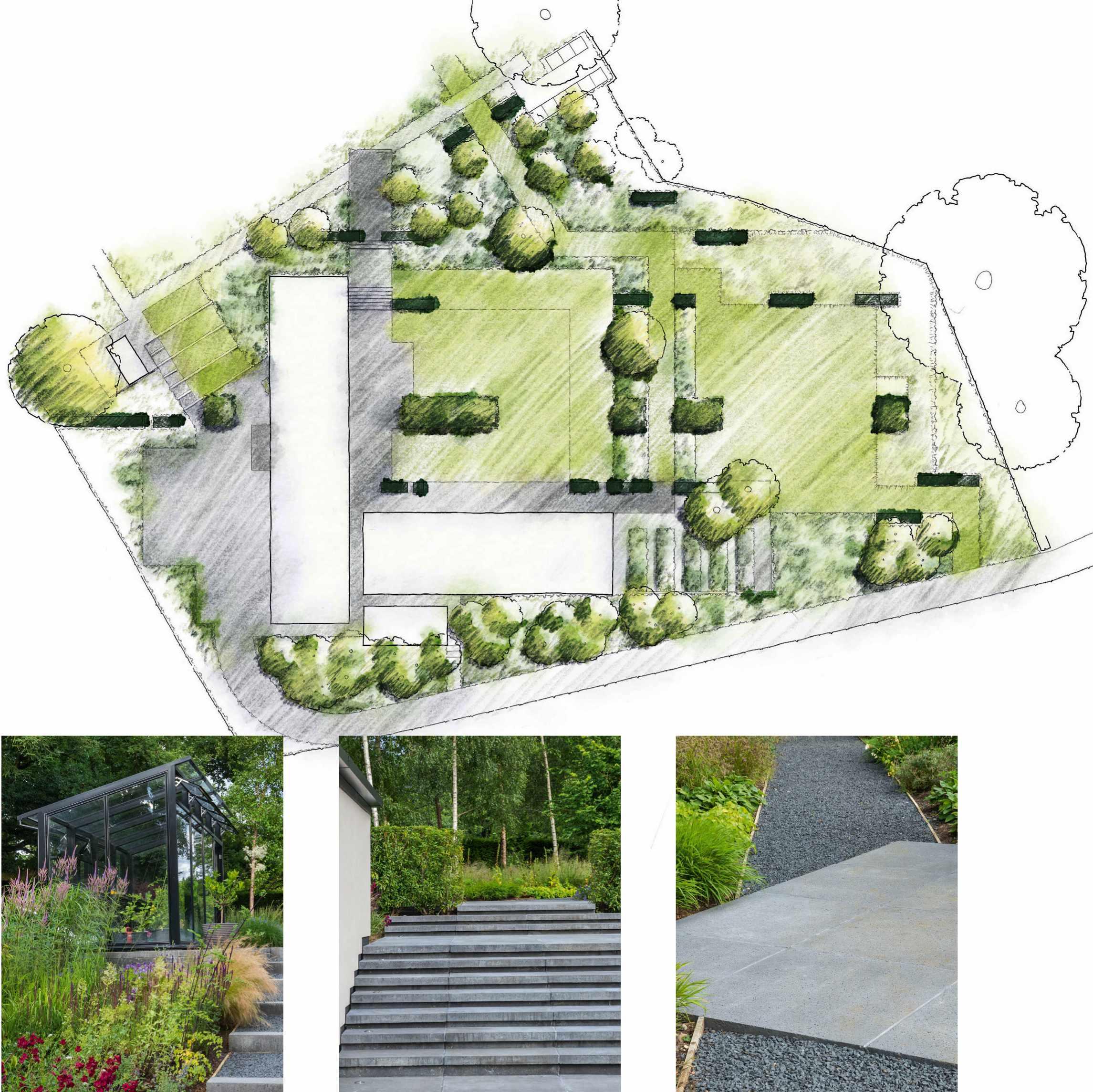
KEY FACTS
Where Hertfordshire. Size 4,200 square metres. Soil The underlying limestone is covered with a deep, slightly acid, loamy clay.
HOUSE RULES
The greenhouse has been sited in a prominent location away from the kitchen garden. O�set from the front of the house, it serves as a focal point, its dramatically sloping roof reflecting the asymmetrical roofline of the main house.
STEPPING UP
Near the house, the hard landscaping is a distinctive feature, with steps on either side of the building running up the sloping part of the garden. At the front, these take the form of broad but shallow stone-edged lawn terraces. At the rear, an L-shaped terrace links the new swimming pool with the house and runs on to a wide flight of steps, which lead up to more naturalised planting.
SURFACE DETAILS
The point where the paving slabs of terrace steps meet the informal gravel path running along the top of the bank is turned into an ornamental incident by means of their dramatic intersection.
B F E D C A
A B C
IN GREAT SHAPE
The hedges in this garden are not just screens or room dividers but an ornamental element. Robust Prunus lusitanica has been chosen for its semiformal e�ect, and the height of all the hedges is currently limited to 1.5m while they thicken and fill out, although this may be raised to 1.8m.
Top design tips

RUNNING WILD
The wildflower meadow is resown every year with the Velvet Annual Meadow Seed mix from Pictorial Meadows. “We discussed the possibility of experimenting with di�erent mixes, but the clients absolutely love this combination of flowers and go back to it every time,” says Gavin.

• You can embrace distant vistas and focal points while screening out less desirable elements in the immediate vicinity. With this property, the neighbouring house was clearly visible until a planting of birch and pines went in, but a number of significant trees at farther distances are still very much part of the overall picture. “And in places, most significantly along the driveway, we have taken that wider landscape as our inspiration for a massed planting of genistas, callunas, molinias and cornus, which has resulted in an immersive experience – a sense of being lost in the Chilterns,” says Gavin.
• Greenhouses are big-ticket items and, ideally, should be celebrated as an element of the overall design, as well as a practical resource for active gardeners. Until recently, o�-the-peg choices were limited to utilitarian options or faux Victorian styles, which can look wonderful in a traditional garden setting but fit less happily into a modern design. For this garden, Gavin and Andrew chose an Opus greenhouse from Hartley Botanic, which works well with the striking architecture of the house.
• To create a garden with a sense of calm, consider the relationship between mass and void. You need enough threedimensional planting to give a feeling of embrace, but also enough space to avoid feeling cramped or enclosed. Paths and vistas help foster this sense of place and space.

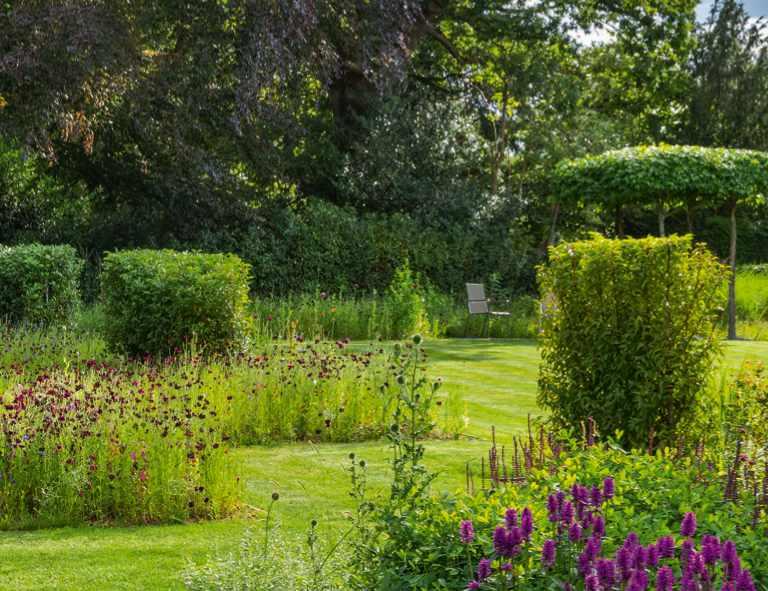

TAKE YOUR PICK
Raised beds define the productive garden at the end of the swimming pool building. In addition to this kitchen garden, there’s an extensive foraging area filled with fruit. “We wanted the clients to be able to go for a walk and pick a snack as they wandered. It’s an e�ective way of connecting them with the garden.”
• Steps need careful consideration, because awkward level changes can spoil the experience of walking through a garden. Here the risers are 150mm high with treads between 400500mm deep. “The mistake a lot of people make is to replicate the dimensions of an internal staircase, but that feels out of scale in a garden setting and uncomfortably steep when you don’t have a banister to grab on to,” says Gavin.
Turn the page for more design ideas
JULY 2022 GARDENSILLUSTRATED.COM 109 GARDEN DESIGN
D E F
Approach to planting
This garden was designed to require minimal maintenance in the long run but, like any new planting, it needed considerably more time and attention in its first year to keep weeds under control while the perennial planting had a chance to become fully established.
Although there is a prevailing modernity to the planting, the overall atmosphere is naturalistic, designed to blend into the surrounding countryside. Trees, large hydrangeas and the existing hazel copse give a structure which is reinforced by the animated deployment of decisive sections of hedging. Around these fixed points, the ornamental planting sweeps across the garden in swathes of single species planted in bold groups of up to 30.
The beds closest to the house deliver a punch of longlasting colour from reliable perennials including catmints, various hardy geraniums, Monarda ‘Mahogany’, Salvia nemorosa ‘Caradonna’ and Echinacea purpurea ‘Rubinstern’.
The clients were interested in exploring hydrangeas in the planting design, and many are gathered in one bed. Among those included are Hydrangea aspera Villosa Group, H. paniculata ‘Kyushu’, H. paniculata ‘Limelight’, H. serrata ‘Bluebird’, H. arborescens ‘Annabelle’, H. macrophylla ‘Libelle’ and H. macrophylla ‘Blauer Prinz’.
This is predominantly a summer garden, but there is also plenty of later-season interest from stems, seedheads and the russet tones of selected ornamental grasses, including the elegant Calamagrostis brachytricha, Pennisetum macrourum, which has flowerheads like cats’ tails, and Panicum virgatum ‘Rehbraun’, which turns a rich red in late summer.

The Liquidambar allée is underplanted with Deschampsia cespitosa ‘Goldtau’, a relatively low-growing grass (up to 75cm) with silvery flower plumes that turn a rich gold as they mature and last well through winter.
The renovated hazel coppice has been underplanted with Luzula nivea and Valeriana o�cinalis, while bold drifts of molinias and persicarias create a simple but e�ective base for the grove of birches.
In the ornamental meadow, which flanks the main pathway, a number of angelica trees, Aralia elata, puncture the lower-level planting to add another layer of interest. n
SUPPLIERS
Hartley Botanic
Tel 01457 873244, hartley-botanic.co.uk
Pictorial Meadows
Tel 0114 267 7635, pictorialmeadows.co.uk
Schellevis
Tel +31 (0)416 39 11 47, schellevis.nl
110 GARDENSILLUSTRATED.COM JULY 2022

GARDEN DESIGN
BUILT TO AST

WITH A BEST IN CLASS WARRANTY


Whatever the size and shape of your garden, we have the perfect lawnmower for you. Built with unrivalled quality and legendary reliability, our range of Honda lawnmowers are simply a cut above the rest.
For more information, and to find your local dealer, visit: honda.co.uk/petrolmowers

TO
UP









JULY 2022 GARDENSILLUSTRATED.COM 113 SOURCEBOOK Outdoor kitchens Long summer evenings can be extended even further by cooking in an outdoor kitchen COMPILED BY MOLLY BLAIR DESIGN FULLY EQUIPPED The Wildkitchen, POA, CC Wild Kitchens, 01747 442570, ccwildkitchens.com ENTERTAINING Grillo Layout L0610, £8,469, Grillo, 01223 866130, grilloliving.com BACK TO BASICS Gas BBQ and Modular Kitchen, £499.99, Von Haus, vonhaus.com SMALL SPACE WWOO Concrete Outdoor Kitchen, POA, The Outdoor Kitchen Collective, 01727 743712, theoutdoorkitchencollective.co.uk SIMPLY STEEL Draco Grills Outdoor Kitchen, £4,999.99, Draco Grills, 0118 380 0381, gardentrends.co.uk FULL RANGE A La Carte Mobile, from £18,000, Gaze Burvill, 01420 588444, gazeburvill.com SCANDINAVIAN STYLE Nordic Line Free-standing Outdoor Kitchen, £3,365, My Outdoor Kitchen, 020 3808 7703, myoutdoorkitchen.co.uk ON THE ROCKS Palm Outdoor Garden Bar Set, £1,657, Danetti, 020 3588 1380, danetti.com MODULAR Enamelled Outdoor Kitchen ADAPT units, POA, Vlaze, 01983 537773, vlaze.co
Brighten up your summer with a discount from the Gardens Illustrated Reader Rewards scheme, and save on travel, food & drink, plants and more
SAVE 10%
10% OFF VOYAGES ON THE HURTIGRUTEN NORWEGIAN COASTAL EXPRESS

If you fancy a holiday with a di�erence, a trip along the Norwegian coast with Hurtigruten is up there in the hall of fame of iconic travellers’ routes. Hurtigruten has been taking passengers along this stunning route for over a hundred years, faithfully serving Norwegian families and communities. Set sail on this historic, authentic voyage that takes in 34 ports of call and sails past more than 100 �ords and 1,000 mountains. Cross the Arctic Circle and hunt the Northern Lights in winter, or enjoy 24 hours of daylight under the Midnight Sun in summer.
HOW IT WORKS
1Browse
Take a look at some of our latest fantastic o�ers, covering gardening, lifestyle, travel, food and drink, and much more.
2 Redeem
Follow the link provided in each o�er and apply the o�er code when placing your order.
3 Find even more Head to gardensillustrated. com/o�ers to find the full range of discounts, deals and competitions available to you.
To browse our full selection of o�ers, go to gardensillustrated.com/o�ers
Rewards PROGRAMME
Visit hurtigruten.co.uk to use the code HRG-GIL at checkout, or call 0203 553 1644. 114 GARDENSILLUSTRATED.COM JULY 2022
FREE PRINT FROM SUSAN ENTWISTLE

Buy any of Susan Entwistle’s original artworks or amazing limited editions and receive a free 45cm signed print of your choice that’s worth £70. You’ll also get free framing and delivery.
Head to susanentwistle. com and use code Gardens22 at checkout.
20% OFF AT SEASALT CORNWALL
Refresh your summer wardrobe for less with Seasalt’s stylish collection of clothes and accessories inspired by the maritime history of Cornwall. Get 20% o� both in-store and online.

Visit seasaltcornwall.co.uk and use code GARDENS20, or quote this when in store.
SEND BEAUTIFUL FLOWERS FOR LESS
Get 12% o� letterbox flowers from Bloom & Wild – the perfect way to brighten someone’s day. This online florist also o�ers bouquets, houseplants and dried flower arrangements.

Go to bloomandwild. com and use the code GARDENS12.
SAVE 15% ON AIRPORT CAR PARKS
Get your holiday o� to a fantastic start with 15% o� parking at branded APH car parks. There’s also 10% o� at other car parks and up to 5% o� airport hotel and parking packages.

Visit gar15.aphpartners.aph. com to book – the discount is automatically applied.
SAVE OVER 30% ON TICKETS TO THE GREAT GATSBY


Be borne back into the past with this immersive production of The Great Gatsby. From the moment you enter Gatsby’s mansion, you’ll feel as if you’ve been transported back to the roaring 1920s. A hedonistic world of red hot rhythms, bootleg liquor and pure Jazz-Age self indulgence awaits, and as the champagne flows and the drama unfolds, the man himself will
be the perfect host in this heart-racing adaptation of F. Scott Fitzgerald’s classic novel. The immersive nature of the show means you may have the opportunity to follow the other guests into secret rooms and spaces, with Mr Gatsby himself, if you’re so lucky! Get £38 tickets for £25 to this amazing production – a saving of over 30%.
To book, visit immersivegatsby.com and use promo code TGGGI25.
To browse our full selection of o�ers, go to gardensillustrated.com/o�ers
JULY 2022 GARDENSILLUSTRATED.COM 115
AVE 15


WILLOW CROSSLEY,
gardening courses use code SUMMER20 createacademy.com joyful learning )DEXORXVO\ �RUDO� VHULRXVO\ FRPIRU WDEOH� WRWDOO\ ZDWHUSURRI
www.poddyandblack.com
The Fundamentals of Floristry
1DWXUDO 5XEEHU *DUGHQ 6KRHV
DOWNTOOLS
Book reviews, the crossword, competition and a new beginning
Fascicularia bicolor subsp. canaliculata is one of the botanical illustrations featured in Plants from the Woods and Forests of Chile reviewed on page 119.

JULY 2022 GARDENSILLUSTRATED.COM 117
GÜLNUR EKSI / PLANTS FROM THE WOODS AND FORESTS OF CHILE
UNEARTHED: ON RACE AND ROOTS, AND HOW THE SOIL TAUGHT ME I BELONG
by Claire Ratinon
Chatto & Windus (Vintage), £16.99
ISBN 978-1784744472
Reviewer Matthew Biggs is a plant expert, writer and broadcaster.
Claire Ratinon is passionate about growing organic vegetables; it’s in her soul. She has grown them for the Ottolenghi Restaurant, Rovi, written about them in The New Statesman and lectured at the Royal Botanic Garden Edinburgh. But it hasn’t always been this way.
This book documents the twists and turns in Claire’s often turbulent life that led her to find an identity through gardening, as a Black woman. We are led through her childhood in London, life as a documentary director, a foray into New York City and a rooftop farm, to the first year in her current home in the East Sussex countryside, where she has finally found some solace in the soil.
It is an informative and enlightening read and certainly an emotional roller coaster. Her lyrical descriptions of nature and the pleasures of gardening are a joyous counterbalance to her hard-hitting personal experiences of racism and the

troubling colonial history of her homeland, Mauritius, where the soil is more associated with colonialism and slavery. By the conclusion of the book, I felt I had gained a better understanding of the realities of being on the wrong side of racism and the challenges of wrestling with your identity and the attitudes of others.
The connection to growing food is constant throughout and it is a privilege to share her pleasure in growing vegetables, particularly those from Mauritius, which go some way to finally making her feel at home. Levity comes through her experience keeping chickens and demolishing a shed and it is impossible not to feel for Ratinon during her tough experience of working on an asparagus farm.
This is an outstanding work of storytelling and nature writing; Ratinon has a wonderful empathy with the British countryside, which is described so beautifully. It’s also a hardhitting and educational read.
WHERE THE WILDFLOWERS GROW: MY BOTANICAL JOURNEY THROUGH BRITAIN AND IRELAND
 by Leif Bersweden
by Leif Bersweden
Hodder & Stoughton, £20
ISBN 978-1529349535
The State of Nature 2019 report outlined how dramatically our wildlife has suffered since the 1970s. Forty-one per cent of species are in decline and 15 per cent under threat of extinction. A separate 2017 study reported that 97 per cent of wildflower meadows have been lost since the 1930s. Given that nearly 1,400 species of pollinators and other insects – vital to food production – rely on meadow plants for their survival, these figures are alarming.
But, there is a clear resurgence in the public’s commitment to the natural world, strengthened by the reconnection with nature so many found during lockdowns. There are also those for whom nature is everything. Leif Bersweden is one of these. His book is a lyrical appeal for us to cast our eyes to the ground and notice the incredible beauty and diversity of flora that exists all around us.
Over a Covid year, Bersweden travelled across Britain and Ireland by train and bicycle to find rare and graceful
plants in ordinary and extraordinary landscapes. We follow him from the sight of a daisy in Westminster to flocks of burnt orchids on Salisbury Plain, washes of thrift on The Lizard, and a single, pearly white flower of Edmonston’s chickweed in Shetland.
Bersweden’s book is rich with far-reaching botanical tales: how cow-wheat uses ants to bury its seeds underground; why the Norse goddess Frigg condemned mistletoe to a life in the treetops.
Most compelling of all are Bersweden’s regular meetings with those whose purpose is to watch over our floral diversity. As one such ecologist he meets observes: ‘Take away the birds and the habitat still exists… but take away the plants and you immediately lose the birds as well as everything else.’
If Bersweden’s book encourages us to appreciate our flora a little more, then it will have done its job. Because appreciation leads to care, and care – hopefully –to protection.
118 GARDENSILLUSTRATED.COM JULY 2022
A lyrical journey around Britain and Ireland conveys the beauty our plant life and the urgent need to protect it.
Reviewer Rachel Seaton-Lucas is a landscape designer and writer.
A poetic and sometimes unsettling autobiography detailing how growing food helped redefine a personal relationship with the land.
PLANTING FOR GARDEN BIRDS: A GROWER’S GUIDE TO CREATING
A BIRD-FRIENDLY HABITAT
by Jane Moore
Q £ 2 99
ISBN 978-1787138292

and natural food.
Reviewer Kate Bradbury is a garden and wildlife writer, and author.
BOOK REVIEWS
PLANTS FROM THE WOODS AND FORESTS OF CHILE
by Martin Gardner, Paulina Hechenleitner Vega and Josefina Hepp Castillo
Royal Botanic Garden
Edinburgh, £35
ISBN 978-1910877432
This is a charming and beautifully illustrated book about how you can easily attract birds into your garden by following a few simple tips on what to plant.

Aimed mainly at beginners, the book features anecdotal notes by author Jane Moore on some of the birds that she loves to see in her garden, along with tips on what to do for birds each season, such as cleaning out nest boxes, leaving windfall fruit and planting shrubs that produce berries.
I found the bird facts pages a nice – and sometimes fascinating – touch, although I was perhaps a little surprised to find information on the albatross in a book about garden birds. Moore has also included some ‘spotlight’ features on some of the more common bird species. And these are woven through the more practical elements of the book giving it a comfortable, accessible feel.
As well as plant lists for each season, Moore also
includes tips on how to plant, with ideas for habitat creation as well as the plants themselves. I particularly liked the section on layering in the garden to make a more attractive habitat. There’s a good focus on planting for insects, and food chains, which is great, although this could be more detailed. Seed- and berry-bearing plants are well documented, as is the brilliant advice to leave seedheads standing in winter.
Overall, this is a beautiful, warm and accessible introduction to gardening for birds. I would have liked to have seen more on some of the habitats themselves, including hedges and long grass, and an explanation of native plants and caterpillars would have been useful.
But what it lacks in detail it makes up for in charm, and will certainly give the reader some great pointers on planting, along with wider habitat creation and the basic principles of catering for garden birds.
Botanical art has long combined the exquisite with the scientific, the detailed paintings being used by botanists to document an accurate record of collected plants. This book has similar aims, using 81 specially commissioned botanical paintings to illustrate the diversity of the forest plants of Chile and help us appreciate their unique nature.
In a foreword by HRH Prince Charles, we’re told that Chile’s woods and forests are the last remaining tracts of coastal rainforest in the southern hemisphere, now threatened by depressingly familiar challenges. The country is considered a ‘biodiversity hotspot’ with many endemic plants.
The opening sections introduce us to the history of botanical illustrations of Chilean plants, the links between Chile and the Royal Botanic Garden Edinburgh and descriptions of Chile’s geography and itsforest habitats. It’s then divided into sections covering the plant groups,
broken down into plant families and the 81 selected species. The illustrations are gorgeous and each plant description is packed with information and is written in an accessible style so that even the non-botanically minded can absorb the information without difficulty.

I was surprised by how many of the plants I knew, and fascinated to learn more about their natural habitat, how to grow them and how they’re used in Chile and the UK.
There’s a lot to take in and at times I wondered whether a narrower focus might have got fewer messages across more effectively, but Gardner and his collaborators wanted to celebrate the role of art in botany as much as the country of Chile and its flora.
They hope these beautiful illustrations will help us to understand and share their passion. They also want us to understand the need to protect these unique plants and in that I’d say they’ve succeeded.
JULY 2022 GARDENSILLUSTRATED.COM 119
A great introduction to gardening for birds, with some good tips on the basics of habitat creation
An exploration of plants from Chile that uses botanical art and accessible writing to inspire and engage readers with a conservation message.
Janice Shipp is a gardener and garden writer.
BOOK REVIEWS
THE PHYSICK GARDEN: ANCIENT CURES FOR MODERN MALADIES
 by Alice Smith
by Alice Smith
Frances Lincoln, £16
ISBN 978-0711266339
Other books
From the greening power of seedbombs to the healing power of nature, the best of the rest of this month’s books.
LET’S WILDFLOWER THE WORLD by
 Josie Je�ery
Josie Je�ery
Leaping Hare Press, £16.99
ISBN 978-0711275393
Advice on starting your local green revolution through seedbombing and seed swapping, and creating your own seed bank.
RHS THE LITTLE BOOK OF CACTI & SUCCULENTS by
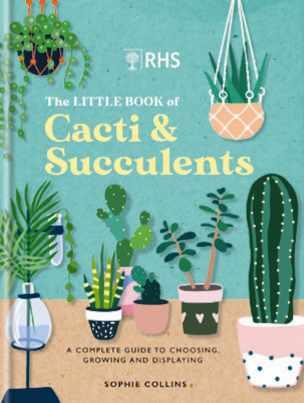 Sophie Collins
Sophie Collins
Mitchell Beazeley, £14.99
ISBN 978-1784728342
Have you ever taken extract of willow to soothe a headache? Chances are you have if you’ve ever popped an aspirin, as one of the main components of aspirin is salicylic acid, which is sourced from the dried bark of the willow tree.
It can be easy to forget that plants are the foundation of most of the medicines we still use today. Foxgloves, for example, feature in heartstrengthening drugs and European yew needles in anti-cancer medication.
It’s a practice that goes back a long way, right back to the Ancient Greeks, Romans, druids, Chinese herbalists and housewives who did all the groundwork seeking cures for maladies that have plagued humans since the dawn of time.
And what a fascinating history it is – something recognised by artist and illustrator Alice Smith who has brought out this stunning compendium of 80 plants and their usage over the centuries.
Designed to ‘intrigue, surprise and delight’ rather
than be an exhaustive botanical guide, this book draws on each plant’s significance in history and folklore, highlighting their medicinal properties and usage right up to the present day.
Smith writes pithily and engagingly, never failing to fascinate with her dips into etymology (coltsfoot is so named because of its resemblance to a horse’s hoof) and social history (Italian Renaissance women dropped belladonna in their eyes to make their pupils bigger and more ‘attractive’), while also managing to keep the content relevant to the constantly evolving world of modern medicine.
Organised into chapters themed by areas of the body, each plant is accompanied by mind-bending illustrations by Smith, which perfectly embellish this engrossing and beautiful little book. One to read in the garden, perhaps with a calming cup of skullcap leaf tea.
A guide to growing and propagating these fascinating plants throughout the year, including plant profiles according to style and shape.
THE YEW HEDGE by Martin
 Gardner
Gardner
Royal Botanic Garden Edinburgh, £20, ISBN 978-1910877425
The fascinating story of some remarkable native forests and heritage trees of the European yew (Taxus baccata), both in the UK and overseas.
THE ULTIMATE FLOWER GARDENER’S GUIDE by Jenny
 Rose Carey
Rose Carey
Timber Press, £23.99
ISBN 978-1643260389
Advice on how to combine plants for the most spectacular e�ects and keeping the show going from year to year.
THE BALLAST SEED by
Rosie Kinchen
Weidenfeld & Nicolson, £18.99
ISBN 978-1474618175
Memoir about unexpected pregnancy, depression and finding solace in gardening, interwoven with the travel journals of a 19th-century female botanist.

120 GARDENSILLUSTRATED.COM JULY 2022
An intriguing book that recounts some of the history and folklore linked to the plants that we have used to heal and cure our bodies.
Reviewer Abigail Whyte is a freelance writer.
BOOKING NOW Garden Makers Day 2 November with Ambra Edwards ~ Jo Thompson ~ Xa Tollemache

THE ESSENTIAL GARDEN DESIGN DIPLOMA


January – March 2023



Based at the Chelsea Physic Garden and led by Rosemary Alexander and architect Catriona Rowbotham, the course is an overview of Garden Design, covering all the elements needed to rethink an average garden. Taking students step by step through site surveying, using the grid, horizontal and vertical features, garden layouts and planting plans, costing and specification, plus drawing tuition and homework on design and plant portfolios. Tutors are well respected in the industry and will guide students on how to succeed in this diverse profession.
(2 days a week (Wed & Thu), 10.30am–3.15pm, plus 2 days homework)
ONE YEAR GOOD GARDENING DIPLOMA
September 2022 – beg July 2023
Covers the best in planting design while training in the more serious aspects of horticultural techniques. Practical sessions held at Arundel Castle under the guidance of head gardener Martin Duncan and at Sandhill Farm House, Rogate. Lectures by many leading gardening personalities and regular visits to outstanding private gardens. Students also learn to draw up planting plans.
(1 day a week (Tues), 10.30am–3.15pm, over three terms)

GARDENING FOR BEGINNERS
Wednesday & Thursday 19, 20, 26, 27 April 2023
One of our most popular courses, led by master horticulturist Ben Pope, which aims to take each student through all the practical elements of caring for a garden from soil, tools, maintenance, seed sowing and propagating, weed control and pests and diseases. The first 3 days will be spent with lectures at the Chelsea Physic Garden and the final day will be spent gaining practical experience in Rosemary Alexander’s much praised garden near Petersfield and another private garden nearby, where Ben is in charge. Participants will be given a chance to prune, plant, sow seeds and regular maintenance tasks will be discussed. A light lunch and refreshments will be provided daily.
GARDEN DESIGN & CARING FOR YOUR GARDEN
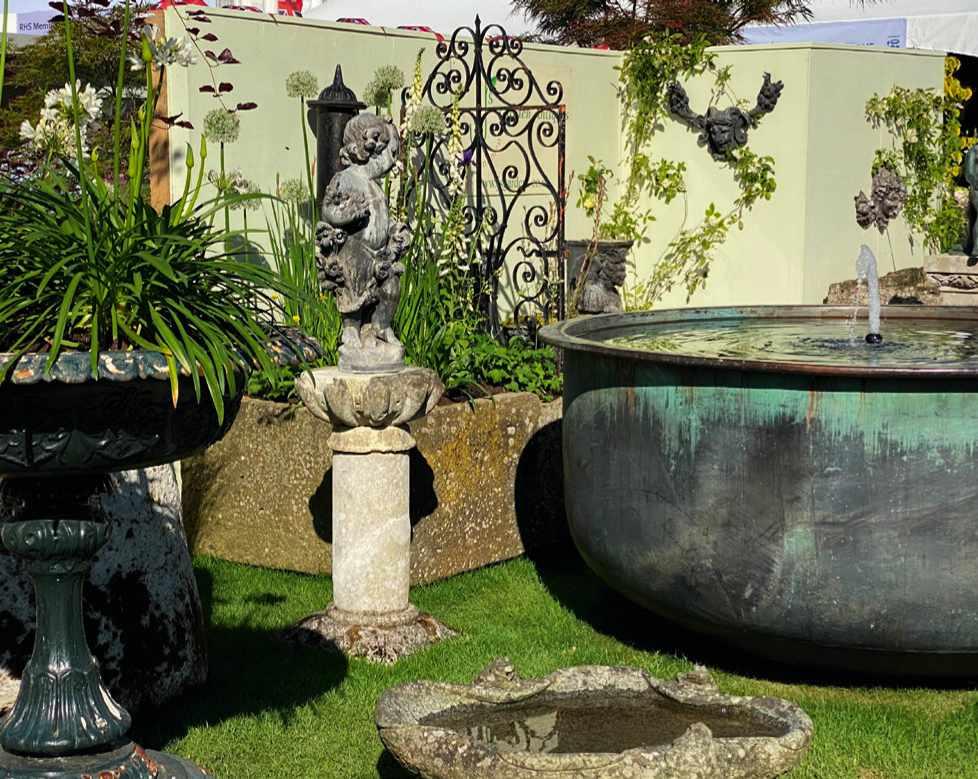

Distance Learning Courses study anytime, anywhere in the world


A stepping stone to a new career. These two correspondence courses are a step by step guide to either designing your own garden or learning how to plant and maintain an existing garden: drawing up plans, hard landscaping, site analysis, planting, month by month tasks etc. Taught through a comprehensive course book, with projects submitted to us. (1-3 years to complete and individual assessment)

�������� �
������
��� ������ �� �������� �
��� �
��� � ��������� � ���� � �� ���
�
����� ��� �������� ����� ����� ��� � www.jsgardens.co.uk 01905 381679 / 07930 576881 Long established as the leader in all design and gardening tuition and based at the unique and historic Chelsea Physic Garden
sure which Diploma course is for you? We prefer potential students to attend an Information Session when Rosemary explains the whole course content and you can see our facilities at the historic Chelsea Physic Garden. JUST CONTACT US TO SET UP A DATE/TIME www.englishgardeningschool.co.uk Email: info@englishgardeningschool.co.uk Tel: 020 7352 4347 Garden of Medicinal Plants – Chelsea Physic Garden
Not
Photo: R Alexander





































P L A N T S U P P O R T S & Garden Artefacts Beautiful designs for perennials, roses, shrubs & climbers Made in England www.leanderplantsupports.co.uk Tel. 01773 550495 www.btrddesign.com info@btrddesign.com | 074 54 711 057 01473 328272 • sales@s chsupplies.c o.uk • w w w.s chsupplies.c o.uk G a r d e n Wat e r e r s & S p r ay e r s Contact us today for a FREE brochure featuring over 200 British products, or visit our website to find out more. S ll S s M A D E I N B R I TA I N SCH manufacture a vast selection of robust garden waterers & sprayers, perfect for areas far from your fixed water source. Estate & Garden Waterers Hanging Basket Waterers Indoor Watering Units al
Small Towed
Push Sprayers
Sprayers
Sprayers
ACROSS
7 Petal-like part of flower’s perianth –seen in date palm (5)
9 An Arabis plant for an alpine setting –stone salad plant? (4,5)
11 Genus of trumpet vine plant – miss cap off (7)
12 Perennial aka angels fishing rods –admire a variation (7)
13/29 down A vivid-yellow cherry tomato – star infant? (3,4)
14 A Bellis perennis series with pompom-like flowers – found in aubrietas sometimes (5)
15 Pots, prior to planting, should be
___ … as a new pin? (5)
16 Pansy relatives – might be associated with dog (7)
18/27 down Common name of Crinodendron hookerianum – could light up your garden? (7,4)
20 Thorny bushes producing sores? (5)
22 A taxonomic species term, meaning ‘pink’ (5)
24 Droop… of Salvia herb, lacking energy (3)
26 Italian name for vegetable Salsola soda, aka saltwort – grate it, roughly (7)
28 Genus of false acacia – from Nairobi, maybe (7)
30 Series of trailing petunias with ruffled, double flowers – Tina holds umbel (9)
31 Petal-like leaf eg of Cornus (dogwood) (5)
DOWN
1 Keeps a supply of fragrant flowers of Matthiola genus? (6)
2 Broad-leaved trees of genus Ulmus (4)
3 Eg Yellow flags and Stinking Gladwyns (6)
4 Type of earth loved by eg heathers (4,4)
5 A crimson-flushed apple that’s the peak of perfection! (4)
6 Plant grown for its seed said to magically open doors? (6)
8 Point me out Capsicum annuum aka sweet pepper (7)
10 Flaming sword bromeliad – and Irish river (7)
14 Eg bays, elders and planes (5)
15 Tender perennials with showy flowers – “unable to” some Scots might say! (5)
16 Lush with vegetation (7)
17 Best-known series of trailing petunias – is unfair to move (8)
19 A heavy-cropping strawberry – alas, ten spoilt (7)
21 Common name of houseplant Justicia brandegeeana: ‘___ plant’, a puny type! (6)
23 “Scatter manure or fertiliser” –magazine’s prominent feature (6)
25 Works hard and puts plant scion on to rootstock (6)
27 See 18 across
29 See 13 across

TO
CLOTHBOUND SLIPCASES
Cost from £9.99 each (inc p&p). Subscriber discounts available – see below for details.
GARDENS ILLUSTRATED PRINTED ISSUES ORDER FORM




Complete this form and send to: Gardens Illustrated, Back Issues, PO Box 3320, 3 Queensbridge, Northampton NN4 7BF (You may photocopy this form).
I would like to order copy/copies of issue(s)
SUBSCRIBERS
n UK – £4.79 per copy
n EU – £5.59 per copy
n Rest of world – £6.39 per copy
NON-SUBSCRIBERS
n UK – £5.99 per copy
n EU – £6.99 per copy
n Rest of world – £7.99 per copy
I would like to order slipcase(s)
SUBSCRIBERS
n UK – £8.49 each
n EU – £9.45 each
NON-SUBSCRIBERS
n UK – £9.99 each
n EU – £10.50 each
n Rest of world – £10.80 each n Rest of world – £12 each Postage & packaging is included in all prices.
n I enclose a cheque/international money order made payable to Our Media Ltd for £ n I would like to pay by credit/debit card, please debit my card Visa n Mastercard n
n n n n n n n n n n n n n n n n
Expiry date n n n n Issue no. (if shown) n n
Signature
YOUR DETAILS
Title Forename
Surname
Address
Post/Zip code
Daytime tel no.
Email address
Subscriber number (if applicable)
and promotions
email. You can unsubscribe at any time.
Please tick here if you would like to receive these n
We would also like to keep in touch by post and telephone about other relevant o�ers and promotions from our publisher Our Media Limited. If you’d rather not be contacted this way please tick here post n phone n For more information about how to change the way we contact you, and how we hold your personal information, please see our privacy policy, which can be viewed online at policies.immediate.co.uk/privacy
BUYING BACK ISSUES OF
ORDER PRINTED COPIES OR SLIPCASES
VERSION
money when you subscribe to the digital edition –see page 26 PRINT VERSION
can buy printed issues of the magazine published up to six issues ago at buysubscriptions.com or see below for details.
DIGITAL
Save
You
Date / / SINGLE ISSUES CLOTHBOUND SLIPCASES PAYMENT DETAILS
"
IN TOUCH
Illustrated (published by Our Media Limited) would
to
you updates, special o�ers
KEEP
Gardens
like
send
by
U N I T E D K I N G D O M UNITED KINGDOM 0 3 3 3 0 1 6 2 1 14 03330 162114 O U TS I D E U K OUTSIDE UK + 4 4 1 6 0 4 97372 2 +44 1604 973722
TO
CROSSWORD
1 Acaena 5 Mophead 9 Opal 10 Butia 11 Pods 13 Red orach 15 Stye 17 Warmth 20 Key 21/12 Pied Piper 22 Tiarella 23 Daphne 24 Rosa 25 Totem 26 Eddo 28 Darmera 29 Sashes. DOWN 2/16A/18 Cup and saucer 3 Eclipse 4 Amber 5 Matured 6 Pea 7 Emperor 8 Dodecatheon 12 Pot marigold 14 Downy 16 April 19 Corsair 20 Knautia 21 Peppers 23 Domes 25 Tie 27 Dye.
SOLUTIONS
THE SUMMER
ACROSS
Solutions to this issue’s crossword will be printed in the August issue
Crossword •
READER COMPETITION
WIN
VIP trip to Italian Lakes & garden show
Orticolario brings a touch of Italian style to the world of gardening with the aim of exploring how nature can inspire. The three-day gardening show is held in the grounds of Villa Erba, Cernobbio, overlooking Lake Como and brings together top designers, nurseries and garden product companies, all with an eye to the very best in gardening, art and design. The show encourages visitors to bring colour, scent and new creations to the fore in their own gardens, no matter how large or small.
Held in early autumn, Orticolario presents visitors with show gardens from an international selection of designers
exploring the theme of ‘creative spaces’. Expert plantspeople will be on hand to offer advice on the best plants for late season interest, and there will be seasonal food and drink to enjoy.
To find out more about the show and events taking place, go to eng.orticolario.it
COMPETITION
The Orticolario team is giving Gardens Illustrated readers the chance to win a weekend trip for two to Lake Como, including a visit to Orticolario garden show as VIP guests. The prize (for two people)*
• Flights: out London to Milan on
30 September 2022; return Milan to London on 2 October 2022.
• Transfers from and to Milan airport.
• Two nights’ stay at the Sheraton Lake Como in a double room.

• Tickets for Orticolario garden show on Saturday 1 October with lunch in the VIP area.
• Cultural tour with guided visits of Villa Bernasconi and Villa Pizzo on Sunday 2 October.

TO ENTER
For your chance to win, answer the following question
In which Italian region will you find Lake Como?
a) Lombardy
b) Apulia
c) Emilia-Romagna
Enter online at gardensillustrated.com/orticolario
Closing date 11.59pm, 9 August 2022.
* Prize sponsors: Benetti Viaggi, Cernobbio Limousine Service –Sala Simone, Sheraton Lake Como, Orticolario.
TERMS AND CONDITIONS
• In the event that the winners find themselves unable, due to force majeure, to take advantage of the trip, they will receive codes for an interactive visit to Villa Erba, the historic residence of the film director Luchino Visconti, to be enjoyed from the comfort of their own home.
• The promoter is Our Media Limited (company number 05715415) with its registered address at Vineyard House, 44 Brook Green, Hammersmith, London W6 7BT. This promotion is open to all residents of the UK, including the Channel Islands, aged 18 years or older.
• For full terms and conditions, see gardensillustrated.com/orticolario
LUCIANO MOVIO, LUIGI FIENI
124 GARDENSILLUSTRATED.COM JULY 2022
Win a trip to Orticolario, one of Italy’s premier gardening events, held in the grounds of Villa Erba on the shores of Lake Como, 29 September – 2 October 2022
Nursery guide
Get inspired for the summer season with the best plant and bulb suppliers


BUNKERS HILL PLANT NURSERY

A small family-run plant nursery near Woodstock, Oxfordshire, with an old-fashioned feel and traditional values. Our sta� have a wide range of horticultural knowledge and we o�er a huge selection of top-quality plants including rare and unusual varieties. bunkershillgardenshop.co.uk

01869 331492
THE PLANT SPECIALIST
Established in 2002 the nursery is located in the Chilterns and is dedicated to growing a wide range of new and unusual herbaceous perennials and ornamental grasses – many of which can be viewed in the display gardens.
theplantspecialist.co.uk
01494 866650
MEADOWGATE NURSERY
A family-run, independent nursery, specialising in ornamental grasses. Over ten years’ experience of growing a diverse range of grasses. We o�er tailored advice on the use and care of the grasses we sell.

meadowgatenursery.co.uk
07736 523262
BINNY PLANTS

2022 Peony catalogue online. More than 300 herbaceous, intersectional, and tree peonies, as well as thousands of perennials, grasses, shrubs and ferns are now available for delivery nationwide. binnyplants.com contact@binnyplants.com
PELHAM PLANTS
Quality perennials lovingly propagated and grown in peat-free compost at our charming woodlandedge nursery in Sussex. Mail order and downloadable catalogue available. Visits by appointment only. pelhamplants.co.uk pelhamplants@gmail.com
BEETHAM NURSERIES
Award-winning, family-run plant nursery in Cumbria, specialising in herbaceous perennials and plants for over 30 years. We pride ourselves on our expert knowledge, friendly sta� and our passion for plants. beethamnurseries.co.uk
01539 563630
ASHWOOD NURSERIES
An independent nursery situated in the West Midlands o�ering many home-grown, beautiful plants. Open seven days a week. Mainland UK mail-order service available. ashwoodnurseries.com
01384 401996
STOTTS NURSERY
Small, family-run nursery set in Chiltern Hills woodland, specialising in hardy annuals, herbaceous perennials, shrubs, climbers and trees. �ey have display borders for inspiration and use only peat-free compost. stottsnursery.co.uk
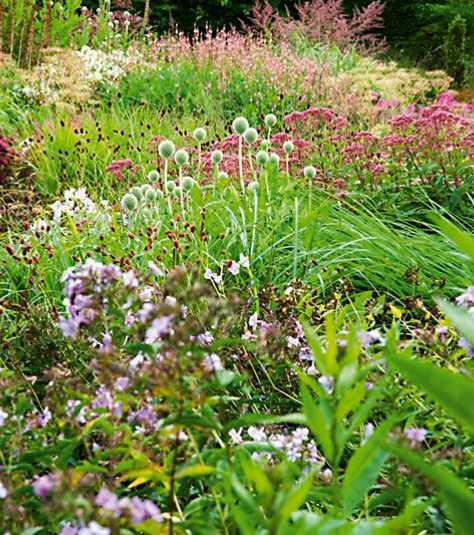
07542 718307
OLD COURT NURSERIES
Specialist family-run nursery and garden open from April, Wednesday to Saturday, 11am–5pm. Catalogue available on request. Order now for delivery of Michaelmas daisies and more. autumnasters.co.uk

01684 540416

ADVERTISEMENT FEATURE
Summer gardens to visit
Summer is a great time to visit this collection of stunning gardens
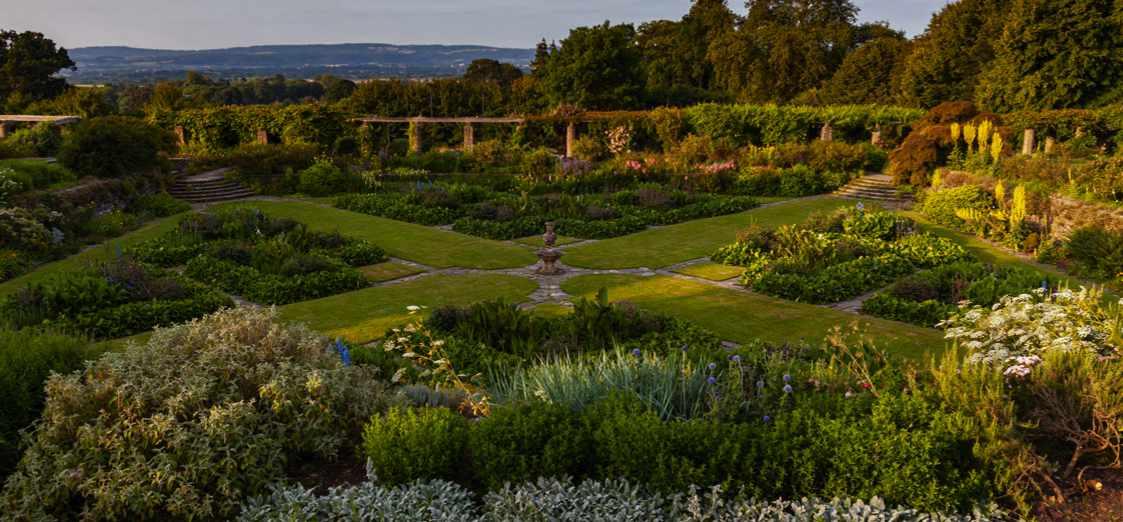


1COTTESBROOKE HALL
The 14-acre, Arts and Crafts-style gardens of Cottesbrooke Hall are a constant source of innovation and development – from the formal gardens that surround the Hall, to the Wild Garden, which flanks a meandering stream where acers, spring bulbs and gunneras create a romantic and tranquil air.
Cottesbrooke, Northamptonshire NN6 8PF | 01604 505808 | cottesbrooke.co.uk
2SISSINGHURST CASTLE GARDEN NATIONAL TRUST
Sissinghurst hosts a specially commissioned exhibition by Charlotte Smithson, Another World Than This. Delicate test tubes filled with carefully chosen plant specimens will be stitched together and suspended from the ceiling of the oast exhibition space.

Nr Cranbrook, Kent TN17 2AB | nationaltrust.org.uk/sissinghurst-castle-garden
4GLAMIS CASTLE
Situated in heart of Angus, Glamis Castle is renowned for its rich history. The castle offers guided tours where visitors can explore the fascinating 1,000year history, while the gardens have an array of outdoor spaces including The Italian Garden, Nature Trail, Walled Garden and the atmospheric Macbeth Trail.
Angus, Scotland DD8 1RJ | 01307 840393 | glamis-castle.co.uk

3THE SAVILL GARDEN
�is haven of beautiful gardens and woodland combines traditional and contemporary styles, with Royal connections throughout. A highlight this summer is the Rose Garden, designed with beds of curves and crescents that provide a crescendo of colour and scent on the walkway above.
Englefield Green, Surrey TW20 0UJ | windsorgreatpark.co.uk
5HESTERCOMBE GARDENS
Hestercombe encompasses 50 acres of quintessential Somerset gardens, spanning three centuries of garden design. The estate offers a unique combination and varied experience of the Georgian Landscape Garden (designed 1750s), the Victorian Shrubbery and the Edwardian Formal Gardens (early 1900s).
Taunton, Somerset TA2 8LG | 01823 413923 | hestercombe.com

ADVERTISEMENT FEATURE
1
2
3
4 5
Summer inspiration
ONGLEY-SNOOK DESIGNS
Fabulous, fused-glass �sh swimming in your borders, designed speci�cally for the garden. �ey are frost safe, the heron won’t eat them and they don’t need feeding!

01243 573411 ongley-snookdesigns.com
ARCHITECTURAL HERITAGE
To complement and extend our collection of hugely popular Verdigris patinated copper garden planters, we are delighted to introduce �e Rectangular Copper Water Container, available to order in various sizes. Please contact us to discuss your requirements or request a copy of our latest catalogue.

01386 584414 architectural-heritage.co.uk
POTTER & MOOCH
Explore our new Earth Collection of Ear Wings ear climbers. Handcra�ed by the sea in Sussex, using recycled silver and gold. Choose from a large range of precious gemstones and crystals. �e perfect gi�, or simply to enjoy yourself. Featured design is called ‘Maldives’. Hypoallergenic and nickel free. From £24 a pair.

01903 331744 potterandmooch.co.uk
DEVENICK DESIGNS
Using the natural re�ective properties of polished stainless steel brings added glamour and beauty to your garden. ‘Primrose’ the posh heron stands at 1.2m tall, is handmade and polished by us in marine grade 316 stainless steel. �is contemporary, eye-catching sculpture will add elegance to any garden bed, pond or rockery.

07720 841394 devenickdesigns.co.uk
WONDERLAND BOUTIQUE
A pure silk scarf is a perfect gi� �e Silk Scarf shown is £39 with free gi� wrapping and p&p. Visit wonderlandboutique.com to view their stunning collection of silk scarves and clothing.

01263 732643 wonderlandboutique.com
PERILLA ALPACA SOCKS
Blissfully comfortable 75% alpaca short ribbed socks repel bacteria and odour and keep feet at a perfect temperature. �ey have ribbed sides and a so� cushioned sole in a great palette of colours from vibrant raspberry and purples to natural undyed colours of pale grey and mid brown.

01886 853615 perilla.co.uk
GARDENS AFTER DARK
Give your outside space an upgrade with our range of garden lights and enjoy your garden a�er dark, not in the dark. Our free design service, easy self-installation and low running costs will help you make the most of your long summer evenings.
@gardensafterdark gardensafterdark.co.uk

ADVERTISEMENT FEATURE
From beautiful garden inspiration to practical accessories, we can help to make your summer special
Ironwork Door Canopies
catalogue available 01225 851577

www.garden-requisites.co.uk
Metal Plant Supports
5 x 75cm Medium Curved £18.99
5 x 62cm Large Curved £18.99
5 x Loop 130cm £15.99
free delivery on orders over £45* See T & C www.bespokeplantsupports.co.uk


Aquaplancton

Voted Home and Garden “Product of the Year”
Pond before W��������
Aquaplancton has been clearing ponds of blanket weed, duckweed, algae, �������������������������������������������������������������������������W������ ��������������������������������������������������������������������������

Aquaplancton has been clearing ponds of blanket weed, duckweed, algae, green water, sludge, slime, odour and clogged filters, for over 30 years. People re-order time and time again which says a lot for this safe, natural remedy.
www.aquaplancton.co.uk
Tel: 01298 214003

Janet Mavec’s collection of everyday, wearable jewelry, plucked directly from nature. Made of 18kt gold plated brass. Shipped worldwide. For WOI discount use code WO!20 (expires 31/12/22). Visit www.janetmavec.com or email info@janetmavec.com

To advertise call Mica Enwright on 0117 300 8756 Marketplace PRODUCTS
AUGUST
Small gardens issue
• Tom Coward’s favourite plants for summer’s peak
• A meandering, magical garden created by Stefano Marinaz in a compact north London space
• Adventurous colour at De Doolman, a modern Dutch garden connected to the countryside beyond

• Reimagining a small garden as an evocative urban jungle
ON SALE 9 AUGUST
Save money when you subscribe to the digital edition – see page 26. Also in selected Waitrose, Sainsbury’s and Tesco stores, as well as WHSmith, and all good magazine retailers.
JULY 2022 GARDENSILLUSTRATED.COM 129
JASON INGRAM, ALISTER THORPE, ROBERT MABIC, RACHEL WARNE
BY ALICE PATTULLO
A NEW BEGINNING
In the first of her new column, Alice remembers the excitement of finally getting the chance to make her own garden entirely from scratch
 by Alice Vincent
by Alice Vincent
At the end of the month, I’ll celebrate my garden’s second birthday. Two years since my partner and I moved into this garden flat in Brixton. On moving day, I put off inspecting my new outdoor realm until we’d removed the last few boxes from the car. Then we cracked open a bottle of fizz and swug straight from the bottle, sweat working its way through my Taylor Swift T-shirt. I took in the first private garden of my own. The last of the clematis flowers were hanging on; it was the middle of a beautiful summer.
Until then, I had only gardened on balconies: the first one exposed and bright enough to grow tomatoes on; the second larger, but surrounded by mature trees. Neither were as large as the spaces given to the balcony designers at the Chelsea Flower Show to landscape, but in many ways they were ideal spaces to teach oneself to grow in. A balcony may force you to heft compost up four flights of stairs, but at least you can control your growing conditions. Frost barely permeates, pests are limited. If you can muster a green oasis in a couple of square metres, you’ve cracked the first big secrets of gardening: problem-solving and perseverance.
When people found out I was finally getting a garden after five sky-high years, they
surmised that I must be terribly excited. In reality, I was overwhelmed. I’d never worked with soil in a meaningful way, I’d barely contemplated making compost. Constructing flowerbeds was something I’d only read about in books. There was huge promise in this garden – a blank slate of untidy turf, a few sad shrubs and the world’s most disproportionately large patio – but there was real potential I’d come up short of whatever expectations I thought I held.
Two years on and I’ve learned plenty; I mulch my beds with home-made compost, I sow hardy annuals. I spent the afternoon of my 32nd birthday wrenching a Kiftsgate rose out of the ground, and Valentine’s Day planting a bare-root Rosa The Generous Gardener. Over the course of that first year I watched the light shift across the back wall of the garden from my desk, and, as the seasons changed, things grew up against it. Quite by accident, I’d created a late summer-garden, one flush with dahlias and grasses. On the August bank holiday we threw a party there, and it felt like a homecoming.
The second year has been calmer and more considered. The winter beds were filled with the skeletons of summer’s perennials, I threw in dozens of narcissi among the previous year's preciously planted tulips and it kept the squirrels away (they don’t like the
taste). We’d plumped for an April wedding, and so I abandoned the lot for a honeymoon at the start of the growing season. This may sound heretical to some gardeners, but what I’ve learned most from the garden is that it manages quite well without me. We returned to long grass, plenty of deadheading and new surprises for a new stage of life.
What lies ahead for year three? Bigger things, I hope. I’d always envisaged the garden to have two stages: one of hapless experimentation, another of landscaping and order – less playing around the edges, more forming something that allowed me to really grow. I dream of plume poppies and martagon lilies and delicate, tiny narcissi. I long to plant a tree.
One thing I’ve realised the garden is truly missing is a spot to sit and bear witness; it’s lacking an inviting, sun-drenched corner. Because while we can plan planting schemes and trawl through seed catalogues, the most vital part of gardening is to look and to be. I’m currently a rather frantic gardener, rushing around making mental lists and finding things to do. I’d like to be a more observant one, taking in a better understanding of what the space has to offer and making a garden with that in mind, too. Where a good nook starts, a deeper view follows. n
130 GARDENSILLUSTRATED.COM JULY 2022
ILLUSTRATION
The only timber greenhouses endorsed by the RHS
From the smallest coldframe to the largest glasshouse, you can expect the same leading quality, value and attention to detail that we are famous for.
All our greenhouses are constructed using precision mortise and tenon joints, the highest quality Western Red Cedar and come with our renowned H\[VTH[PJ M\SS SLUN[O YPKNL ]LU[PSH[PVU Z`Z[LT��L]LU [OL Ä_PUNZ HYL ZVSPK stainless steel or brass.
For a Complimentary Brochure visit www.gabrielash.com, call us on 01242 662 926. You can also visit our Gloucestershire showroom.

See us at the RHS Flower Show Tatton Park (20th - 24th July) stand 331. We look forward to seeing you there.

®The Royal Horticultural Society. The Royal Horticultural Society, and its logo, are trade marks of The Royal Horticultural Society. (Registered Charity No. 222879/SC038262) and used under licence from RHS Enterprises Limited.
The RHS Wisley Planthouse
UNRIVALLED KNOWLEDGE


There is a wealth of knowledge and expertise built into every Hartley Botanic Glasshouse. Generations of customers have put their trust in the hands of expert, time served, highly skilled craftsmen. Glasshouses of distinction are created from decades of knowledge and care.

Discover the secret of Hartley Botanic by calling UK - 0800 783 8083 or visit www.hartley-botanic.co.uk USA - 781 933 1993 or visit www.hartley-botanic.com The only aluminium Glasshouses and Greenhouses endorsed by the RHS ® The Royal Horticultural Society. The Royal Horticultural Society, and its logo, are trade marks of The Royal Horticultural Society (Registered Charity No 222879/SC038262) and used under licence from RHS Enterprises Limited. NOTHING ELSE IS A HARTLEY BESPOKE VICTORIAN GRAND LODGE WITH CANOPY AND PERGOLA Kent, UK WHY HARTLEY
& EXPERTISE
Visit us at the RHS Flower Show Tatton Park 20 th - 24
July 2022
th























































 COMPILED BY MOLLY BLAIR
COMPILED BY MOLLY BLAIR



 1. Wooden Berry Picker, £22.95, 0345 605 2505, worm.co.uk 2. Korbo Classic 35 Basket, acid-proof steel, H 24cm x Ø 45cm, £121, 020 3002 1196, nordicnest.com 3. Draper 19628 Telescopic Fruit Picker, £14.59, 01358 726719, toolden.co.uk 4. Niwaki Original Tripod Ladder, 2.4m, £529, 01747 445059, niwaki.com 5. Planting Ruler, 30cm, £10.49, 0114 233 8262, burgonandball.com 6. Original Veggie Bed, L 150cm x W60cm x H40cm, £99.99, sage, 0844 736 4208, suttons.co.uk
1. Wooden Berry Picker, £22.95, 0345 605 2505, worm.co.uk 2. Korbo Classic 35 Basket, acid-proof steel, H 24cm x Ø 45cm, £121, 020 3002 1196, nordicnest.com 3. Draper 19628 Telescopic Fruit Picker, £14.59, 01358 726719, toolden.co.uk 4. Niwaki Original Tripod Ladder, 2.4m, £529, 01747 445059, niwaki.com 5. Planting Ruler, 30cm, £10.49, 0114 233 8262, burgonandball.com 6. Original Veggie Bed, L 150cm x W60cm x H40cm, £99.99, sage, 0844 736 4208, suttons.co.uk

























 WORDS BENJAMIN POPE ILLUSTRATION CLAIRE HARRUP
WORDS BENJAMIN POPE ILLUSTRATION CLAIRE HARRUP





 PORTRAIT ANDREW MONTGOMERY
PORTRAIT ANDREW MONTGOMERY








 WORDS JENNY BARNES PHOTOGRAPHS RICHARD BLOOM
WORDS JENNY BARNES PHOTOGRAPHS RICHARD BLOOM







































 WORDS SUSIE WHITE PHOTOGRAPHS RICHARD BLOOM
WORDS SUSIE WHITE PHOTOGRAPHS RICHARD BLOOM










 WORDS NOEL KINGSBURY PHOTOGRAPHS CLAIRE TAKACS
WORDS NOEL KINGSBURY PHOTOGRAPHS CLAIRE TAKACS










 PHOTOGRAPHS JIM HOLDEN
PHOTOGRAPHS JIM HOLDEN








 John A Love, naturalist
John A Love, naturalist










 WORDS JODIE JONES PHOTOGRAPHS MARIANNE MAJERUS
WORDS JODIE JONES PHOTOGRAPHS MARIANNE MAJERUS



































 by Leif Bersweden
by Leif Bersweden


 by Alice Smith
by Alice Smith
 Josie Je�ery
Josie Je�ery
 Sophie Collins
Sophie Collins
 Gardner
Gardner
 Rose Carey
Rose Carey




























































 by Alice Vincent
by Alice Vincent




